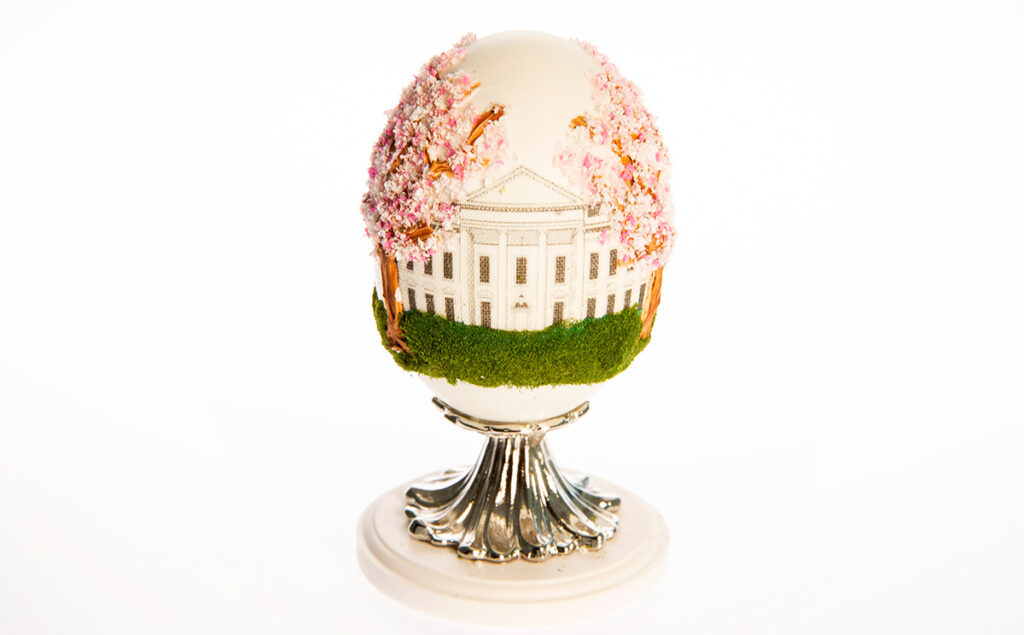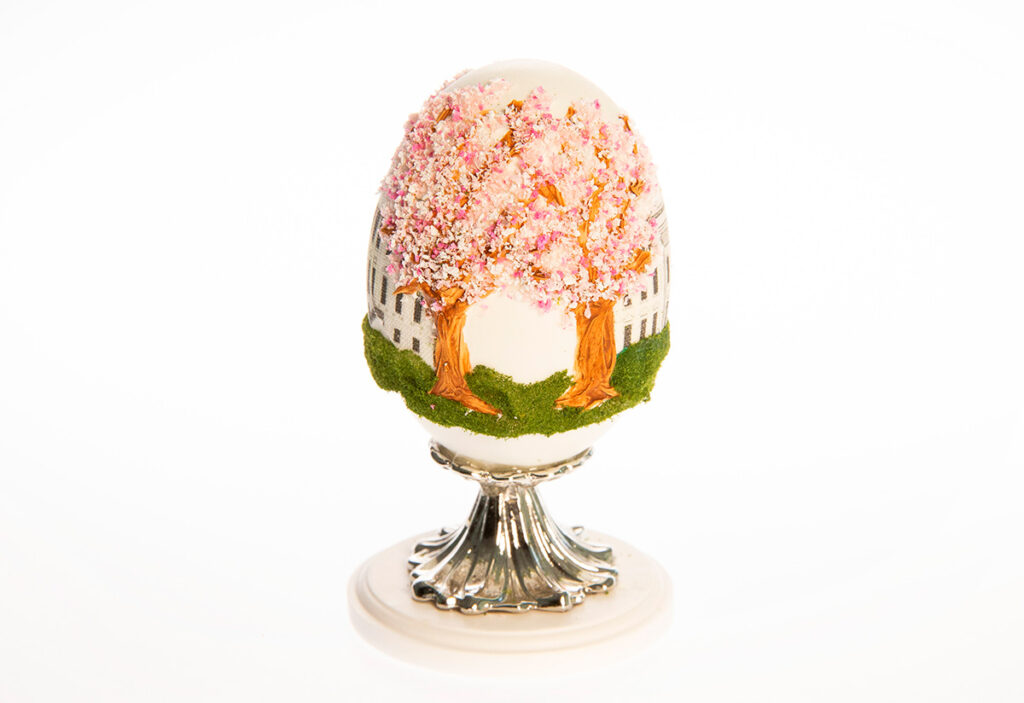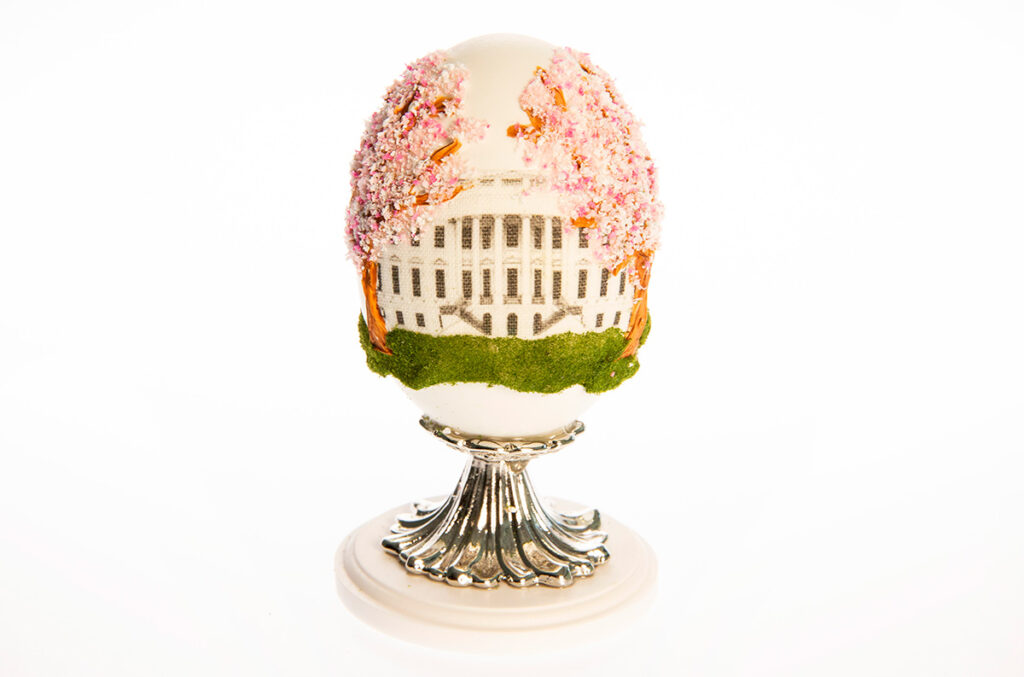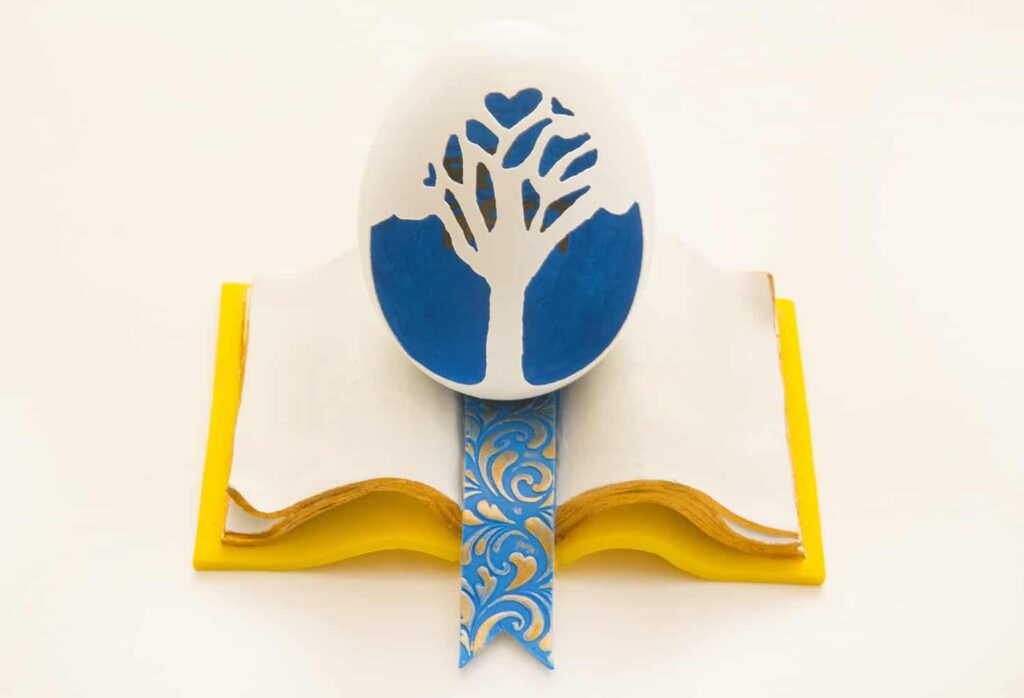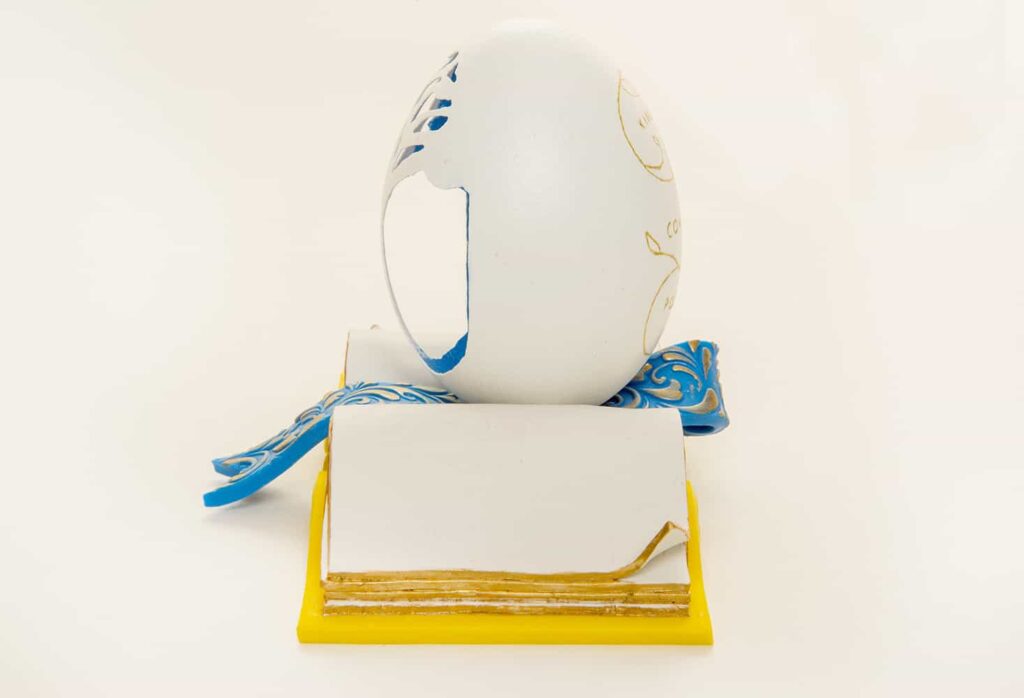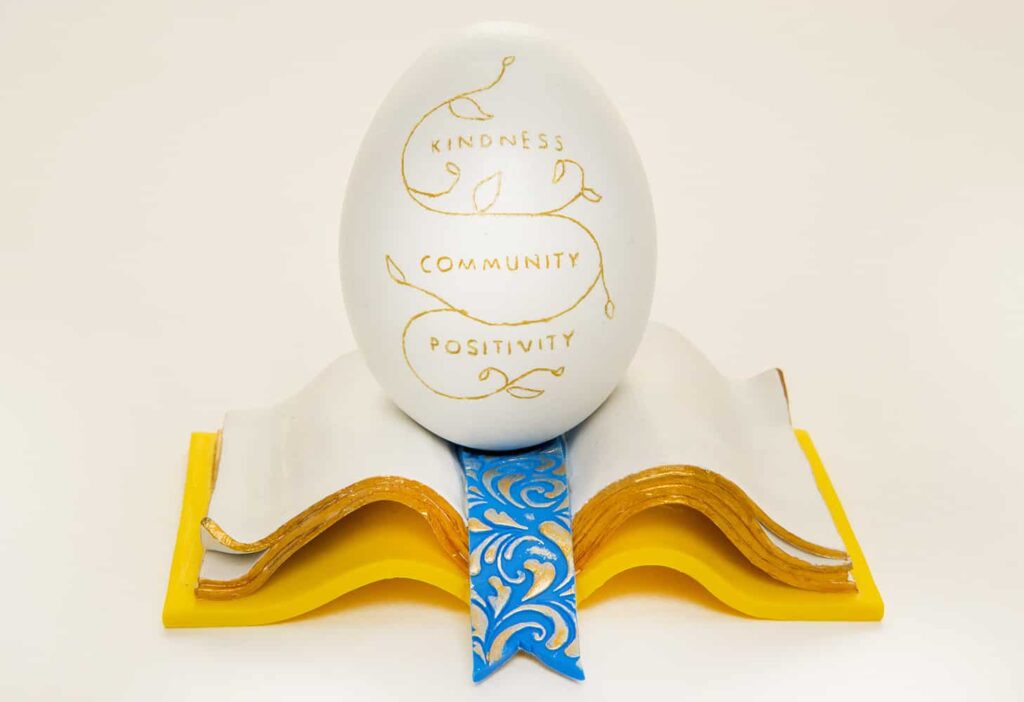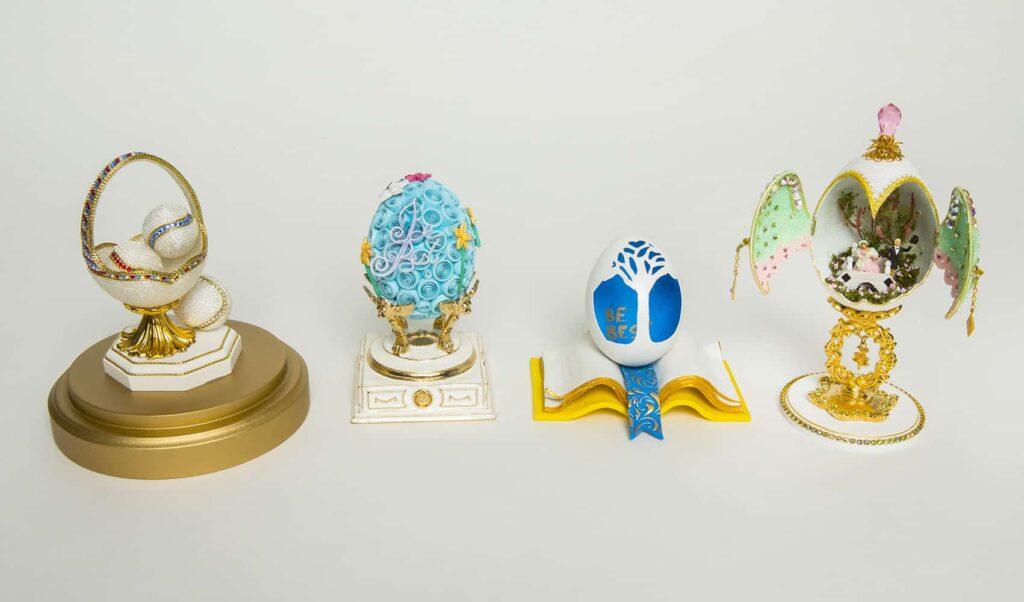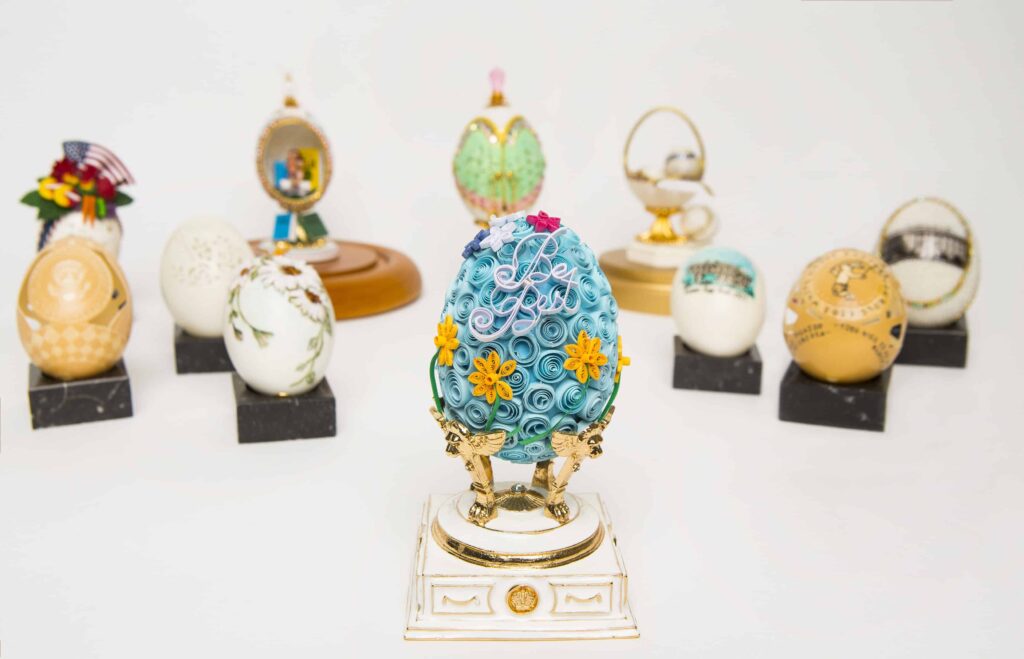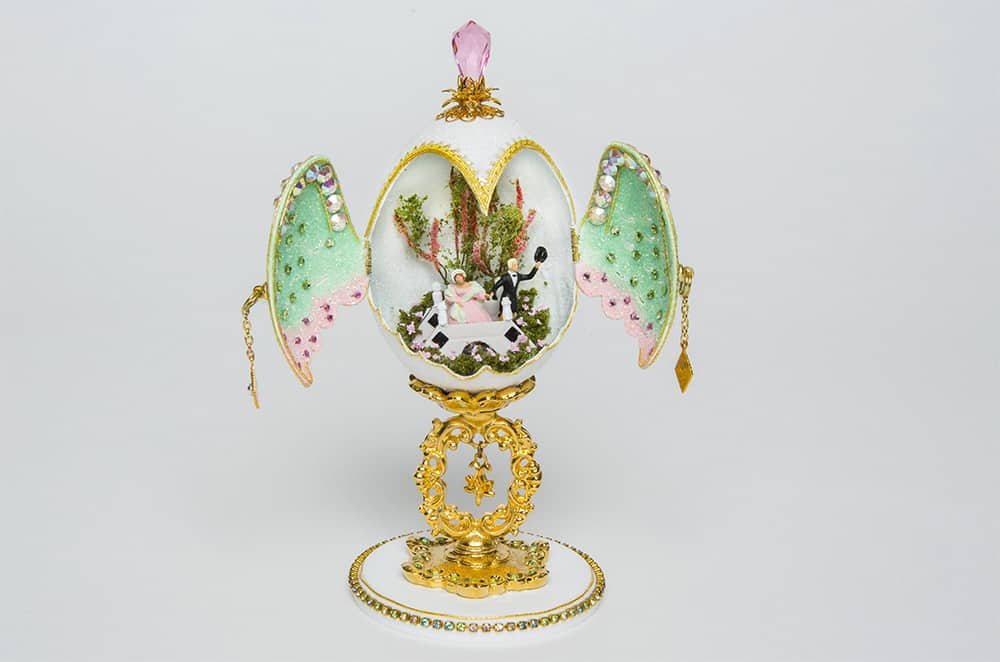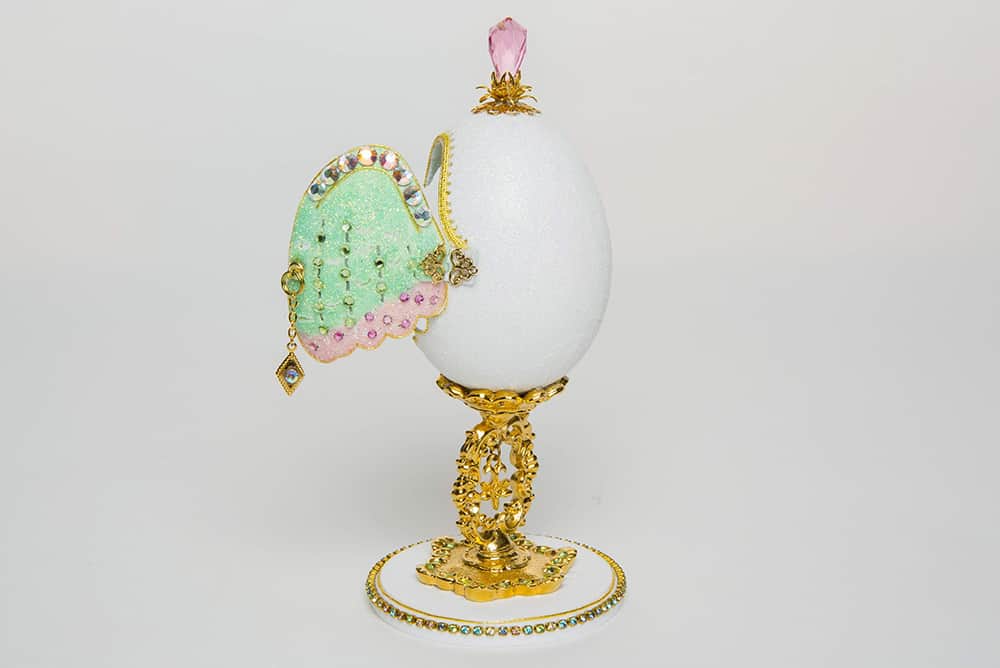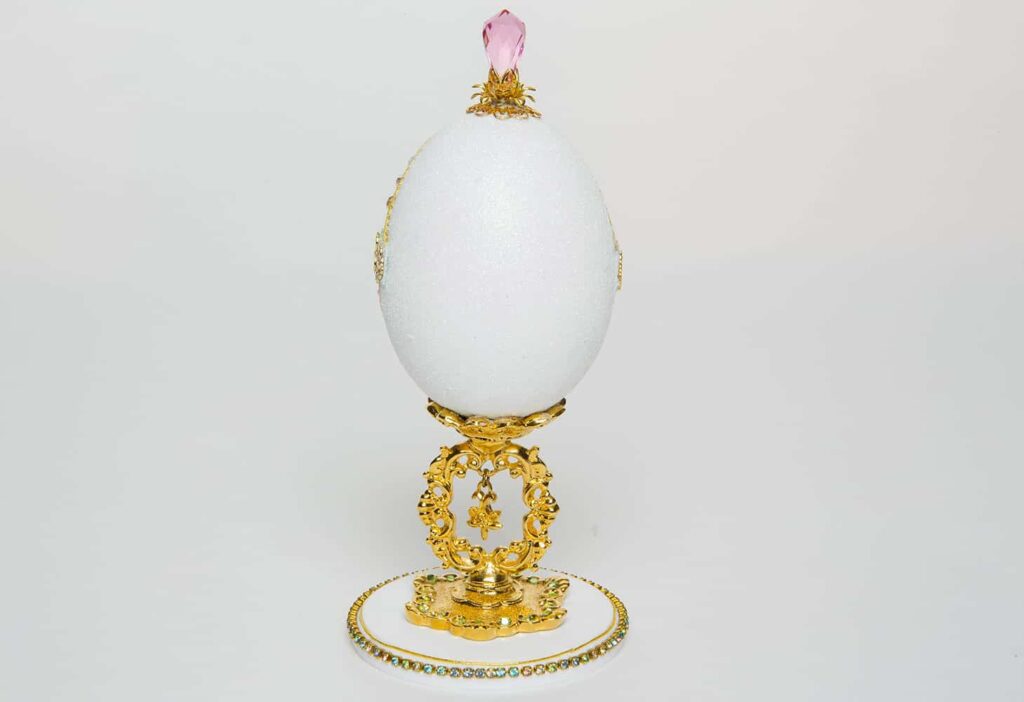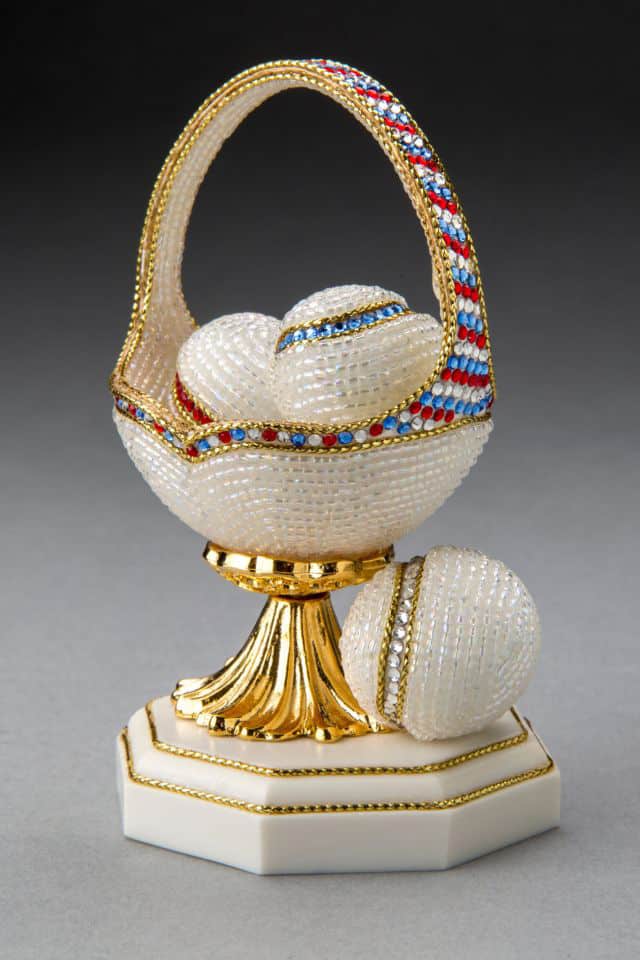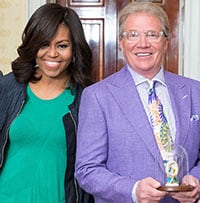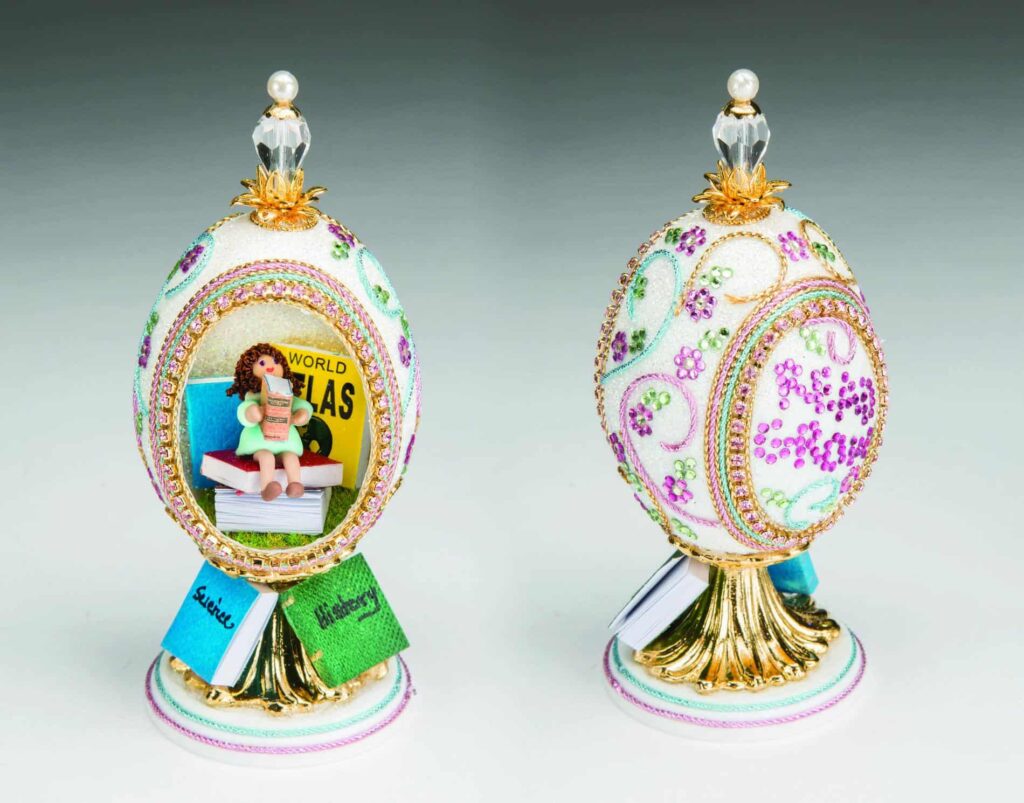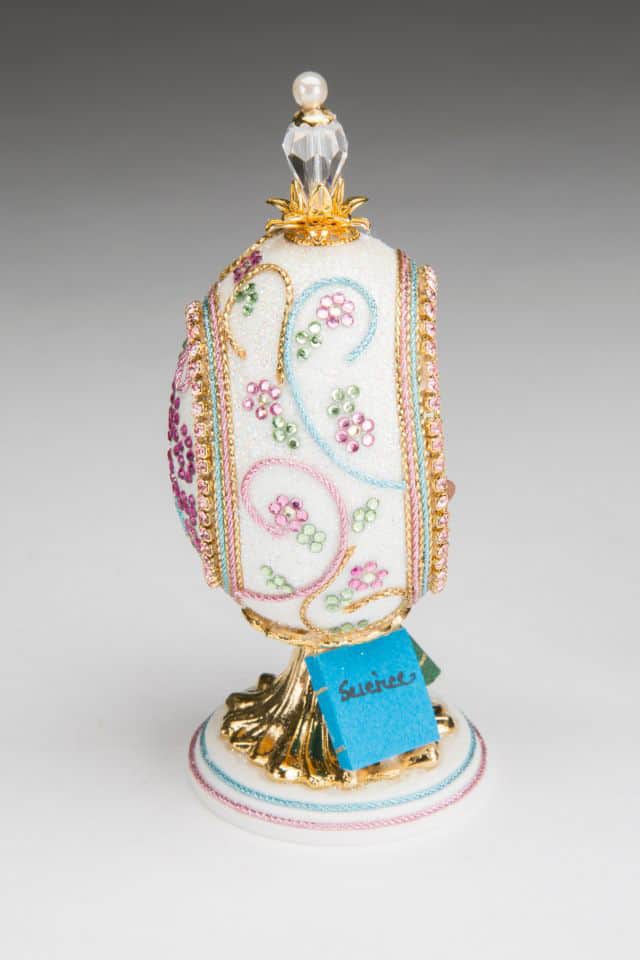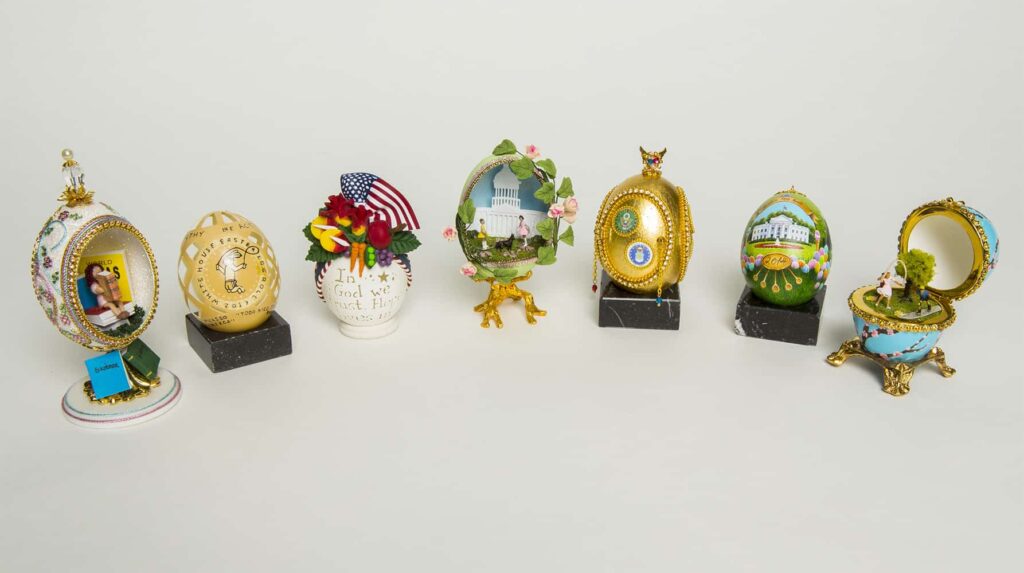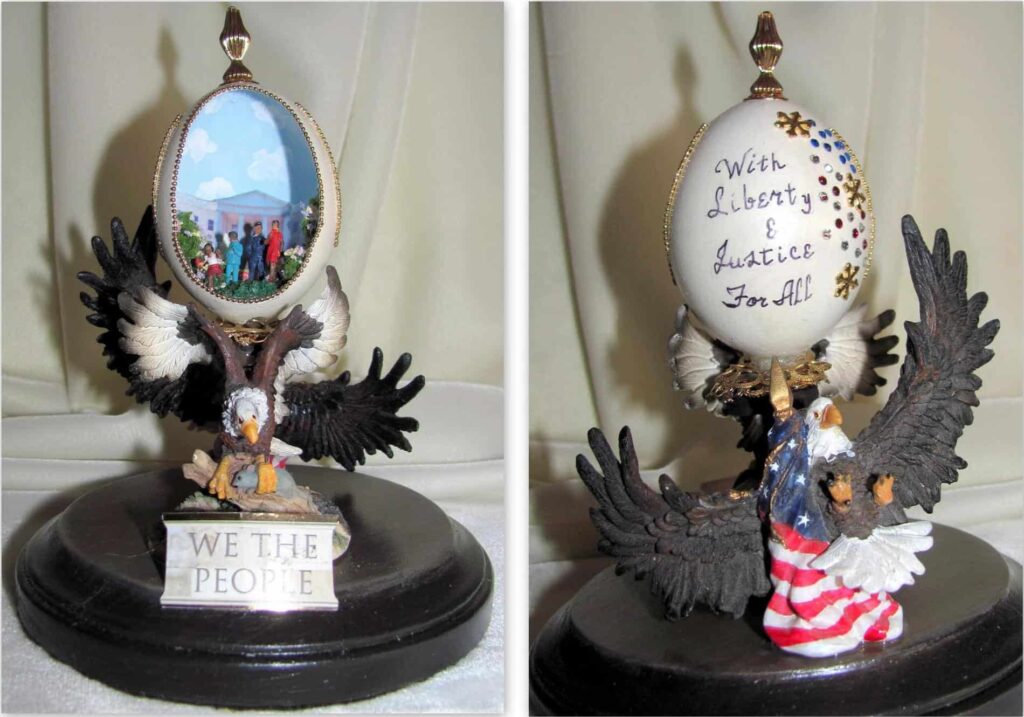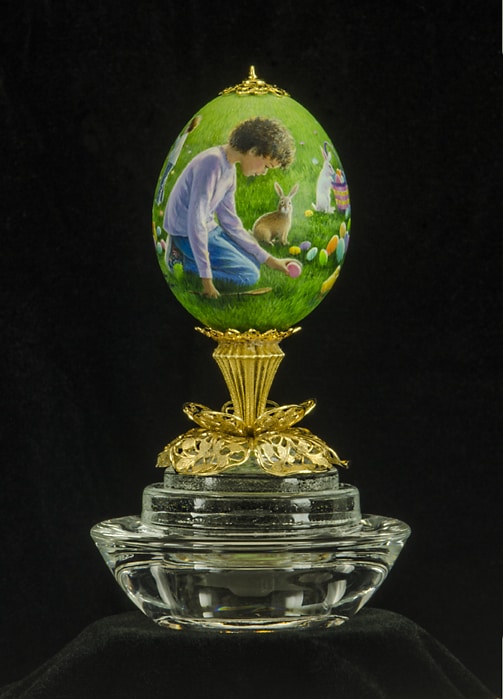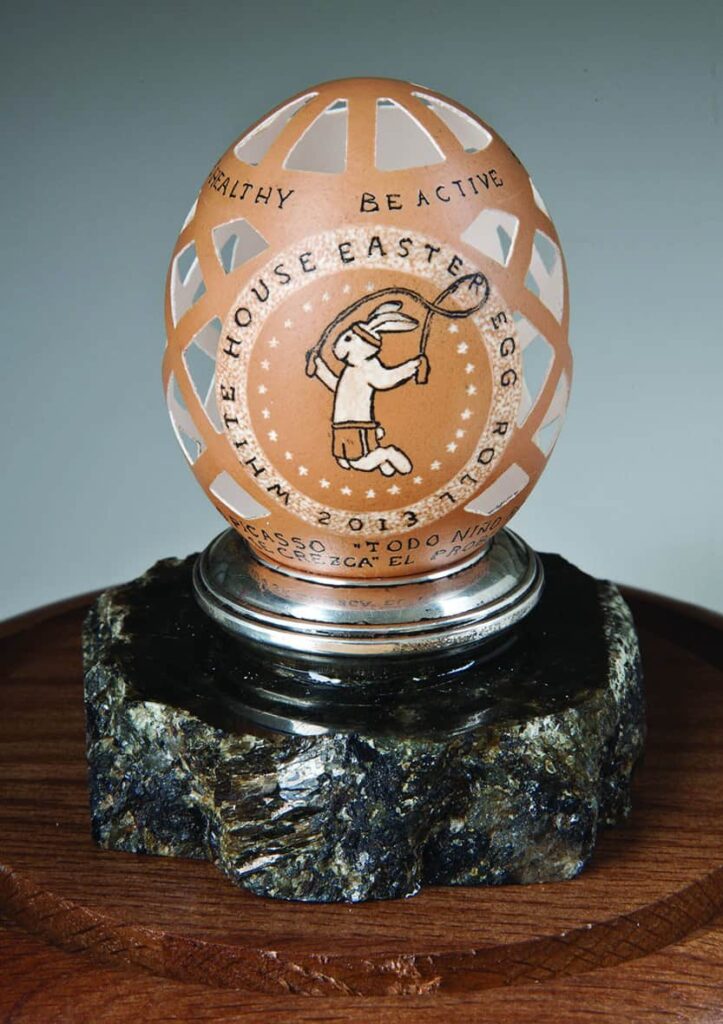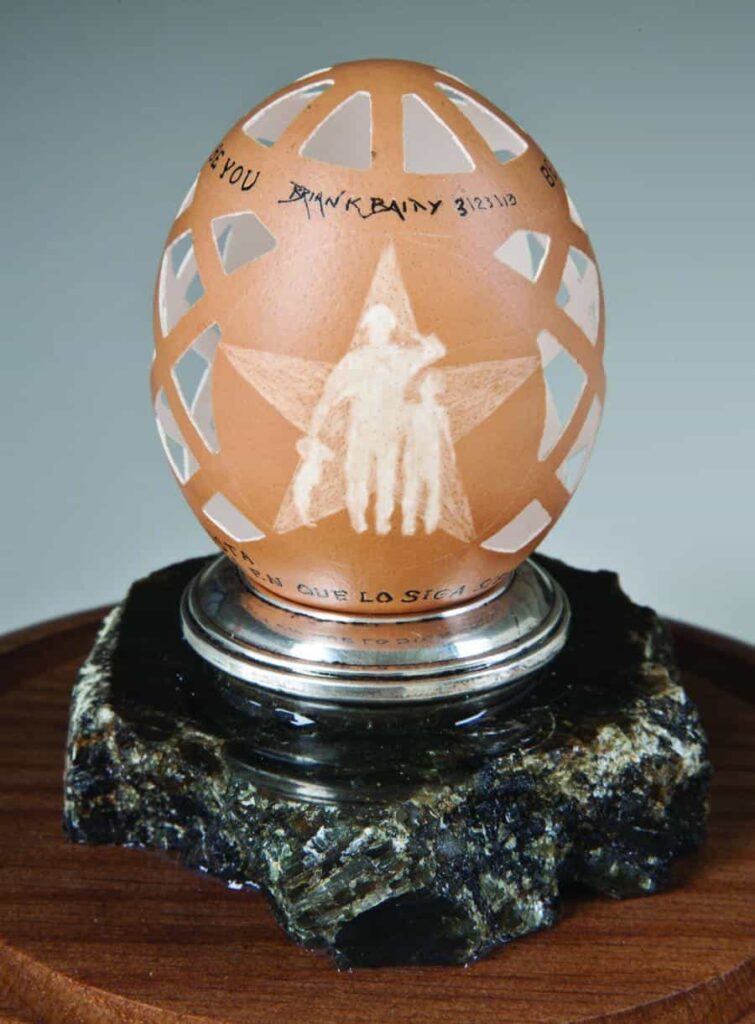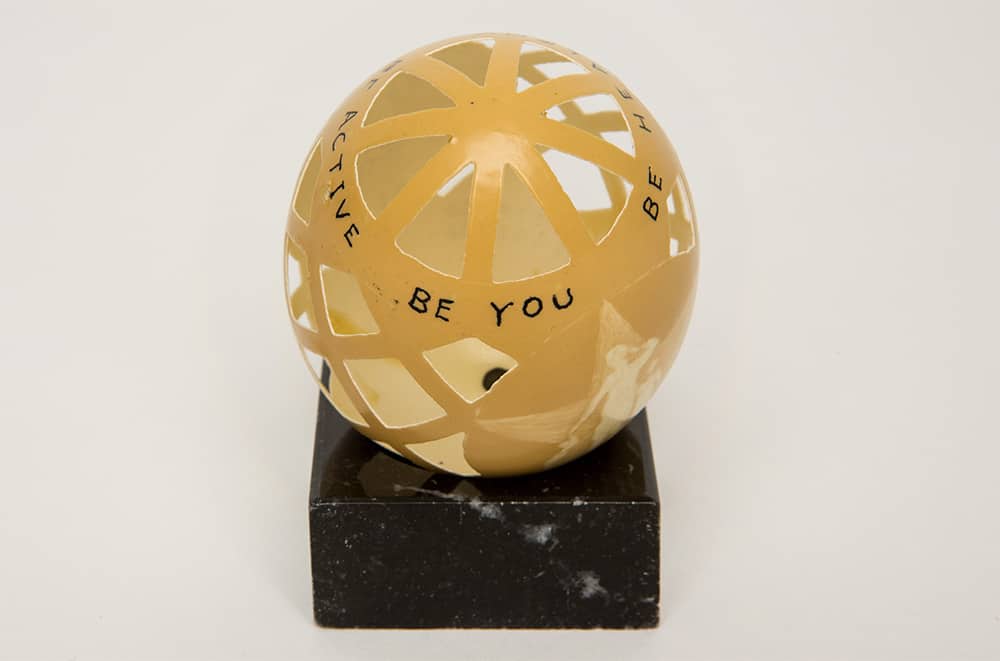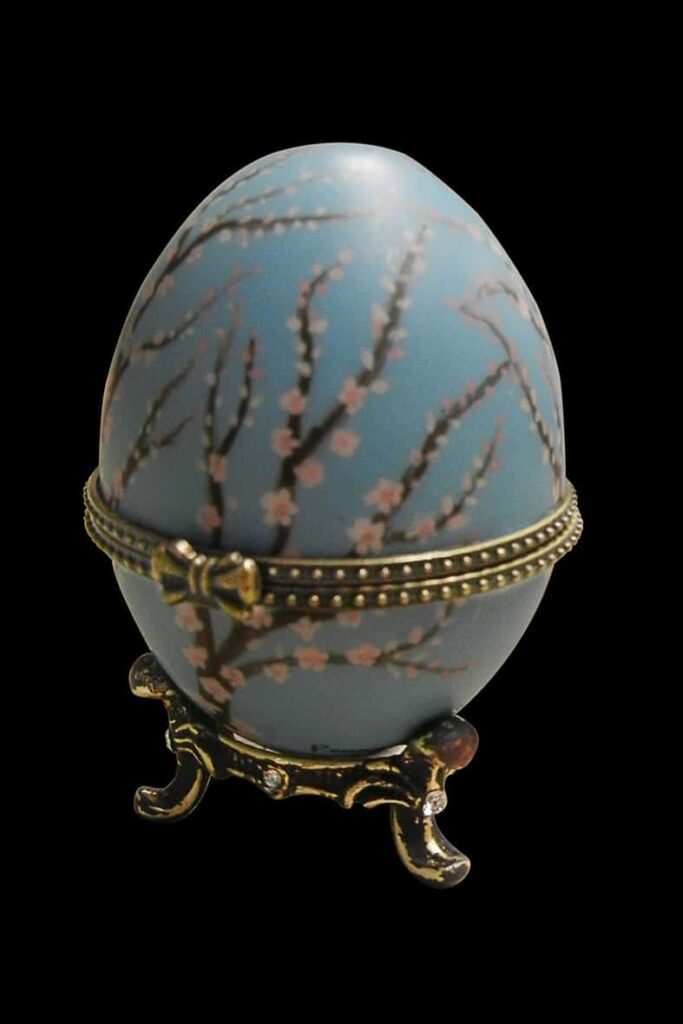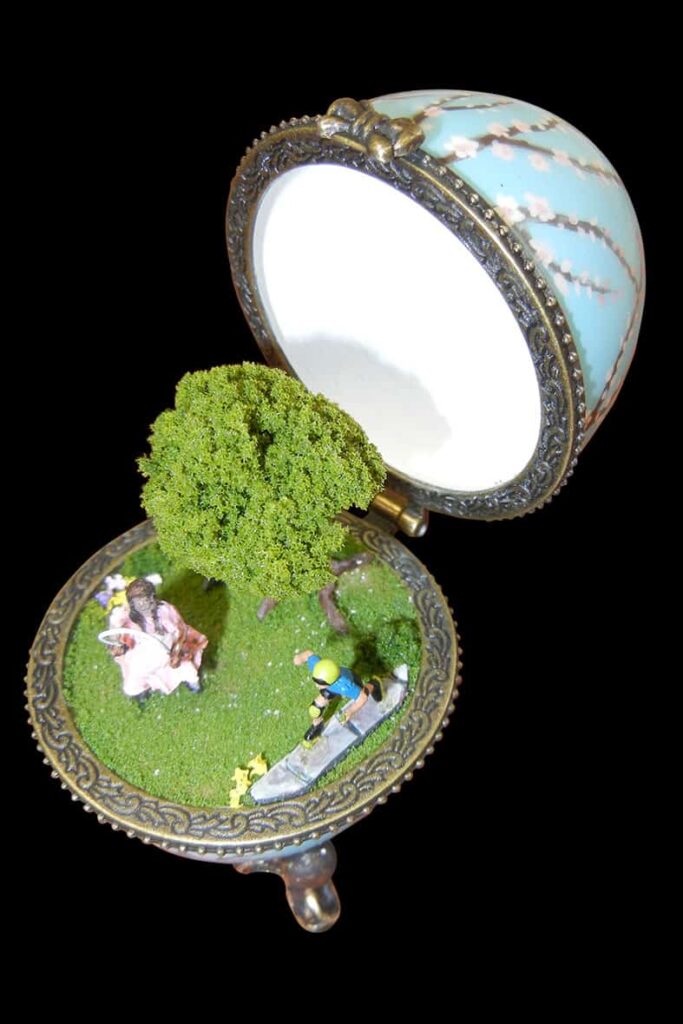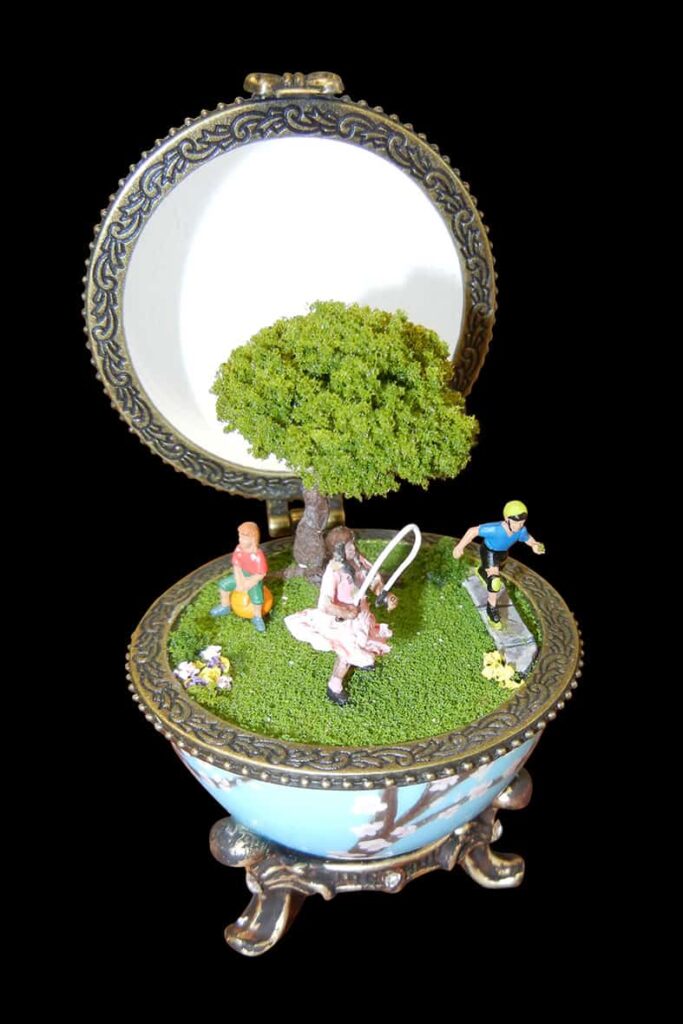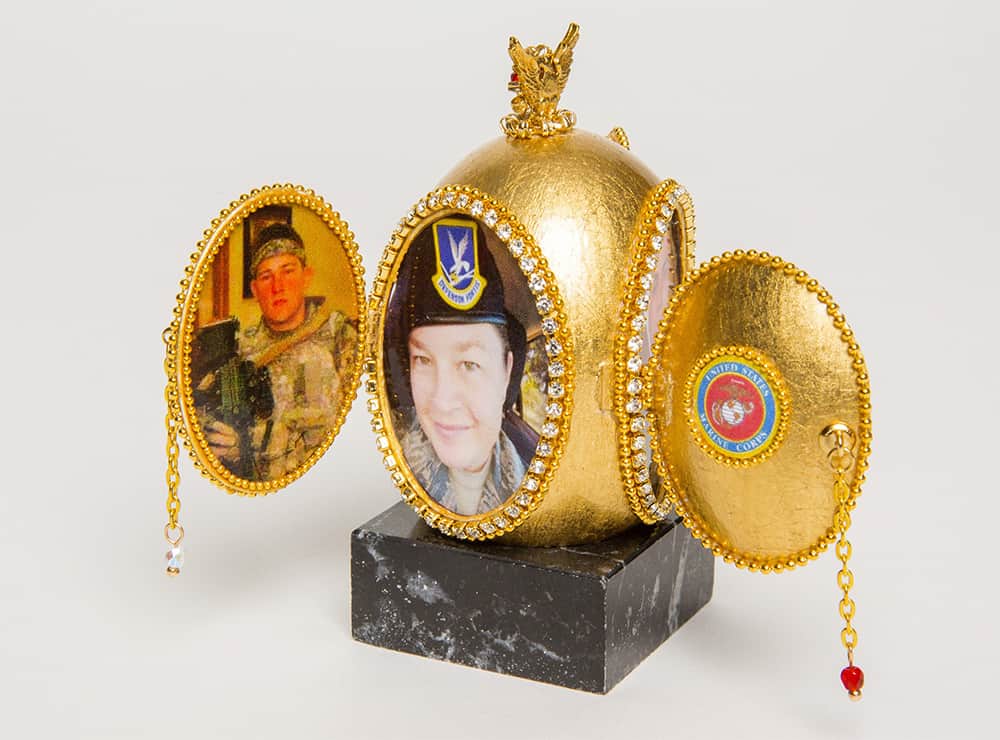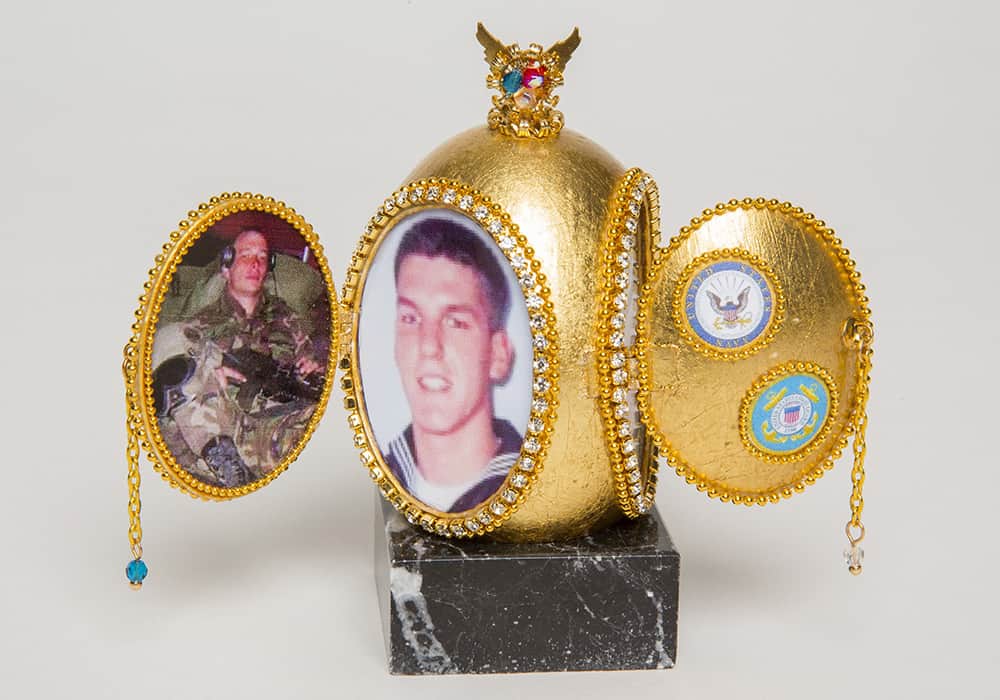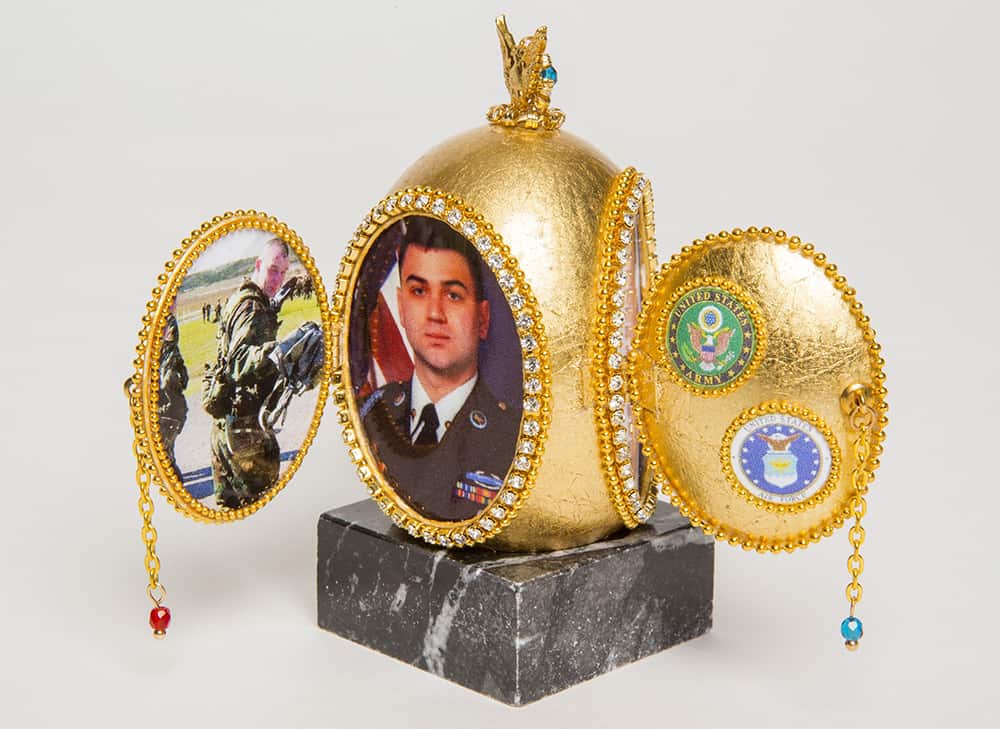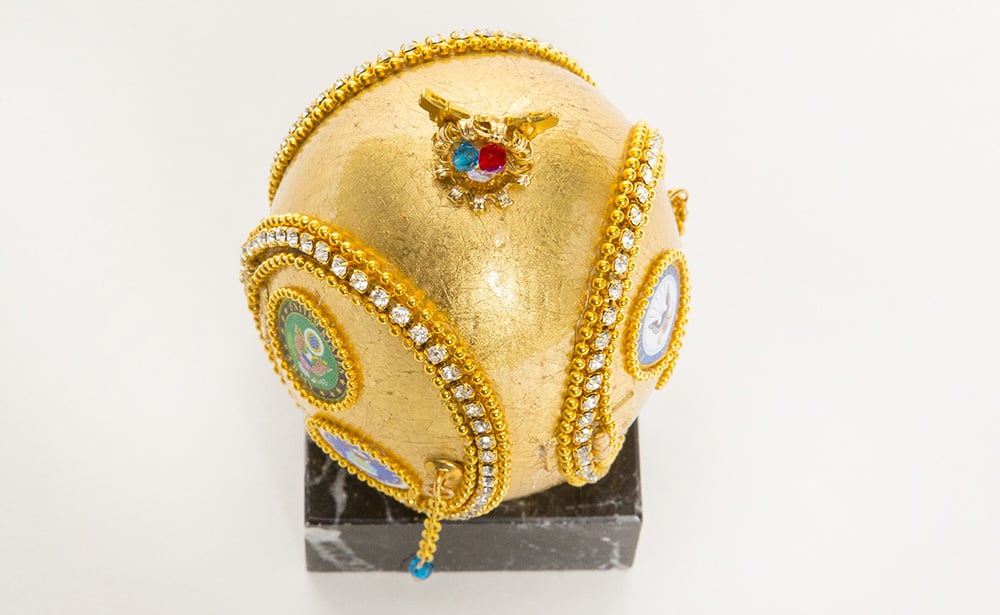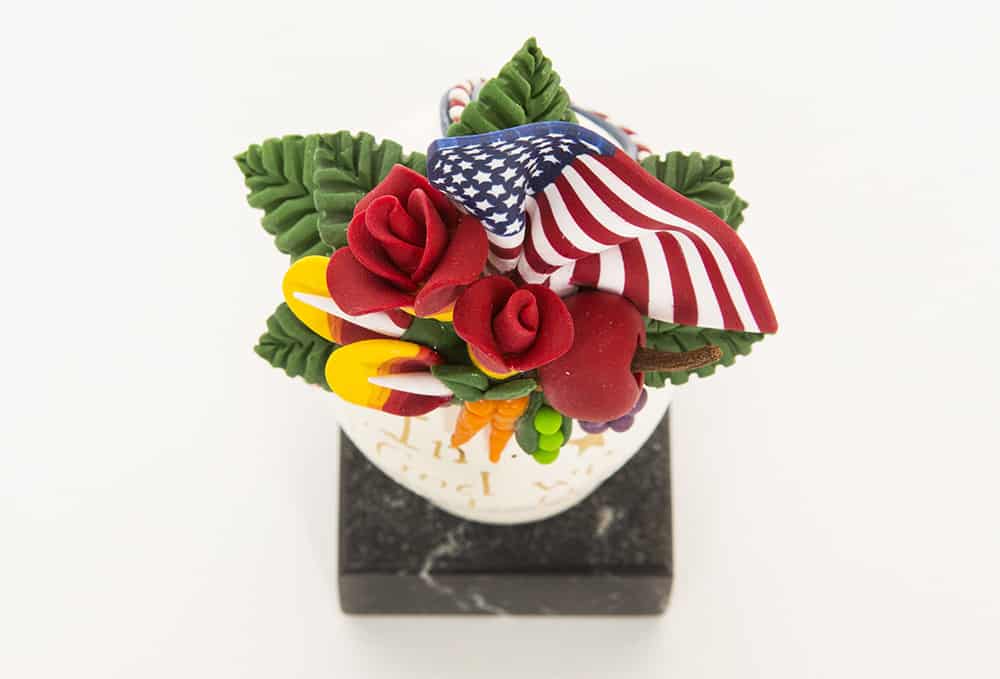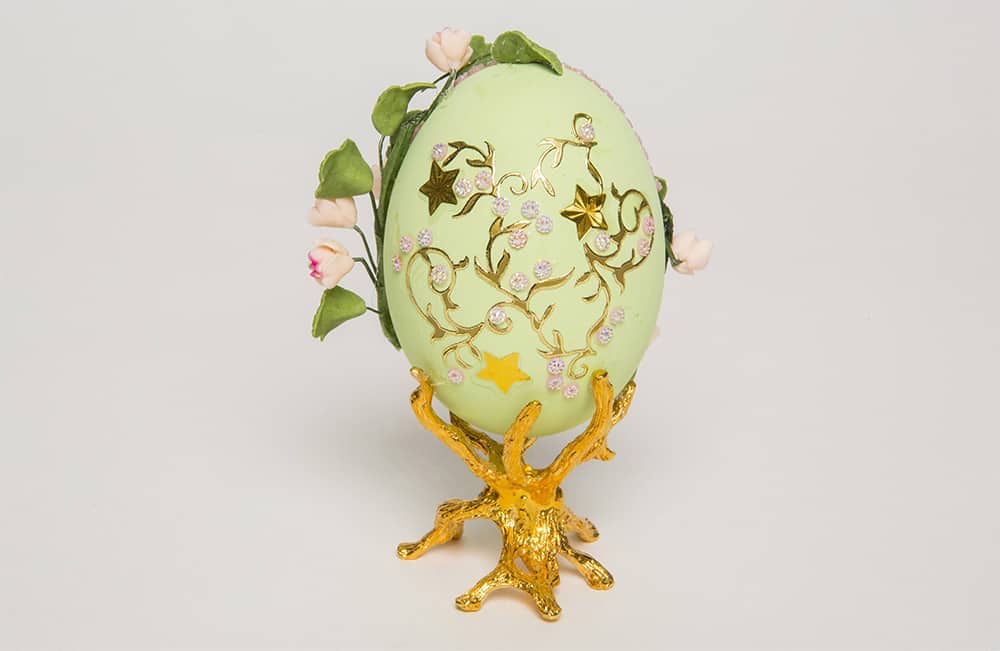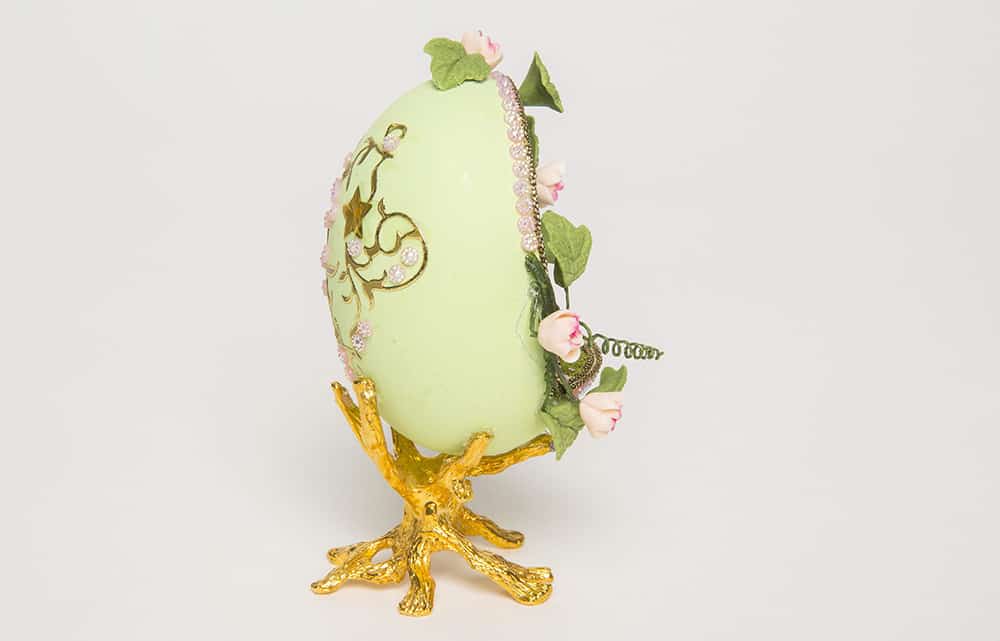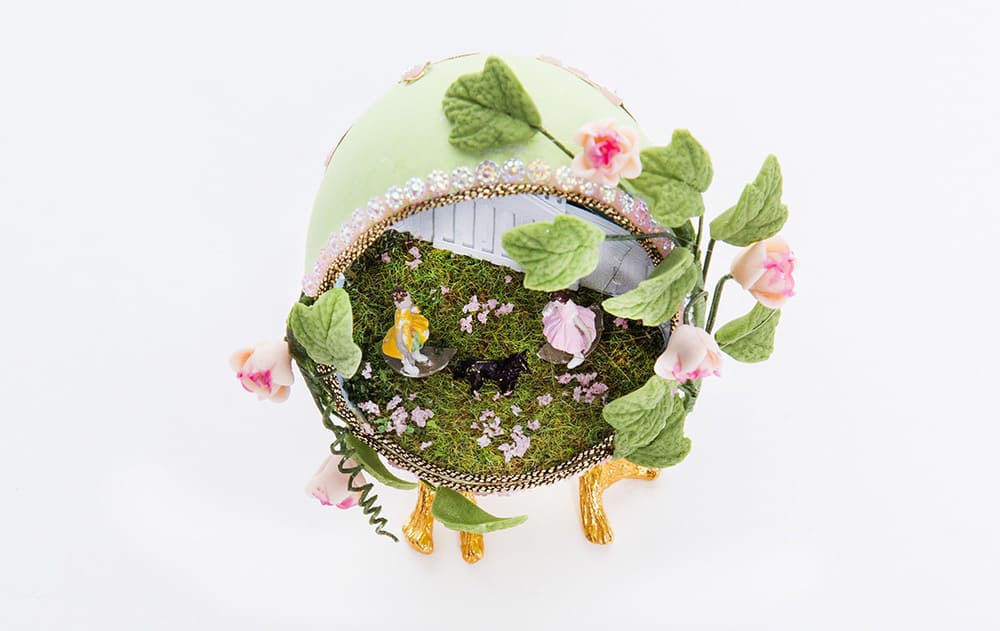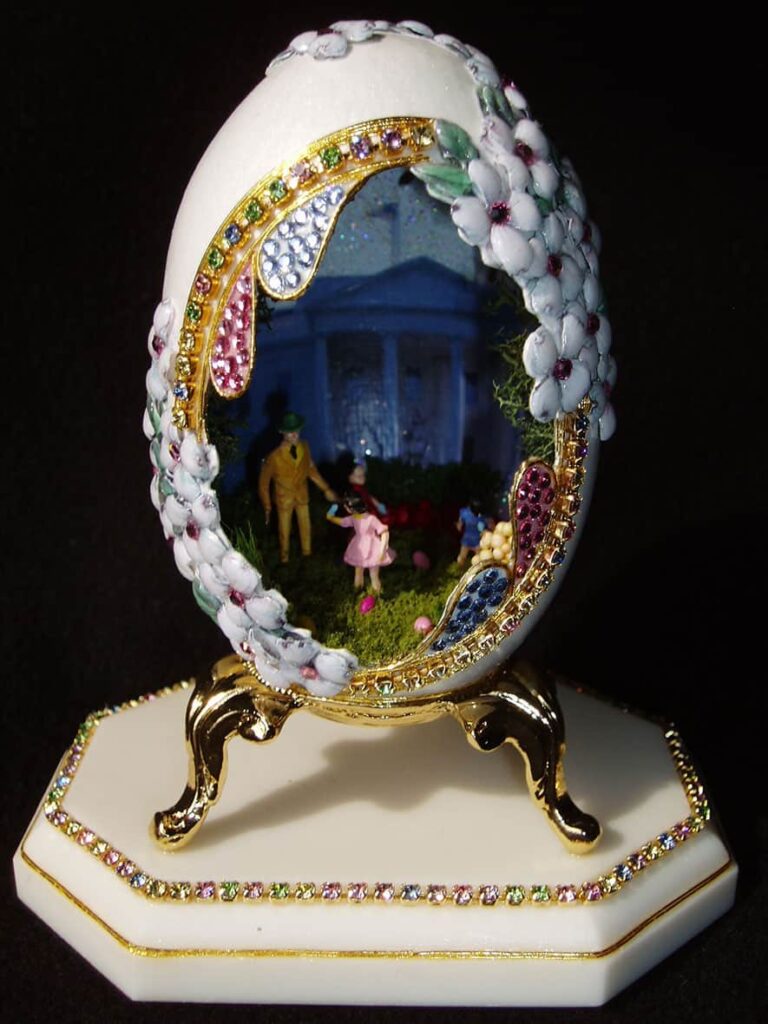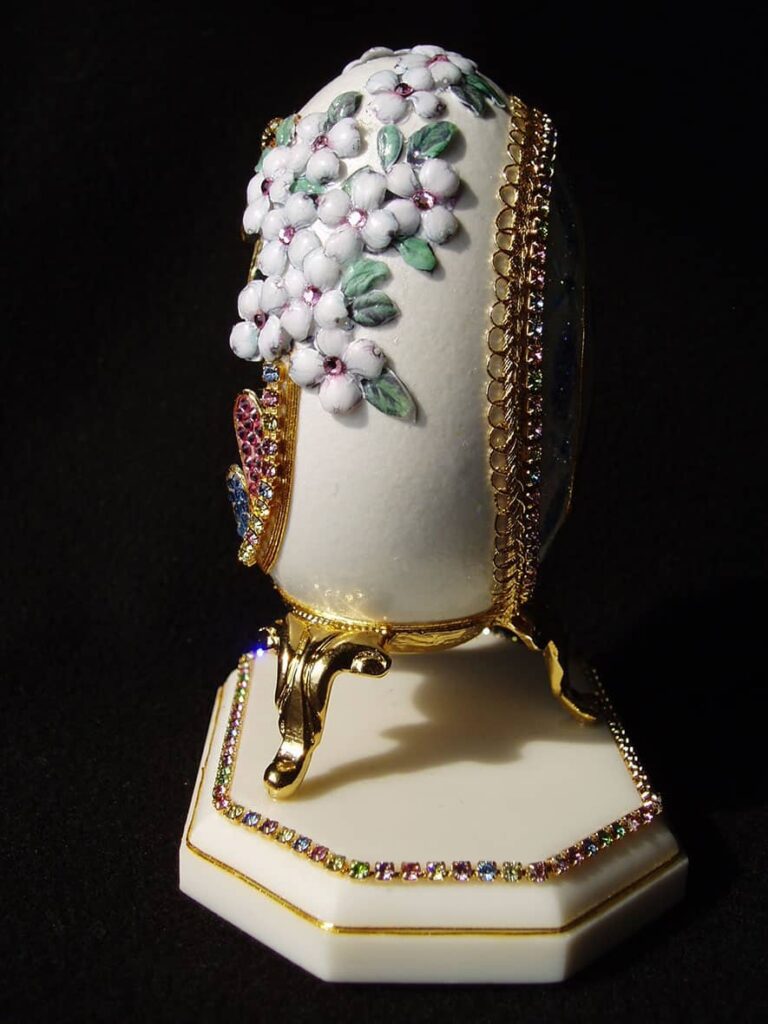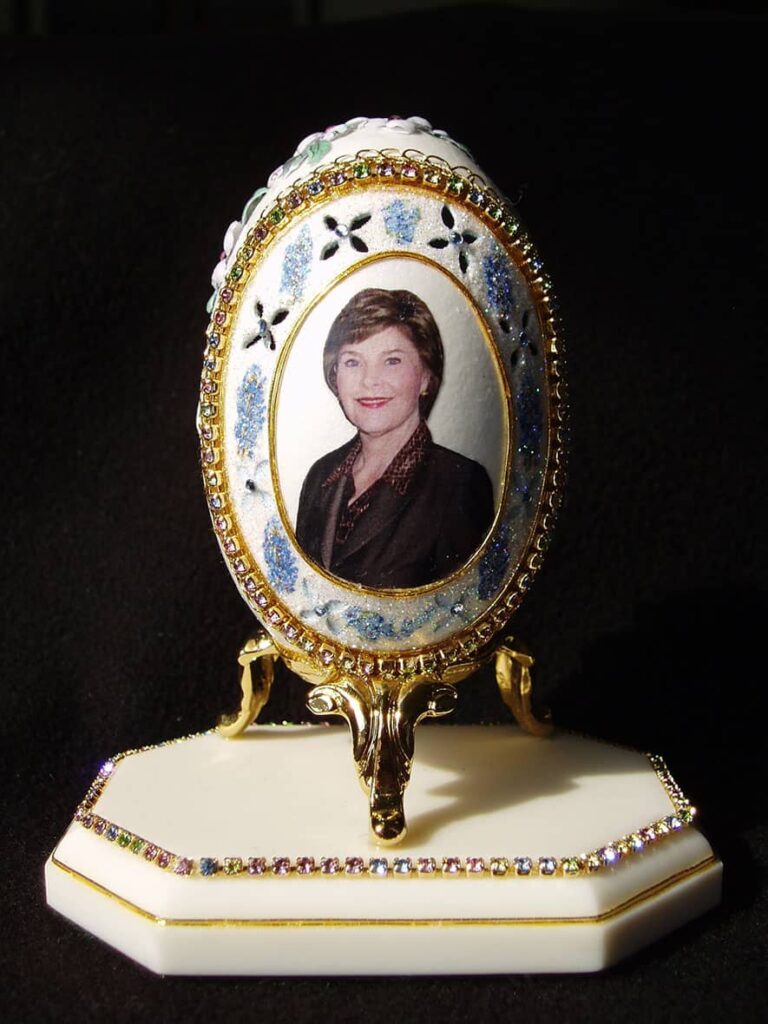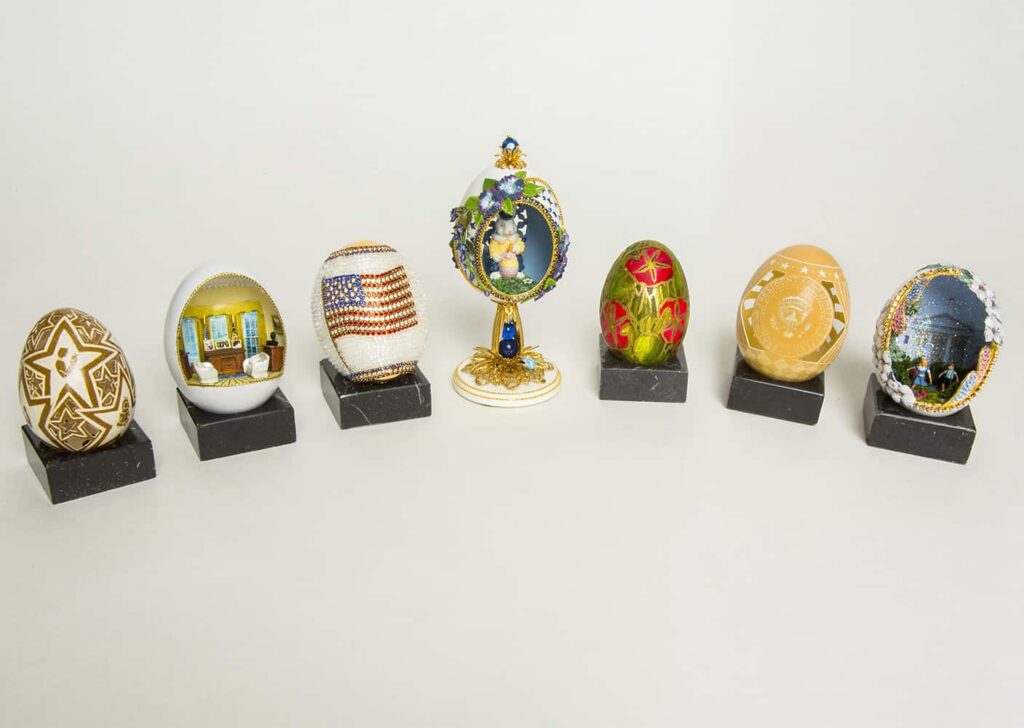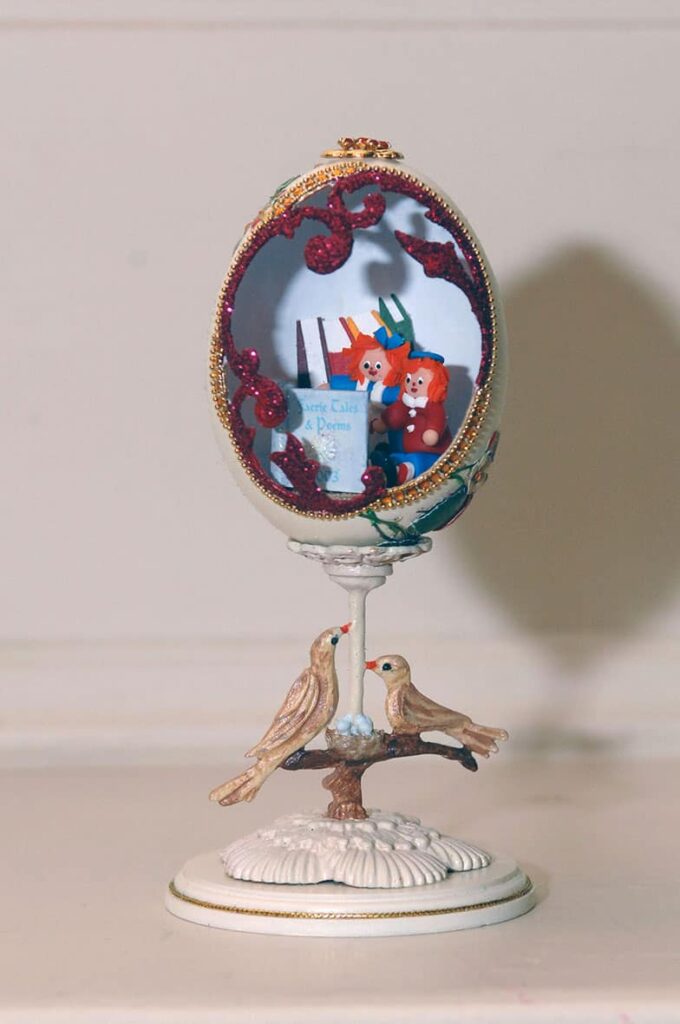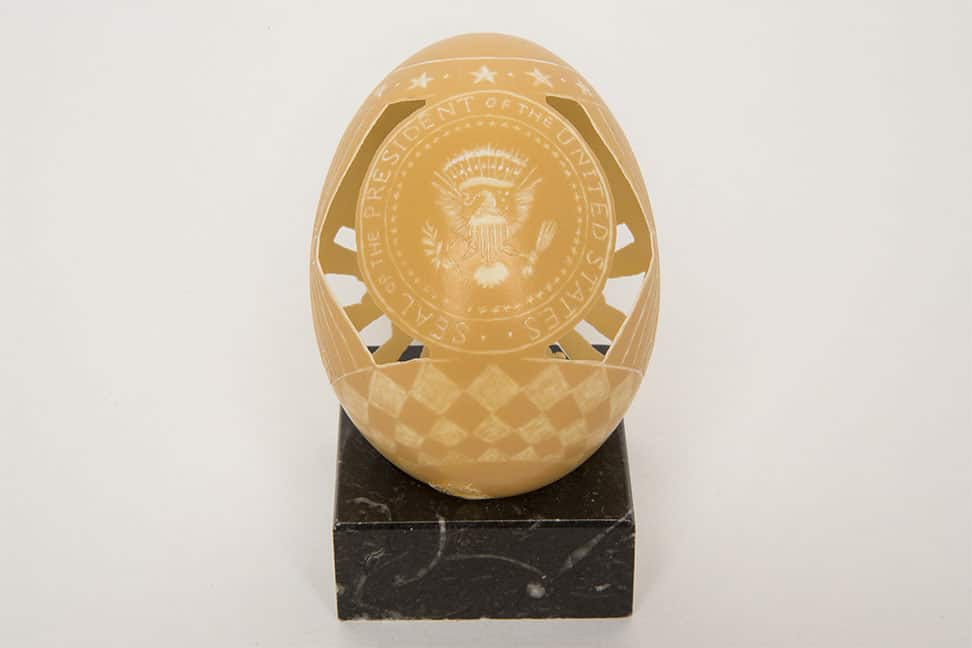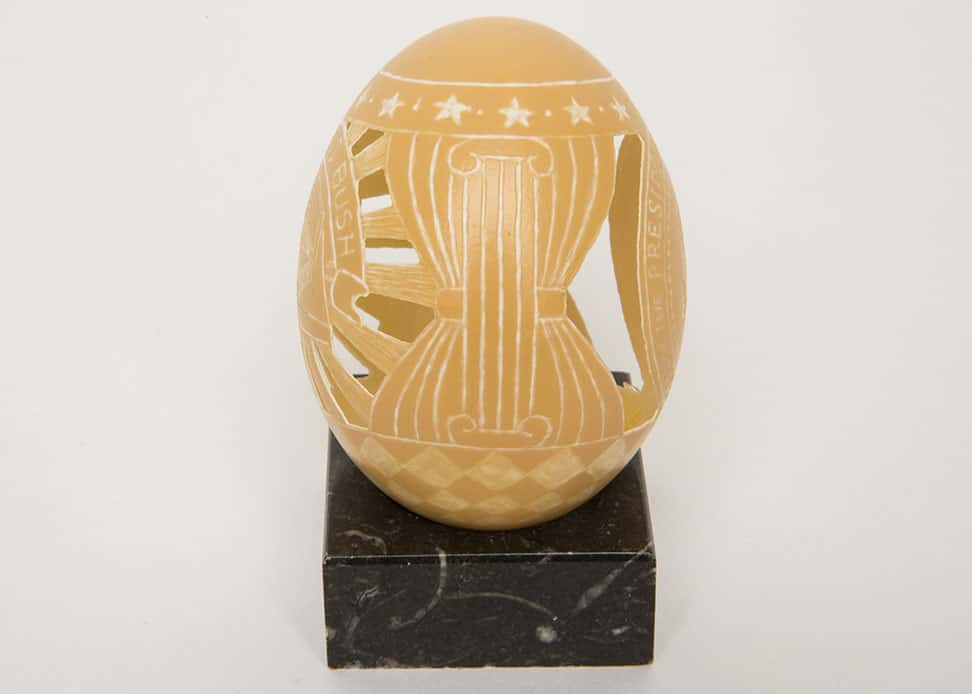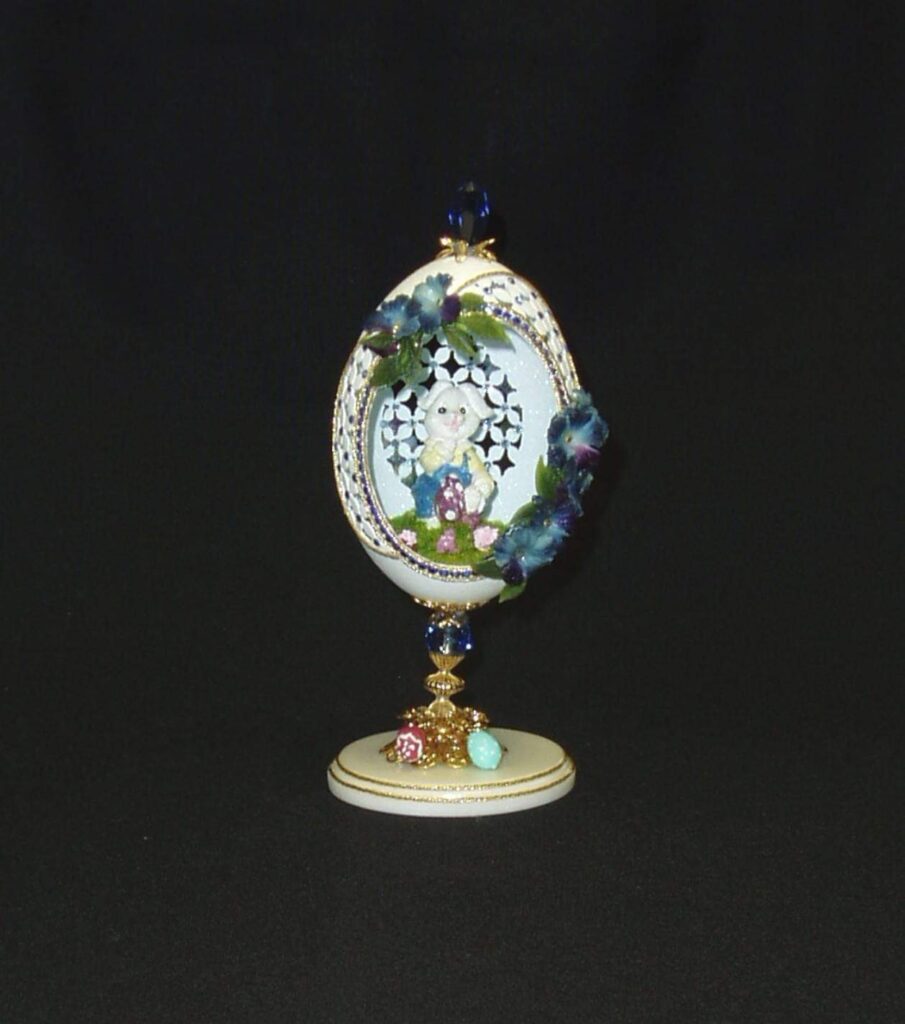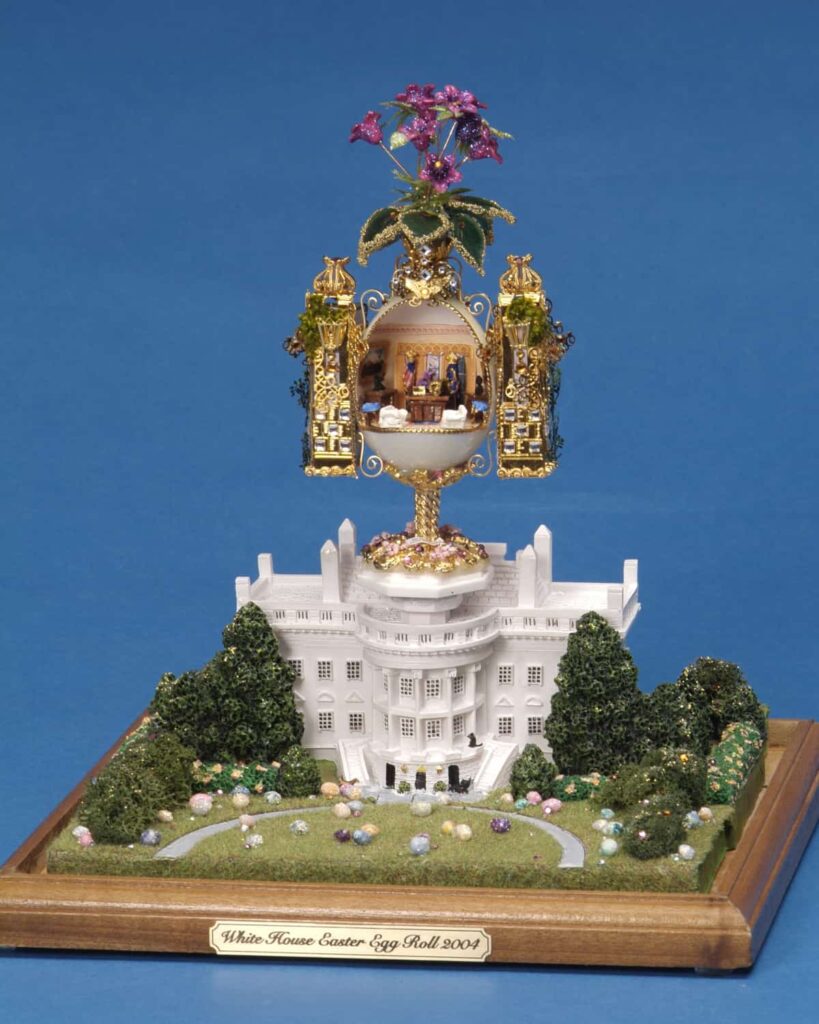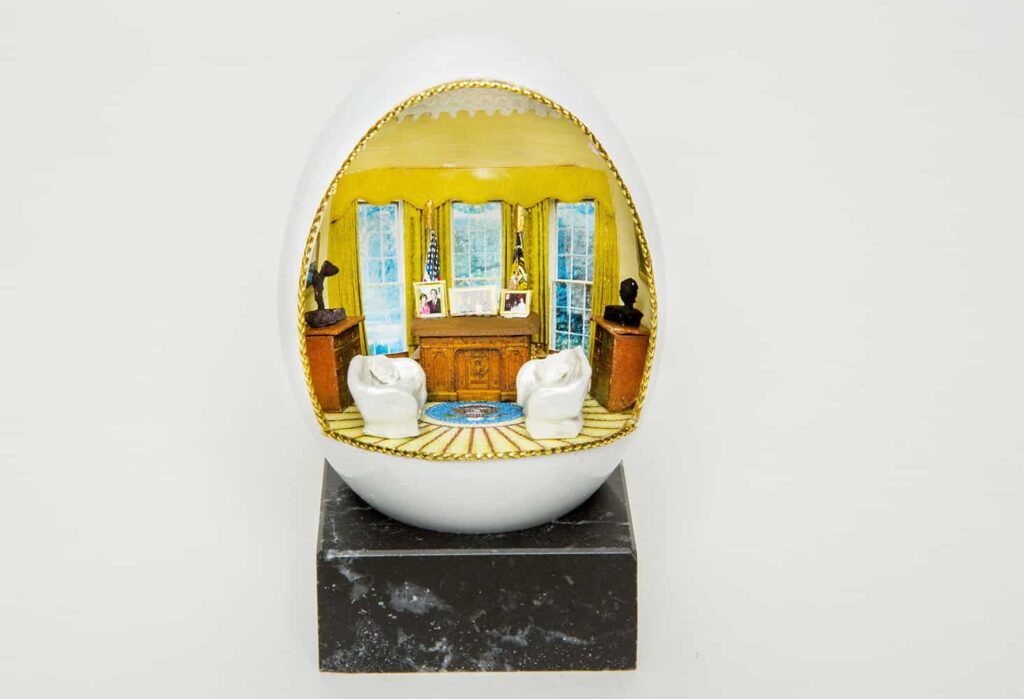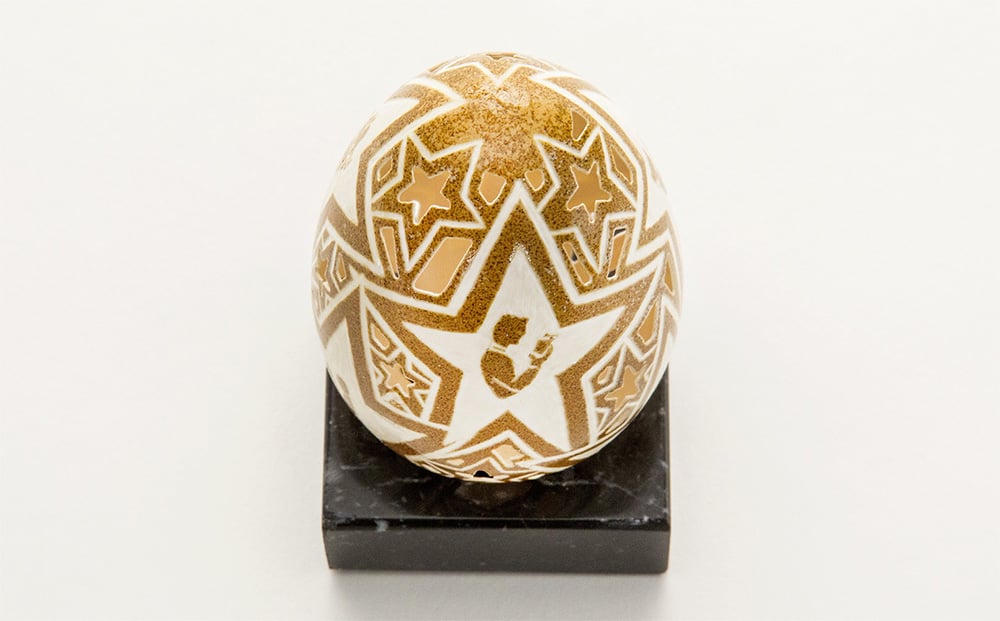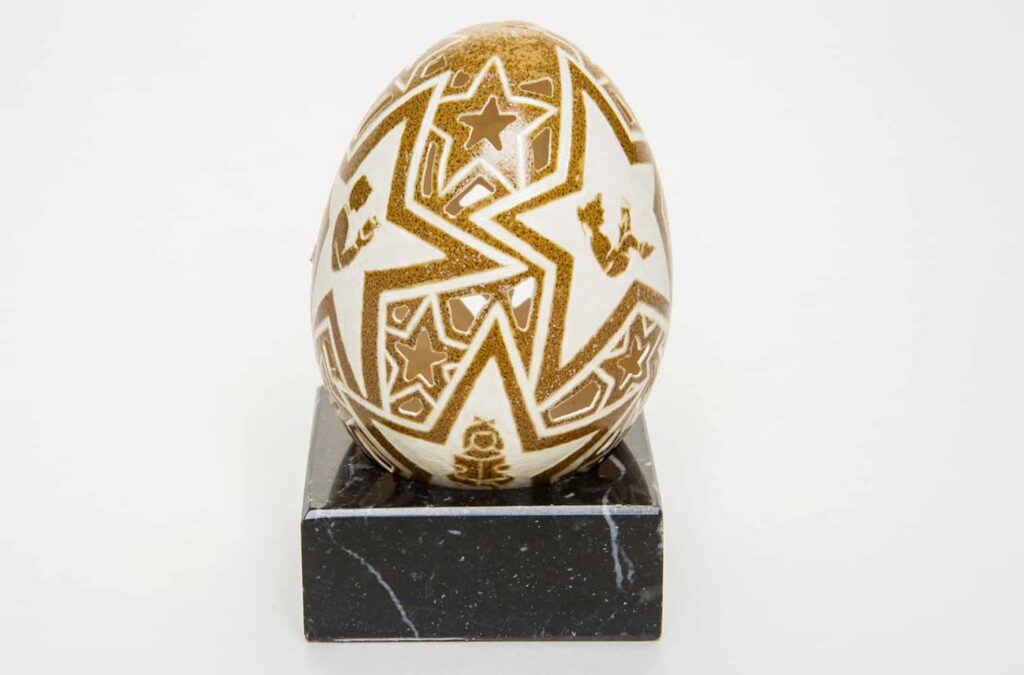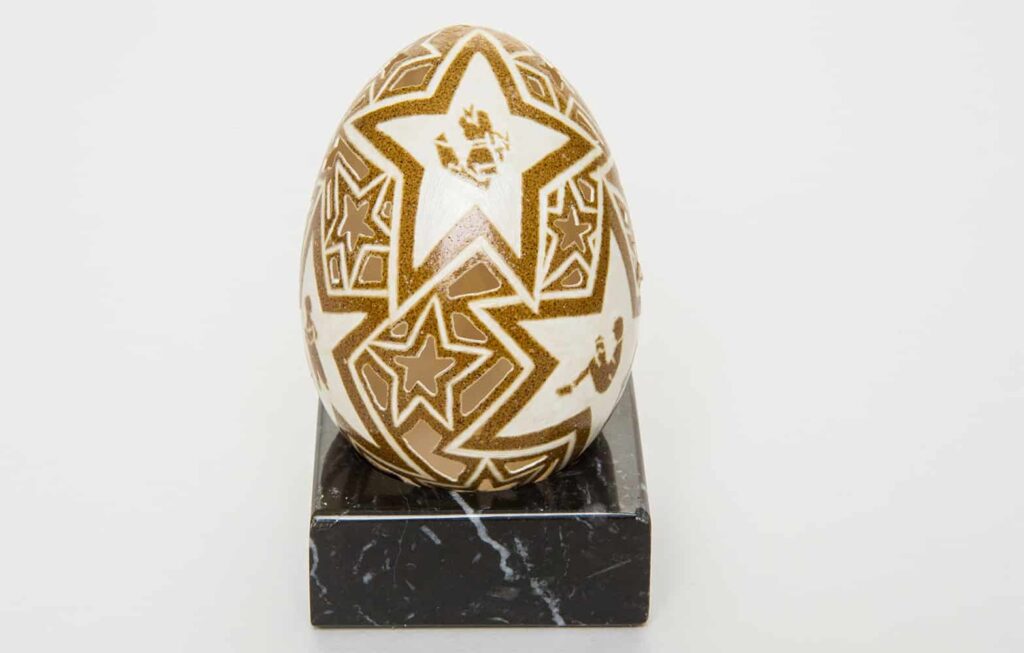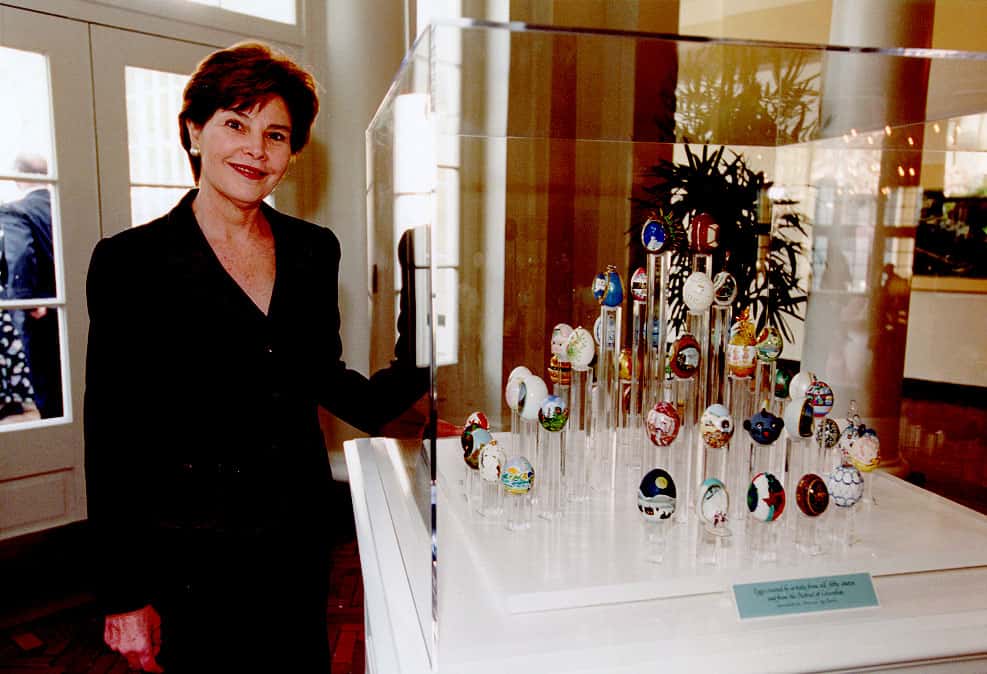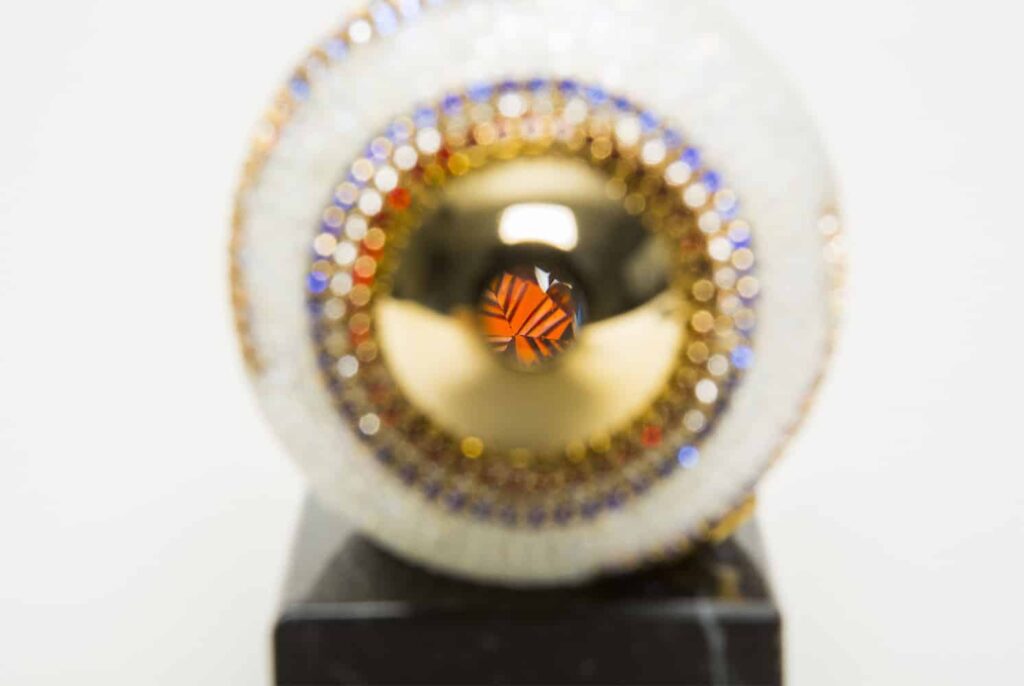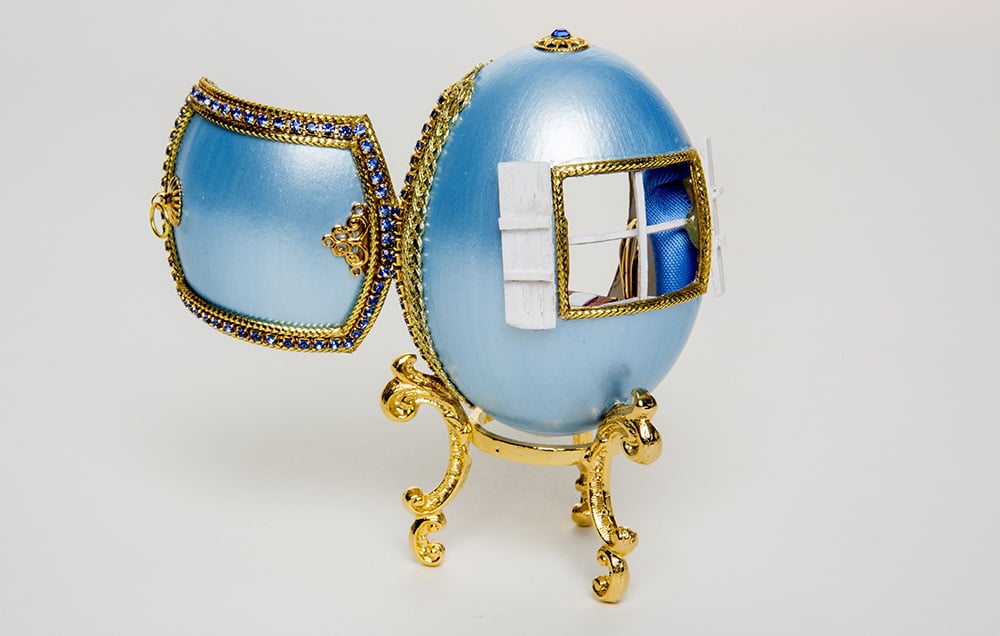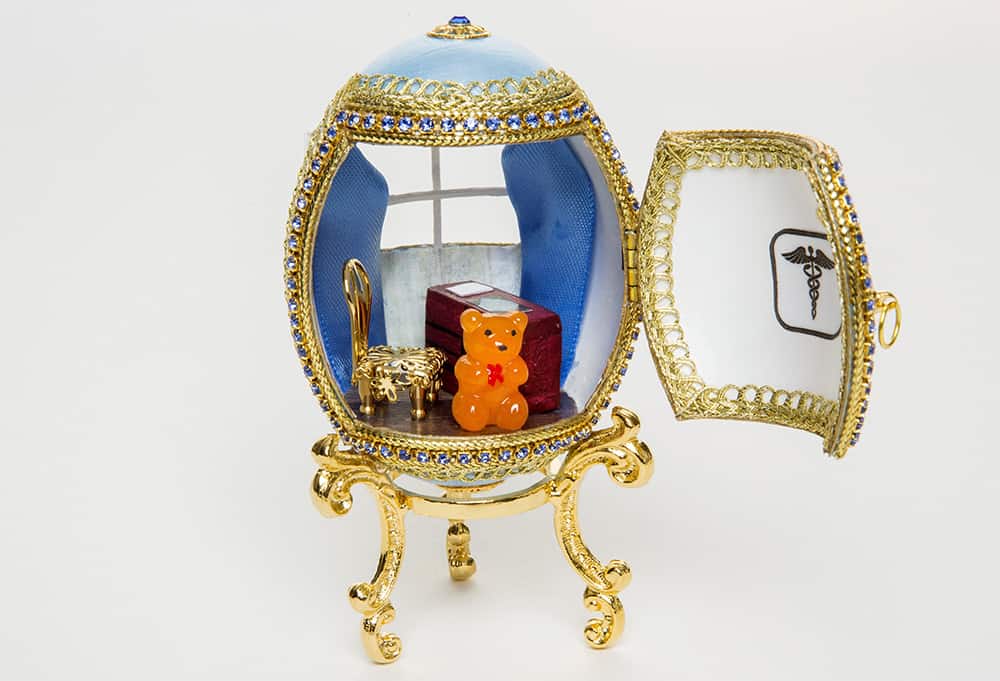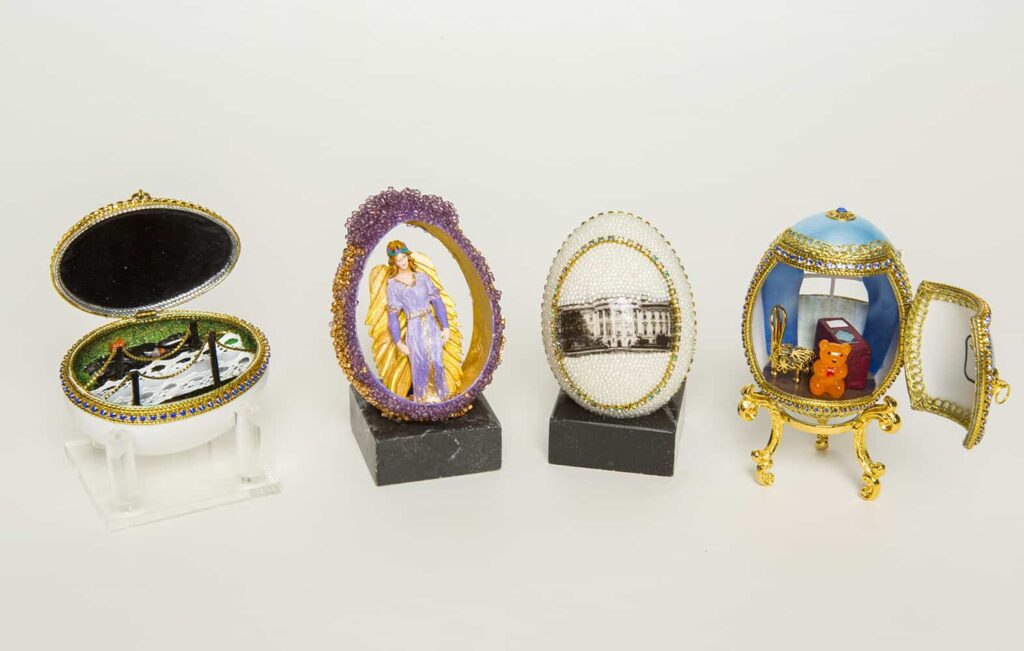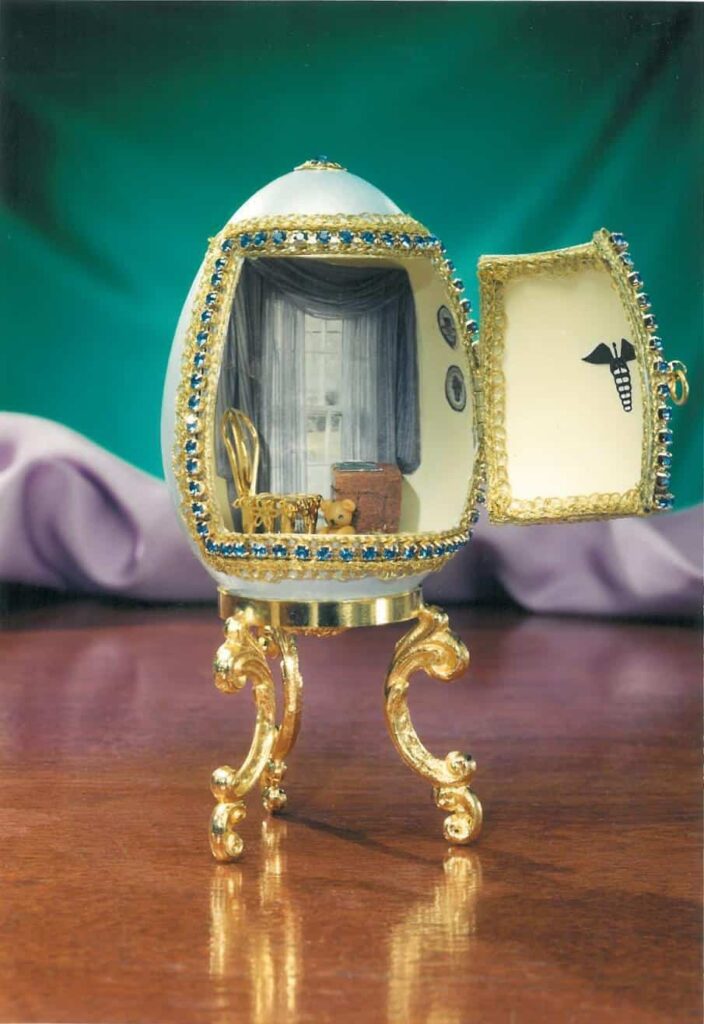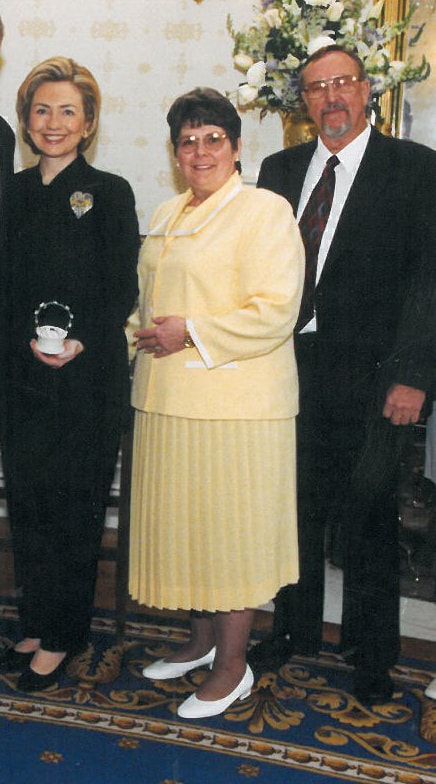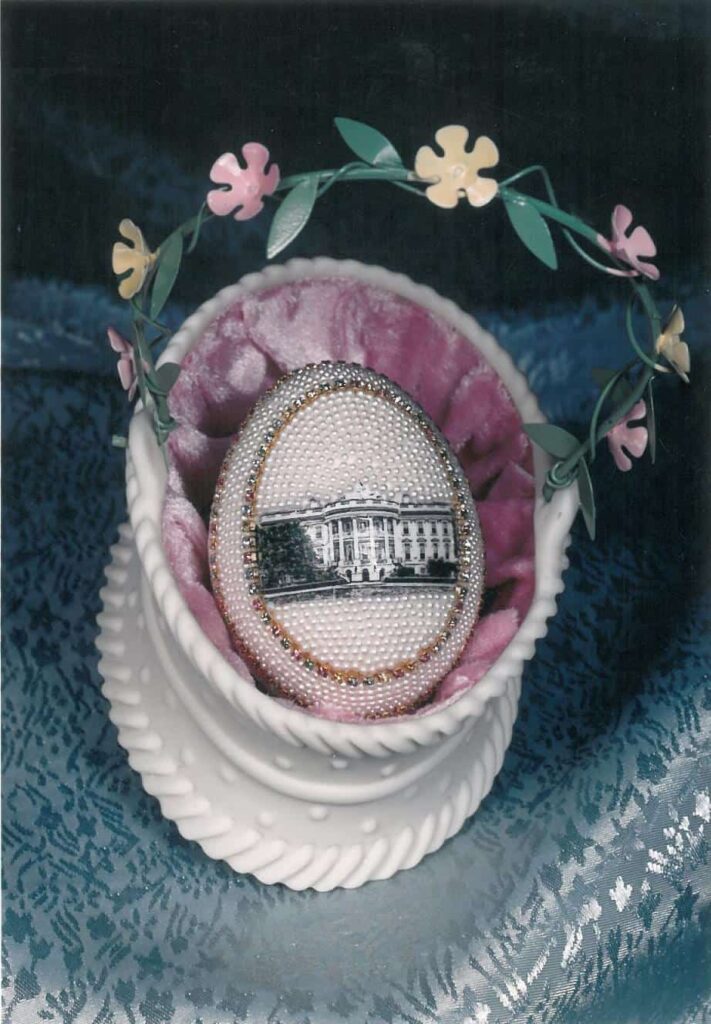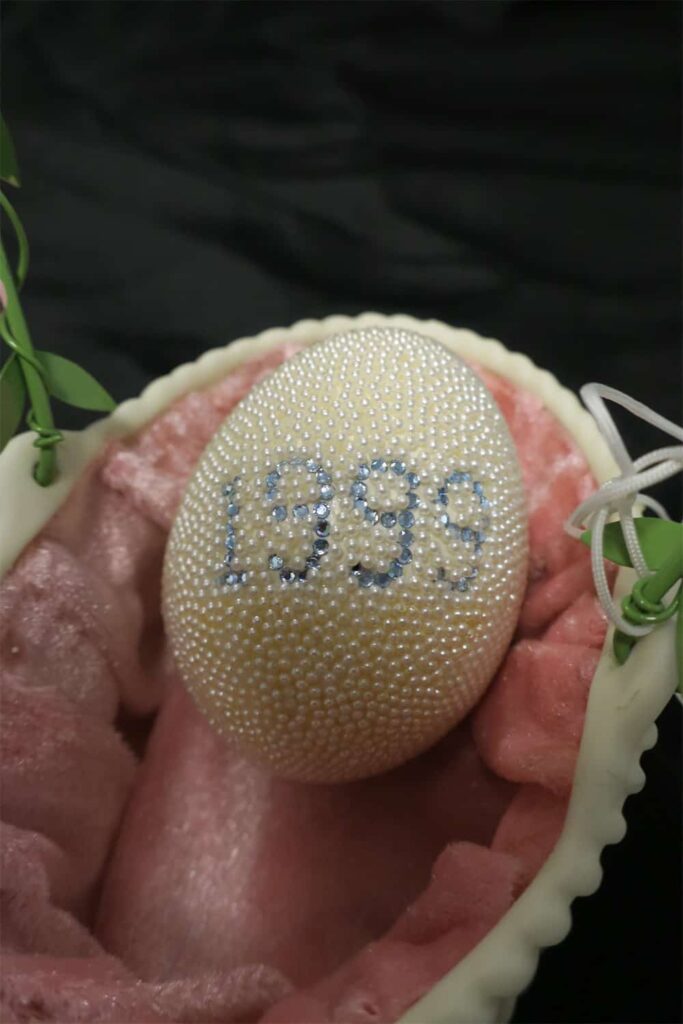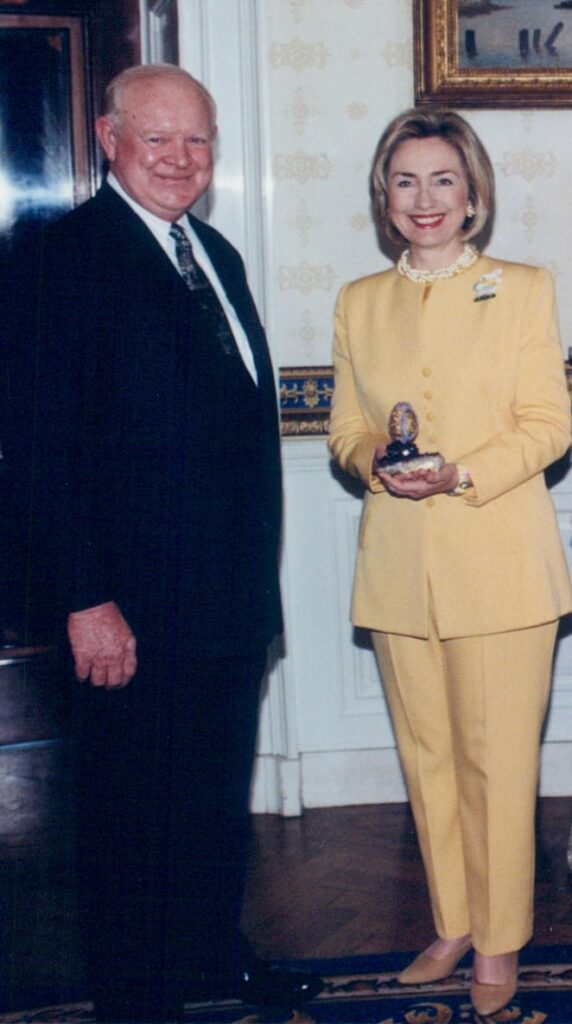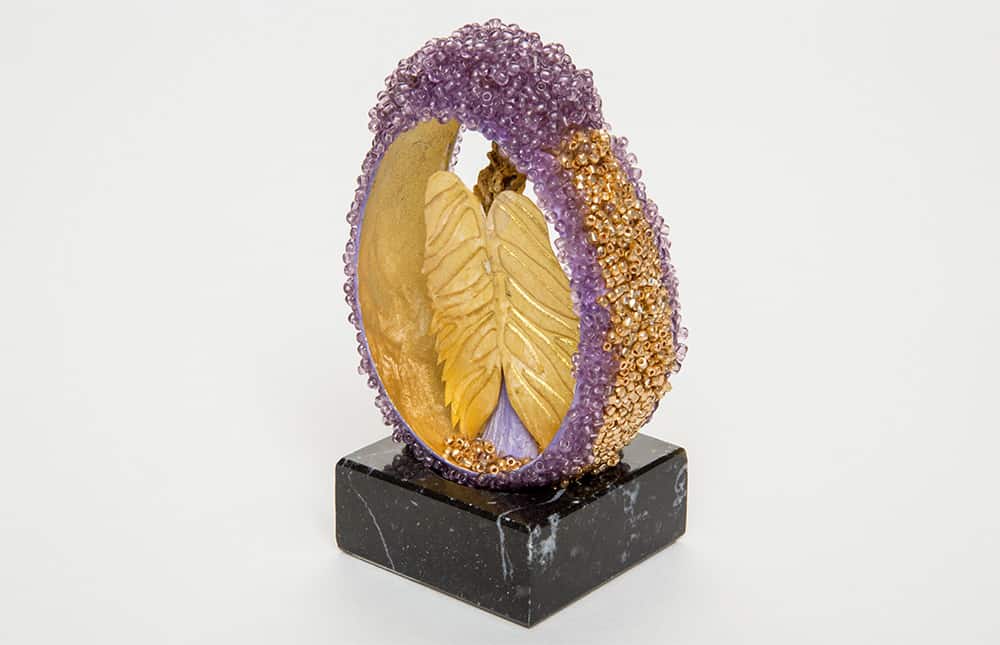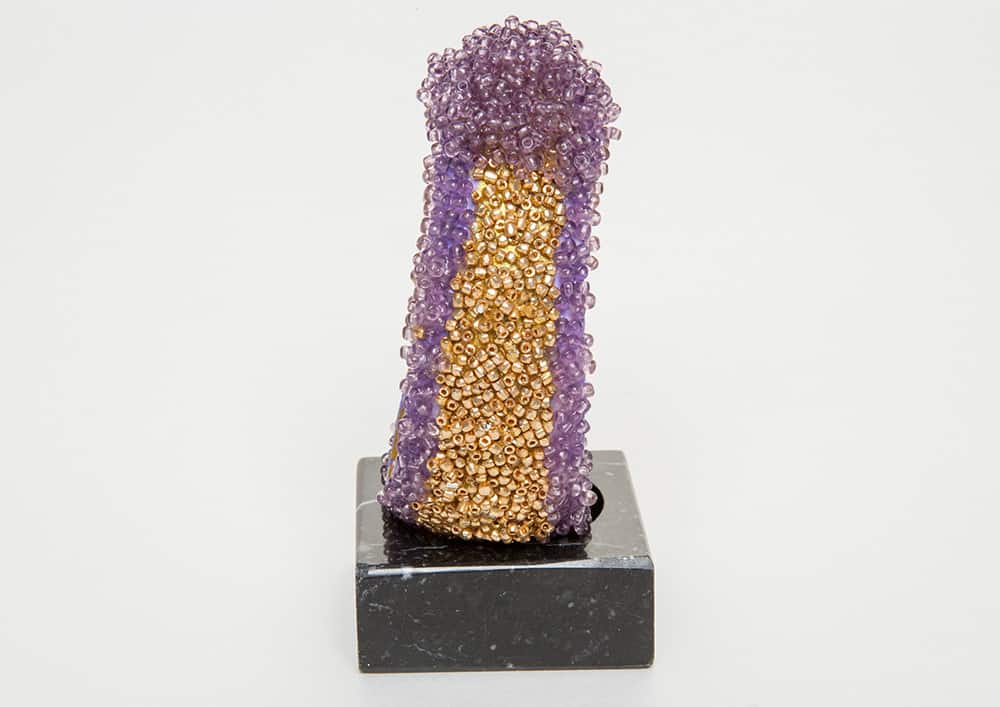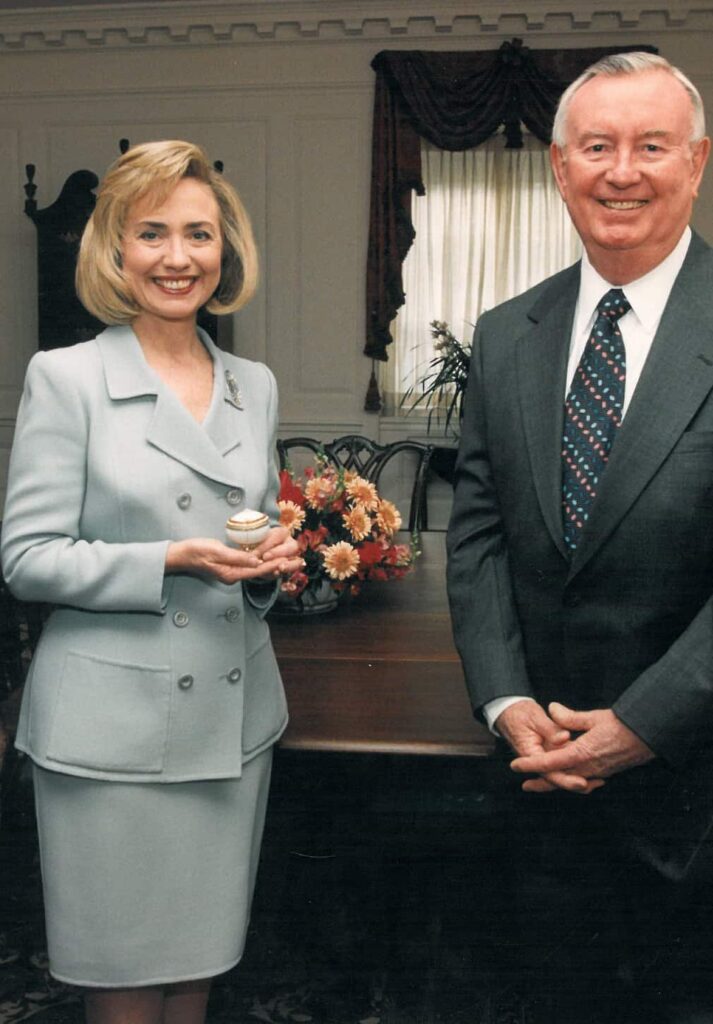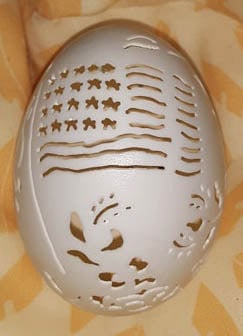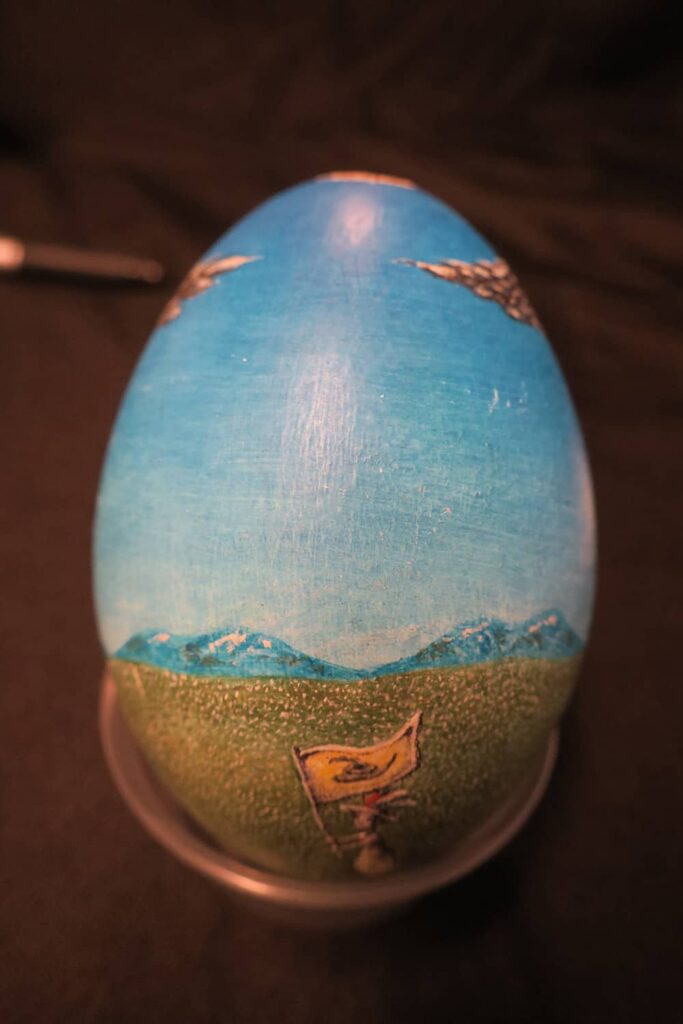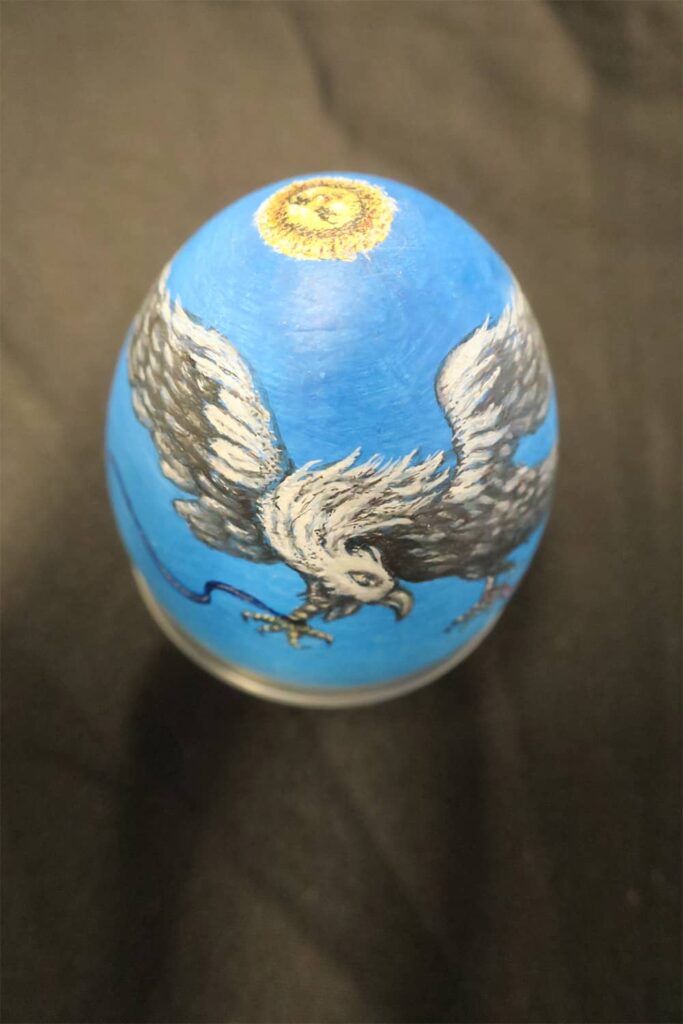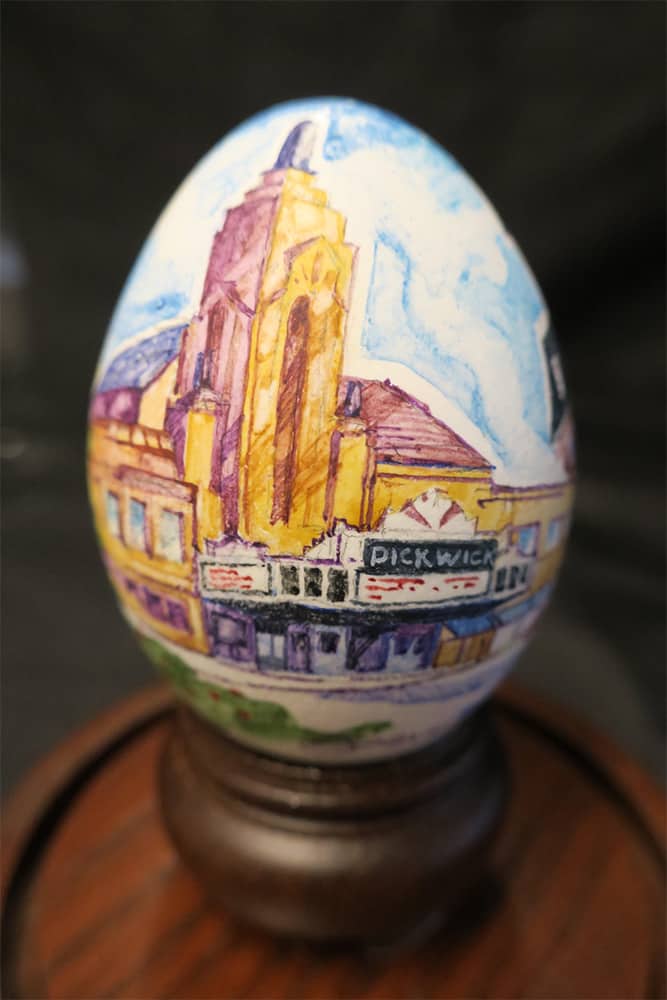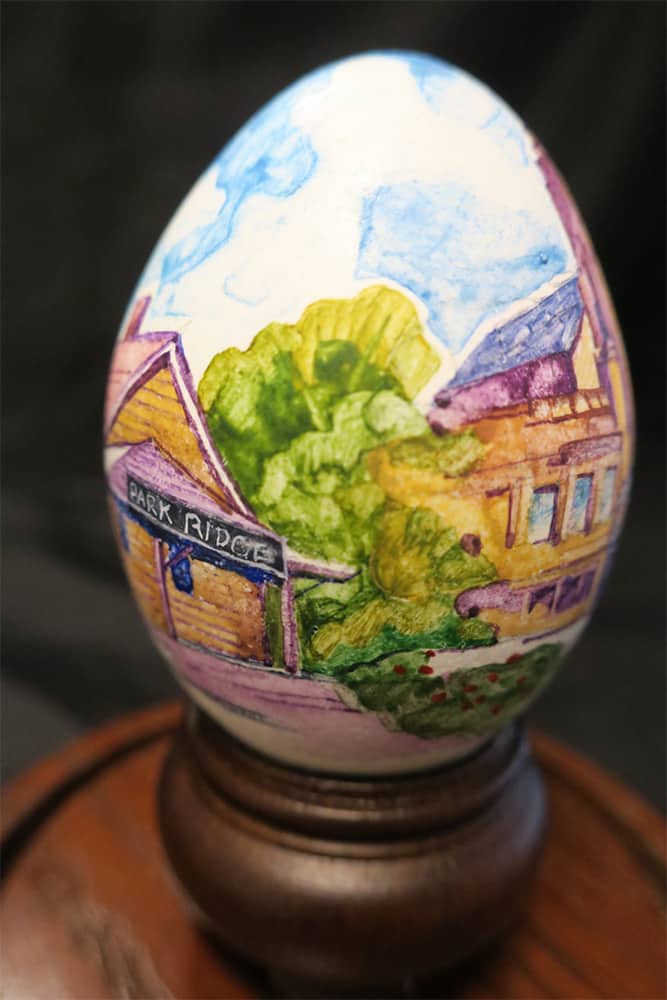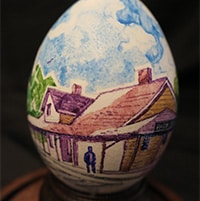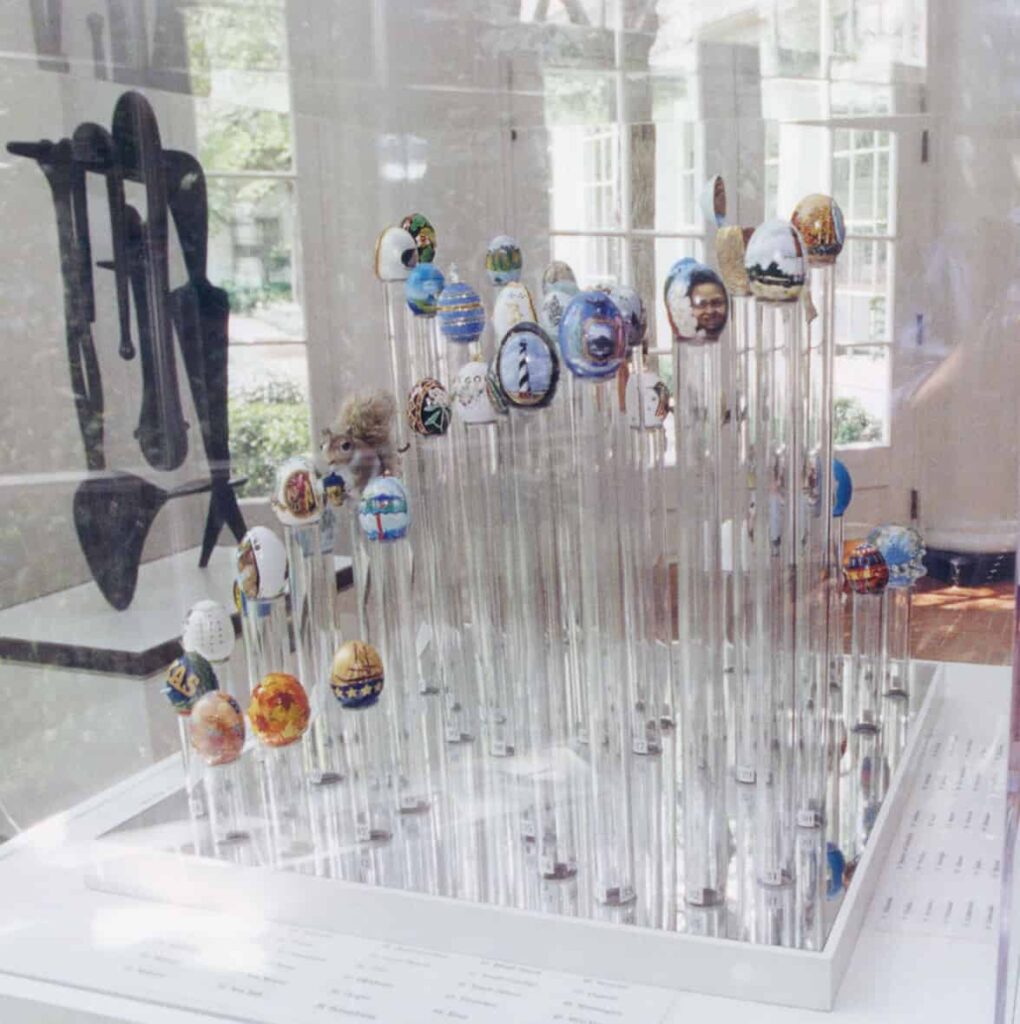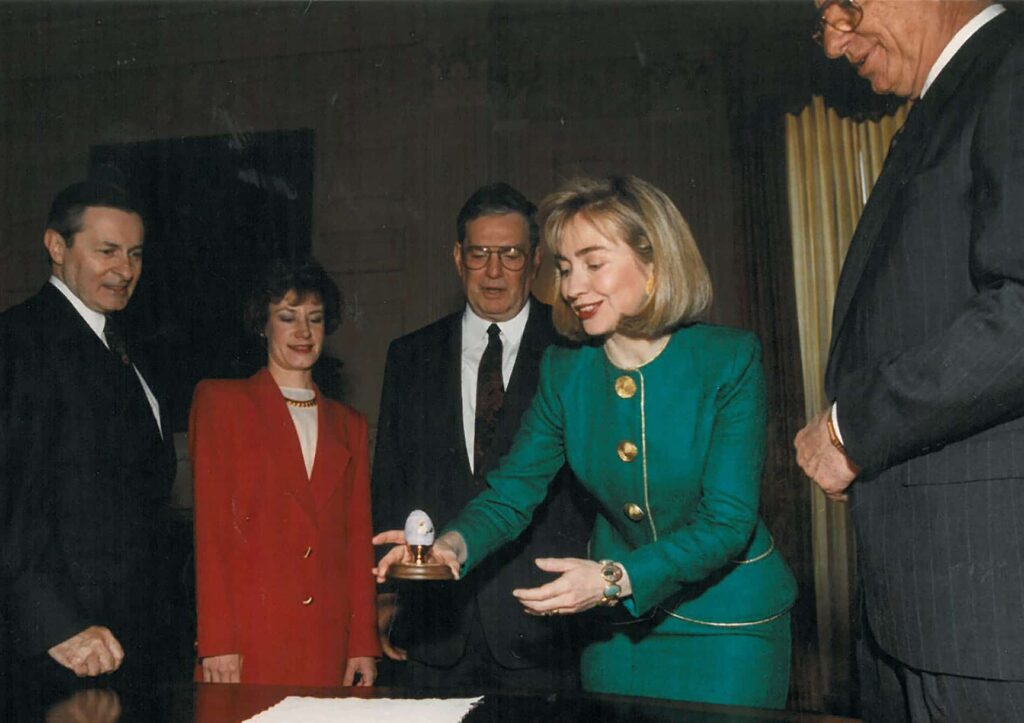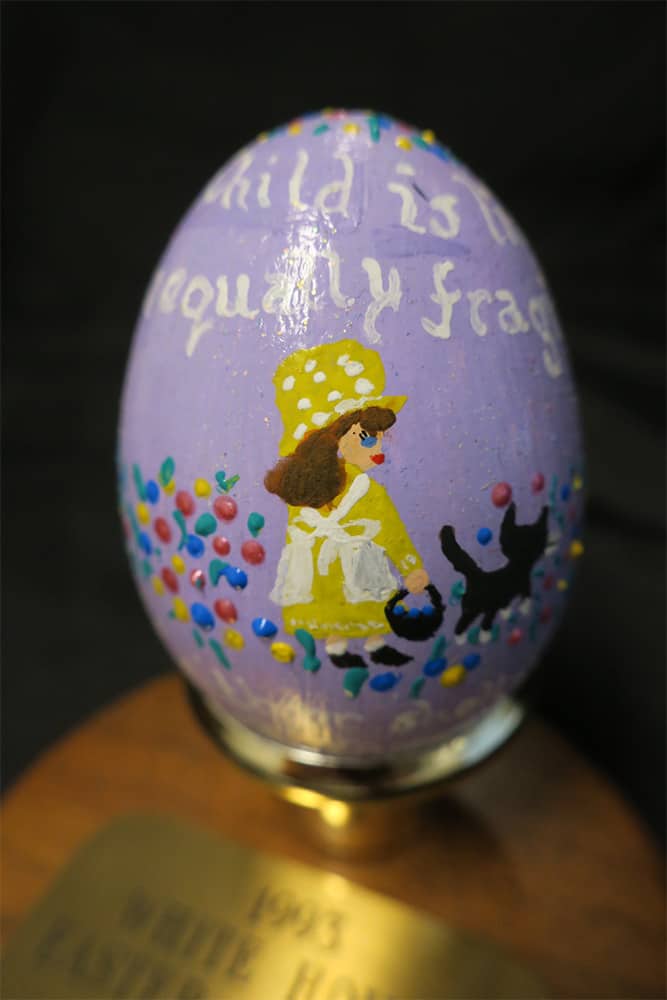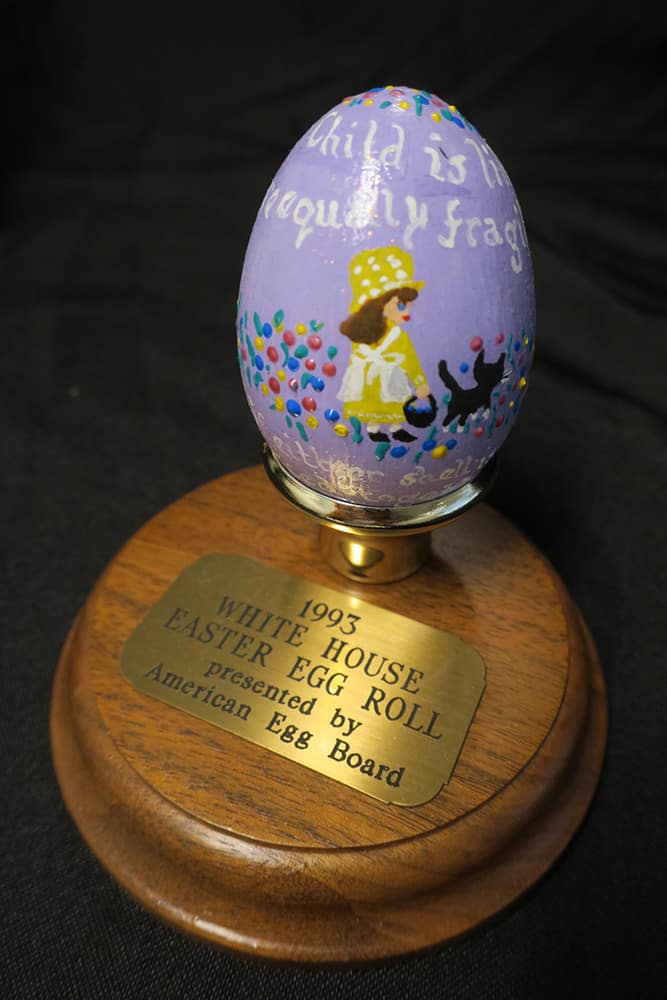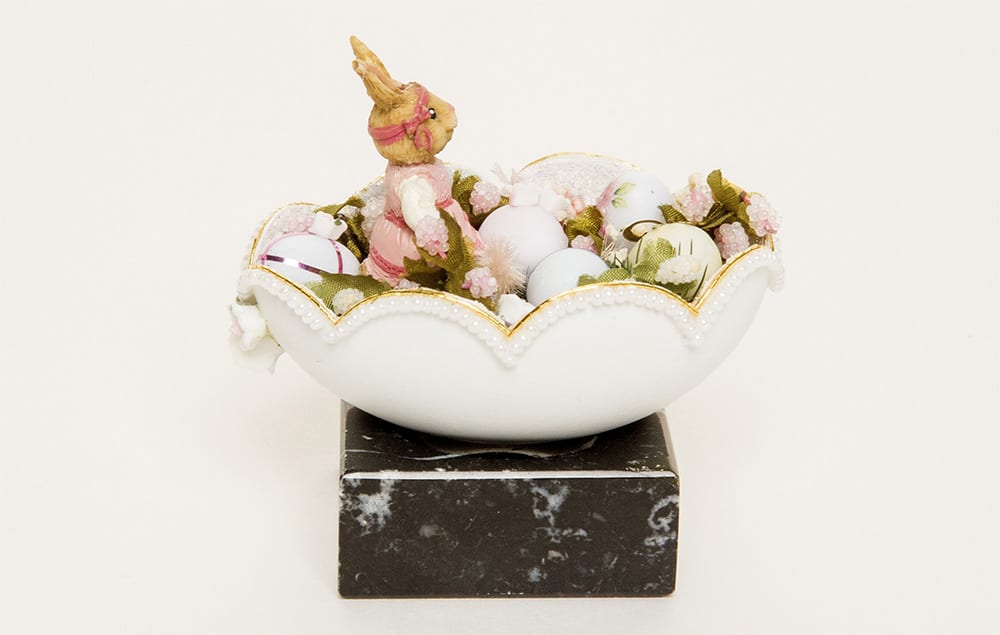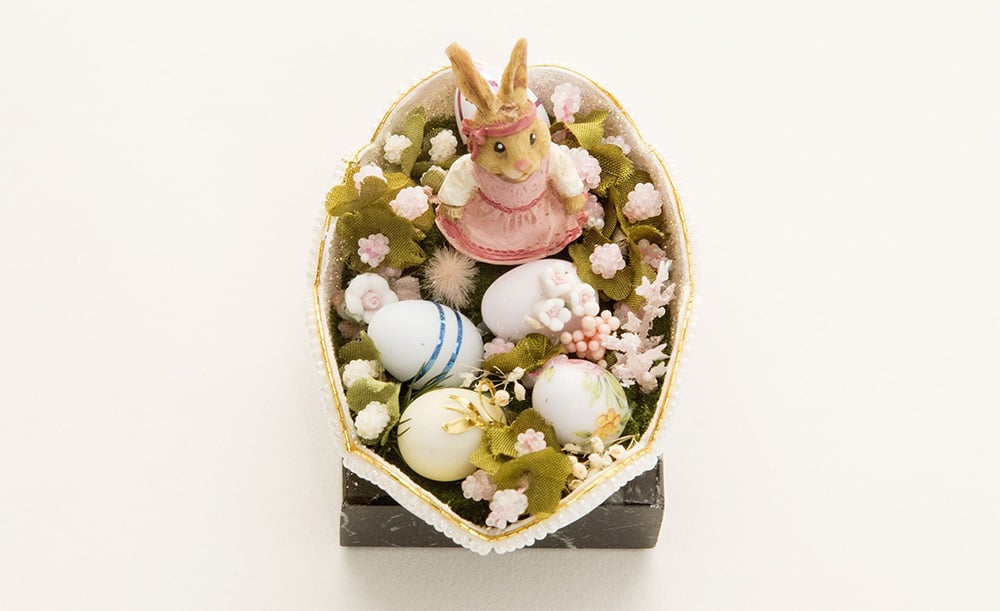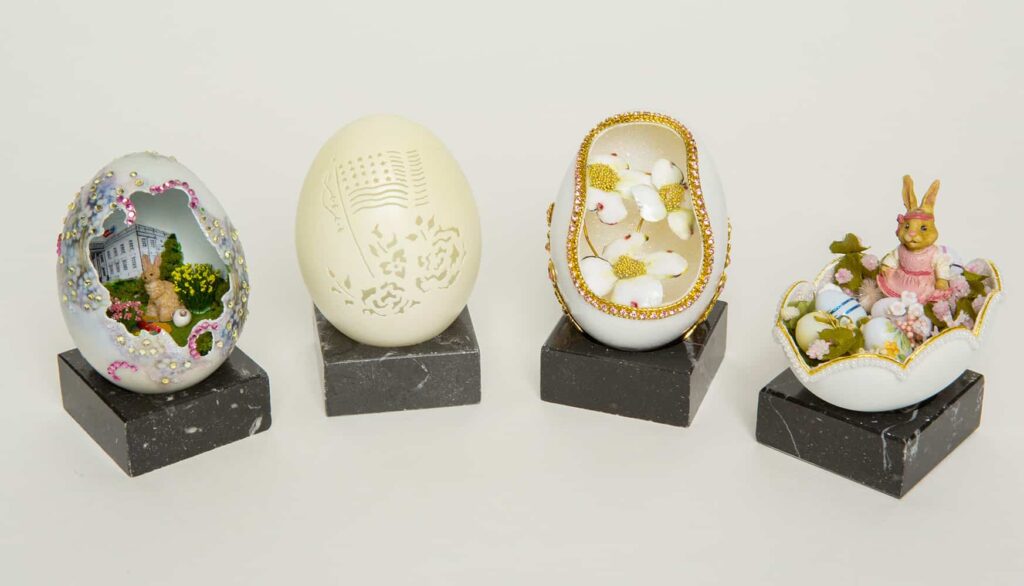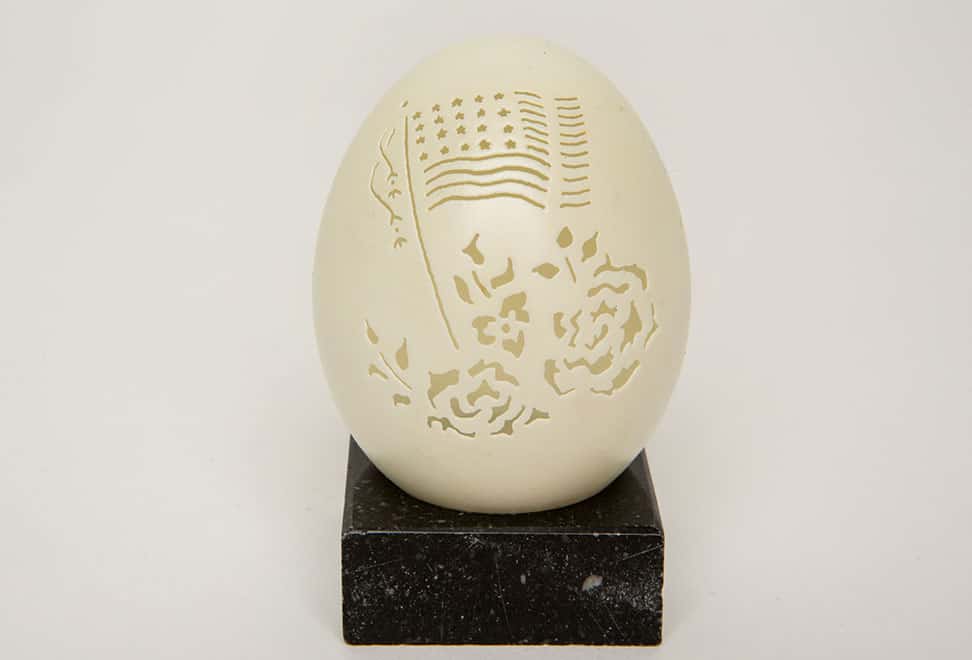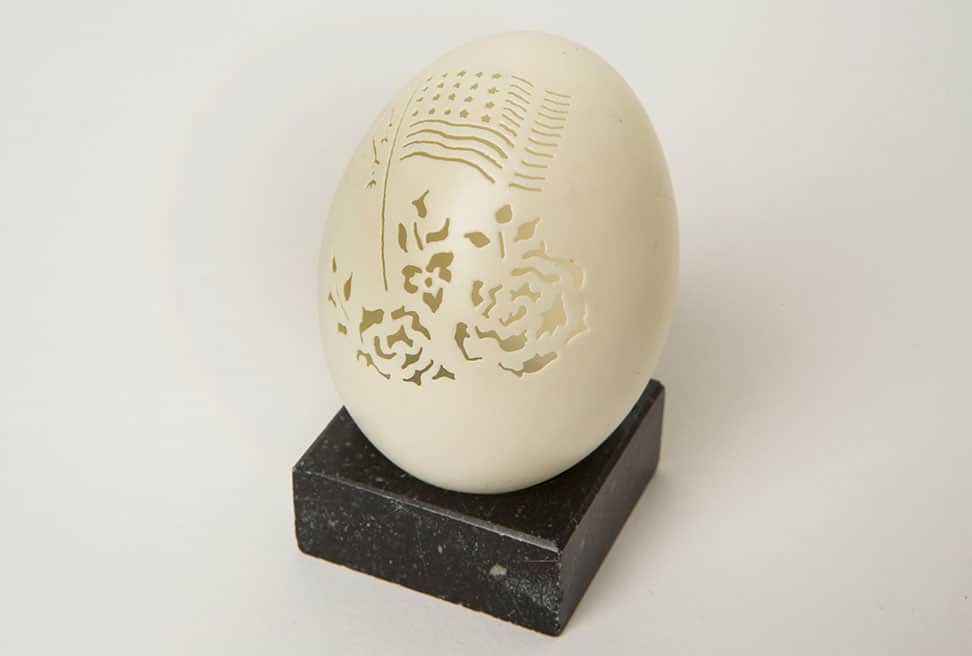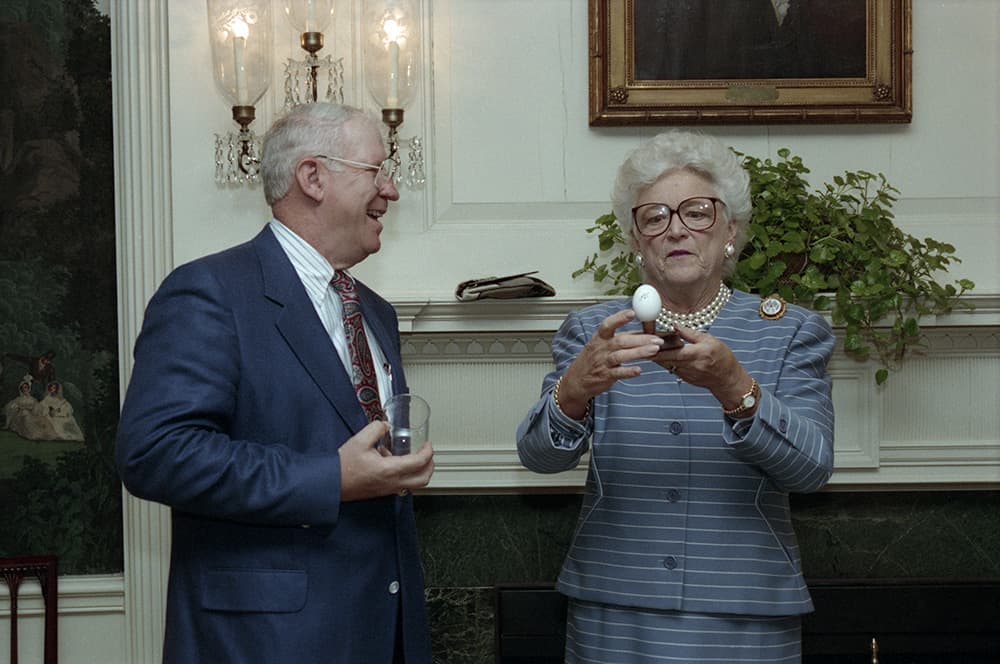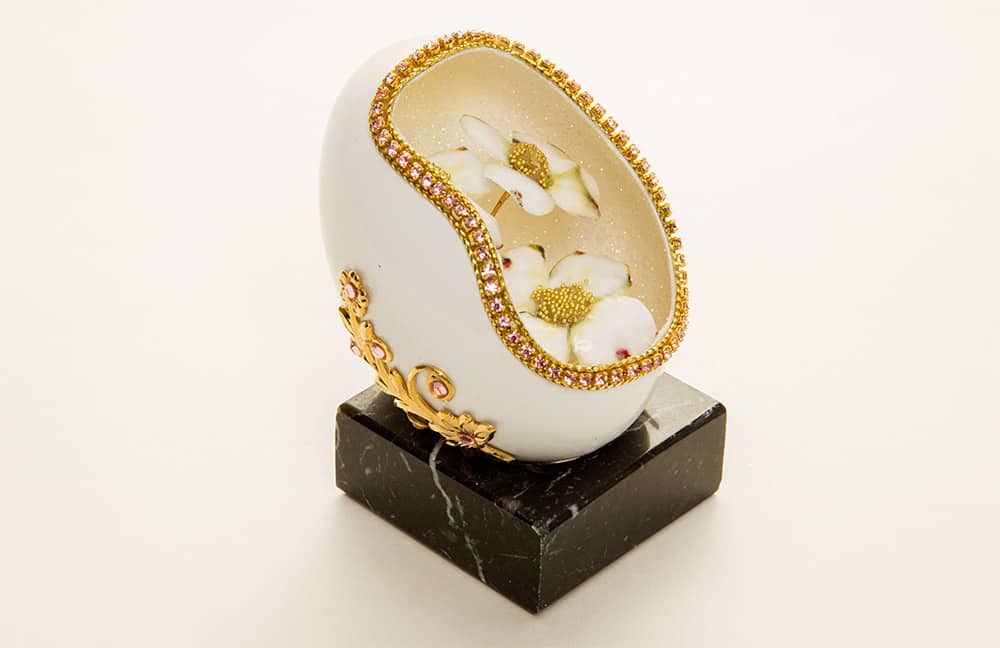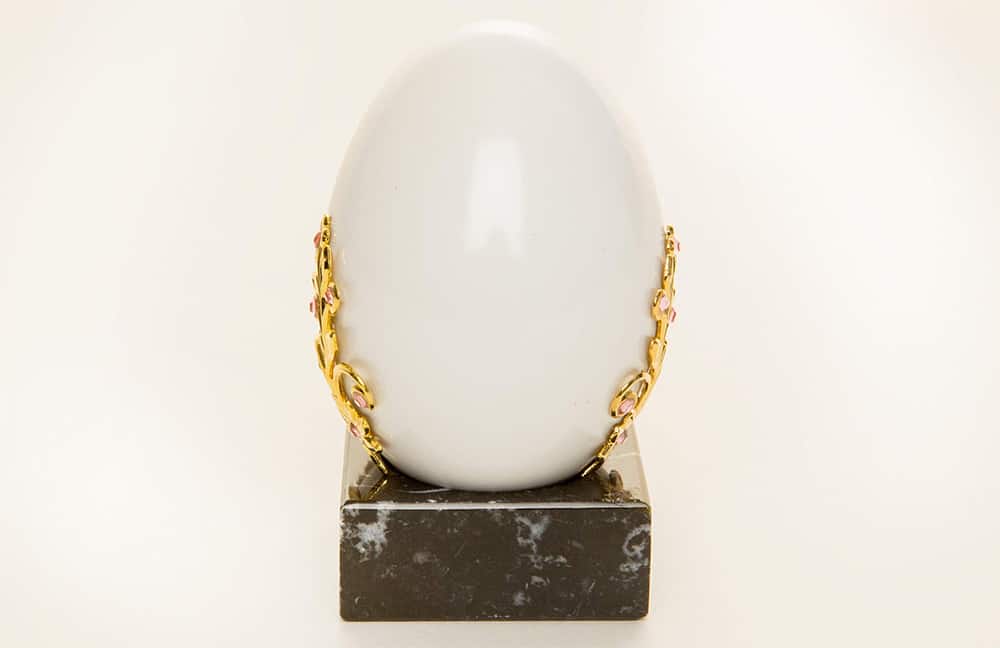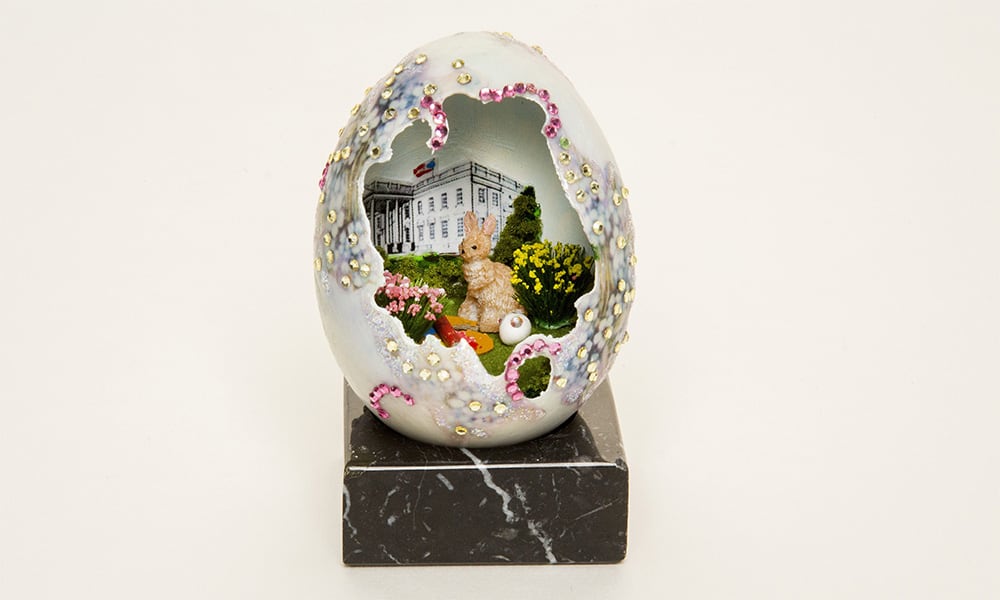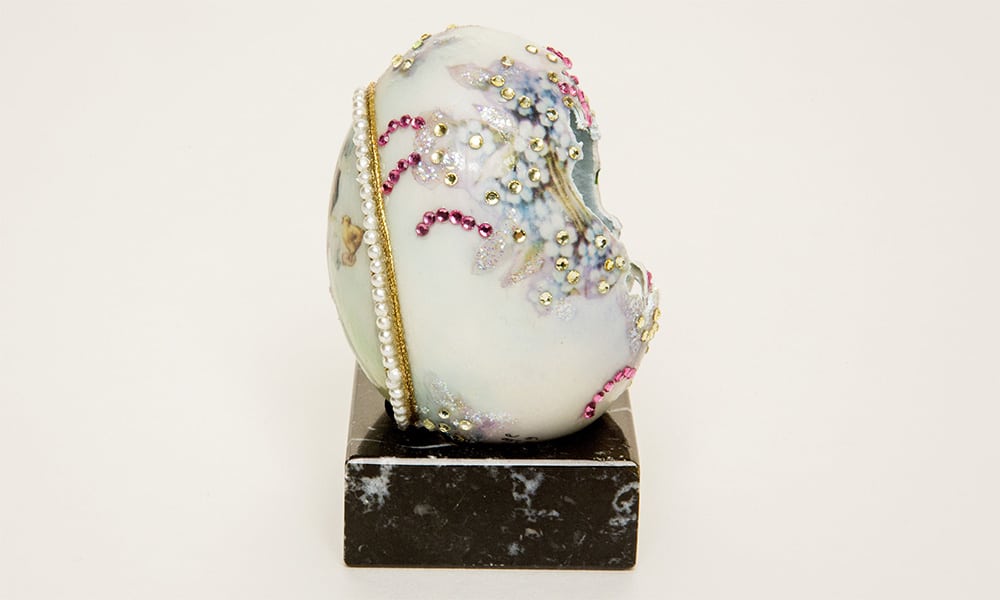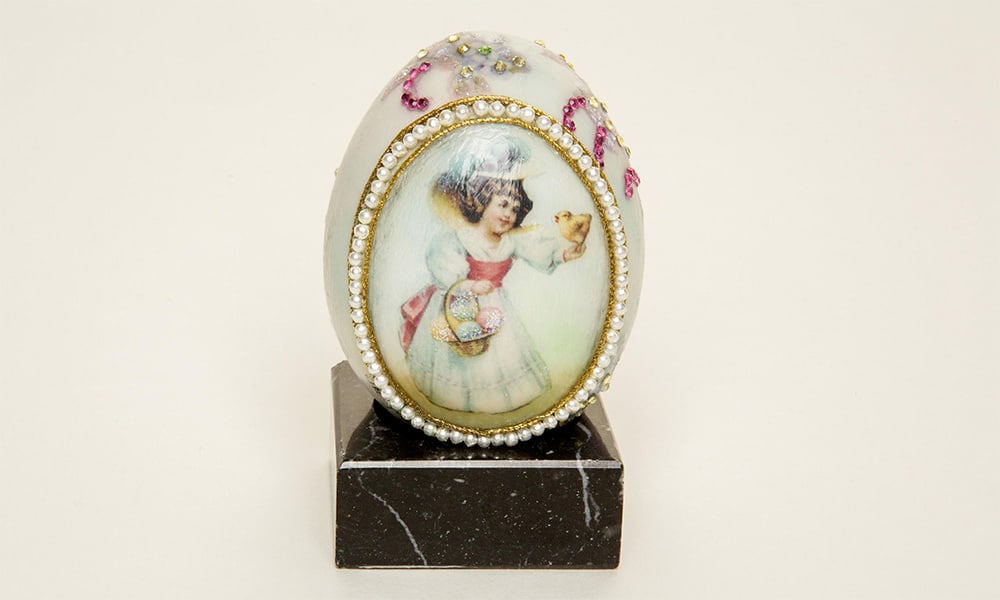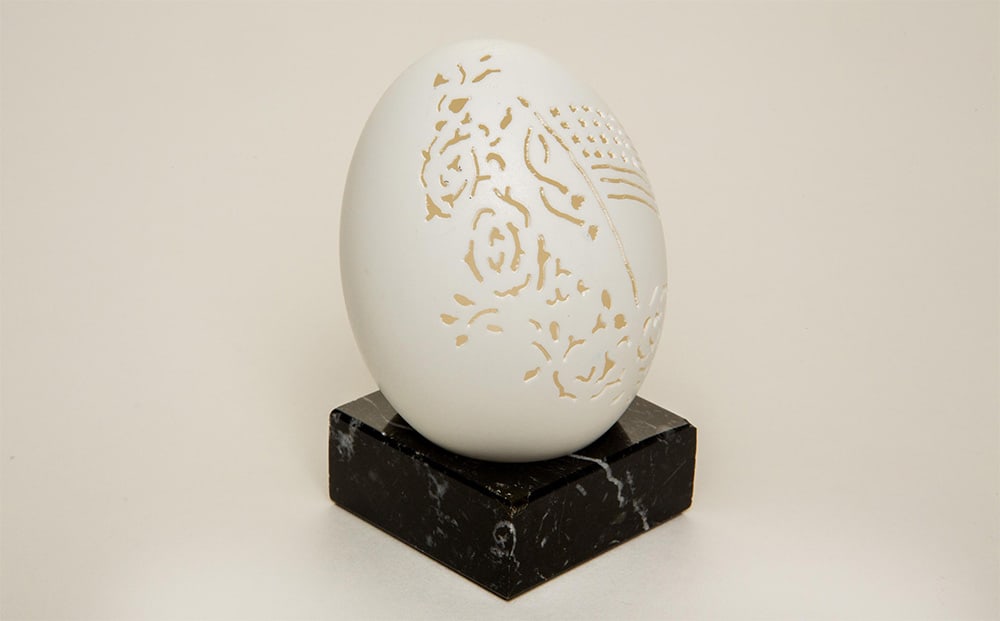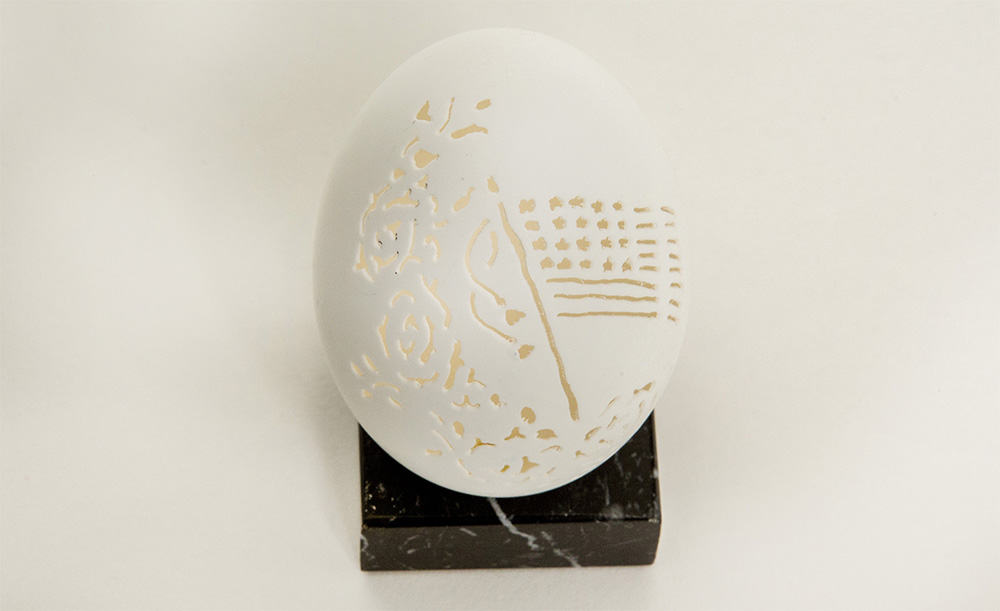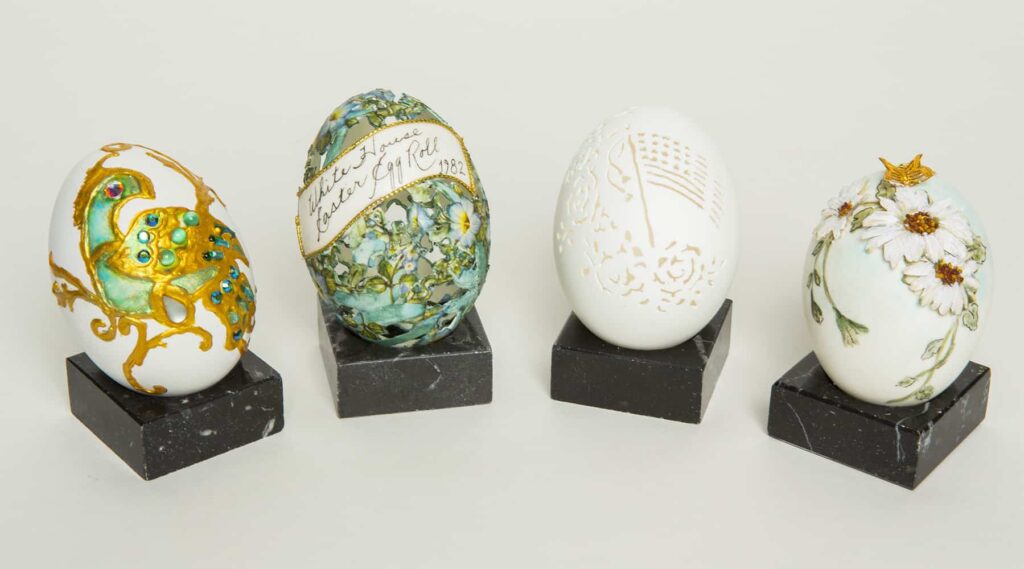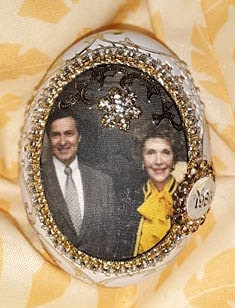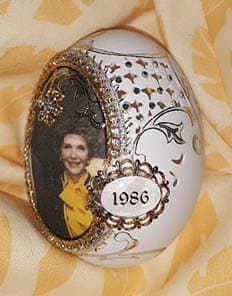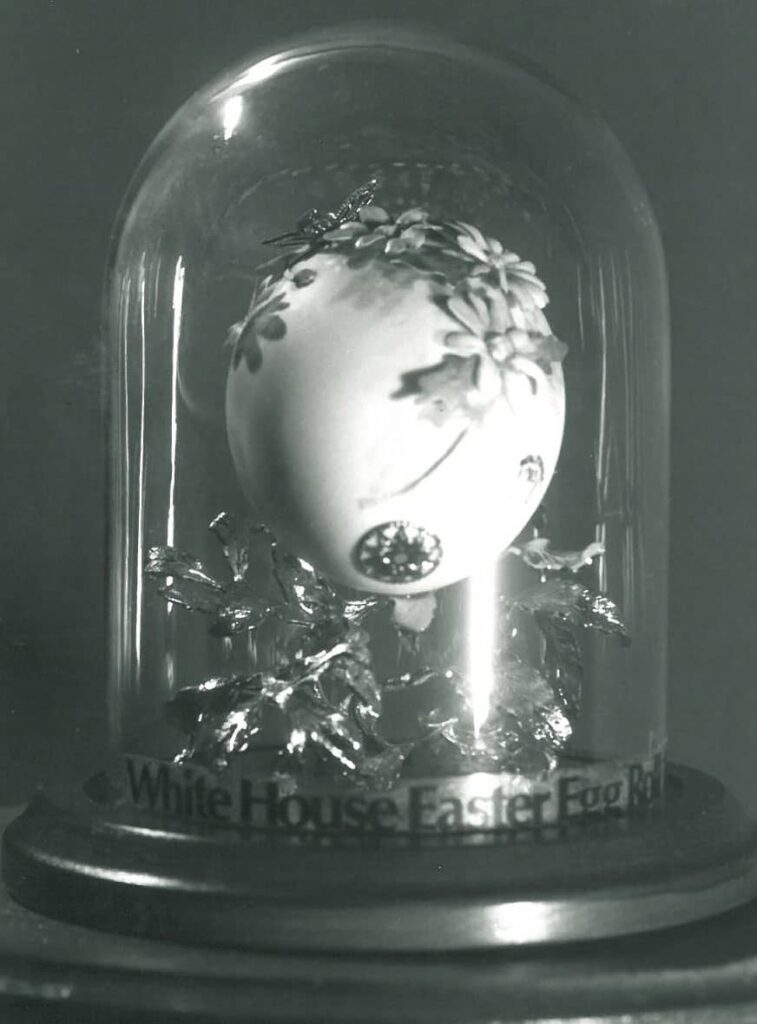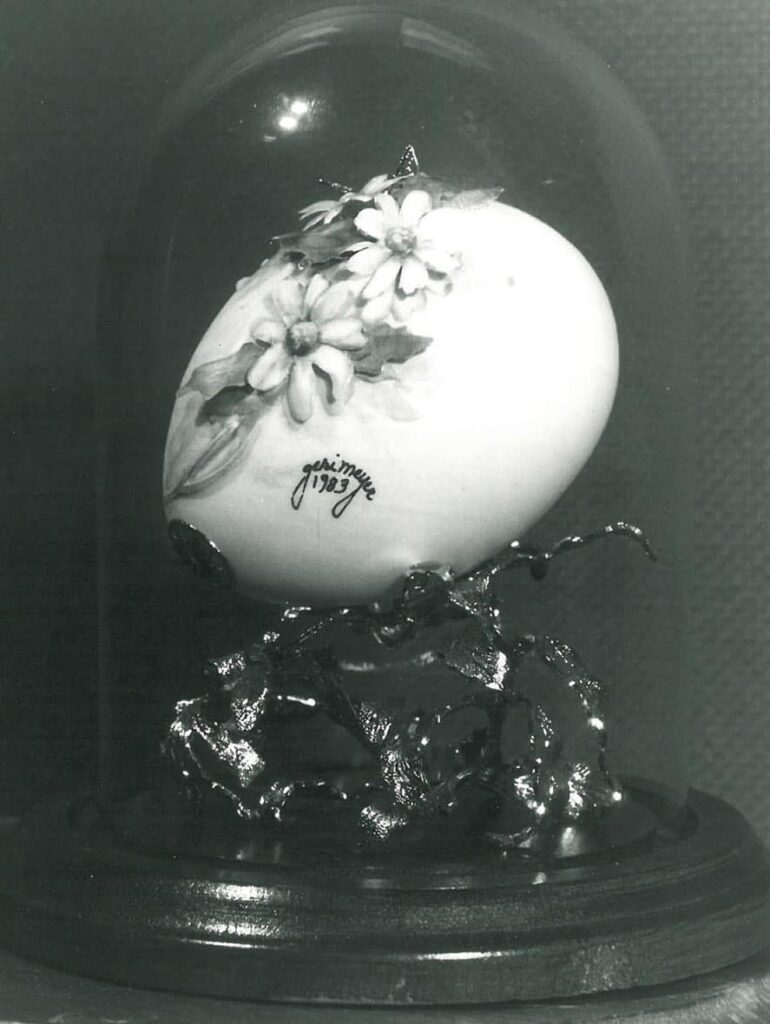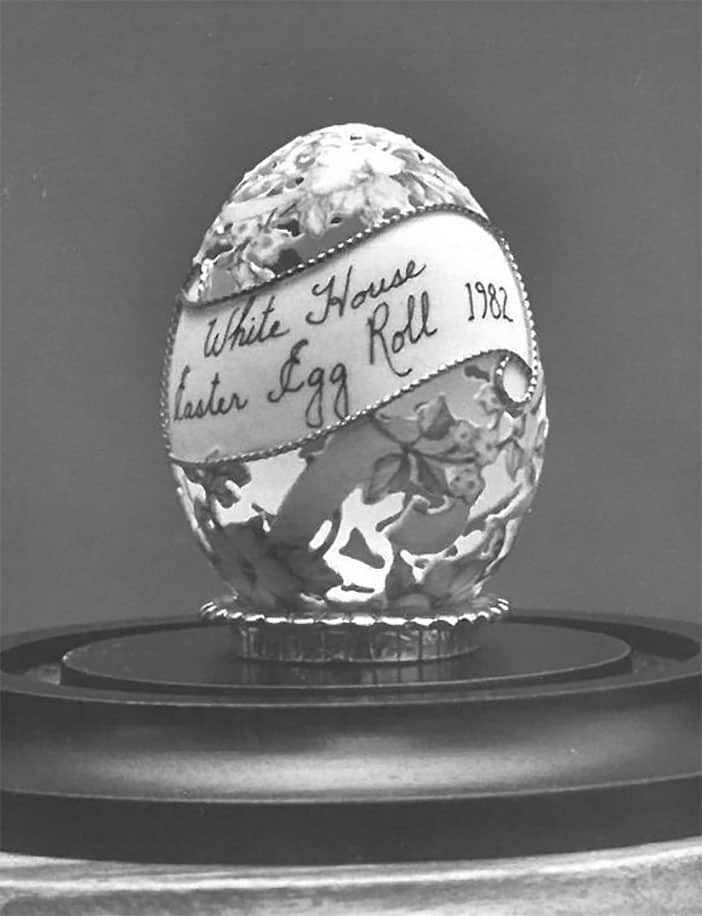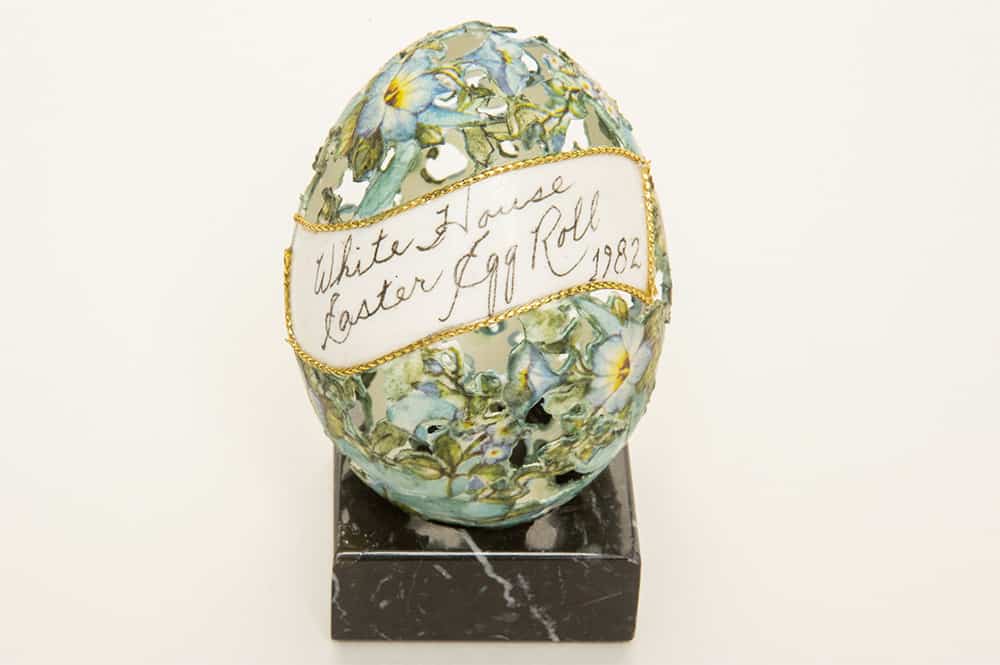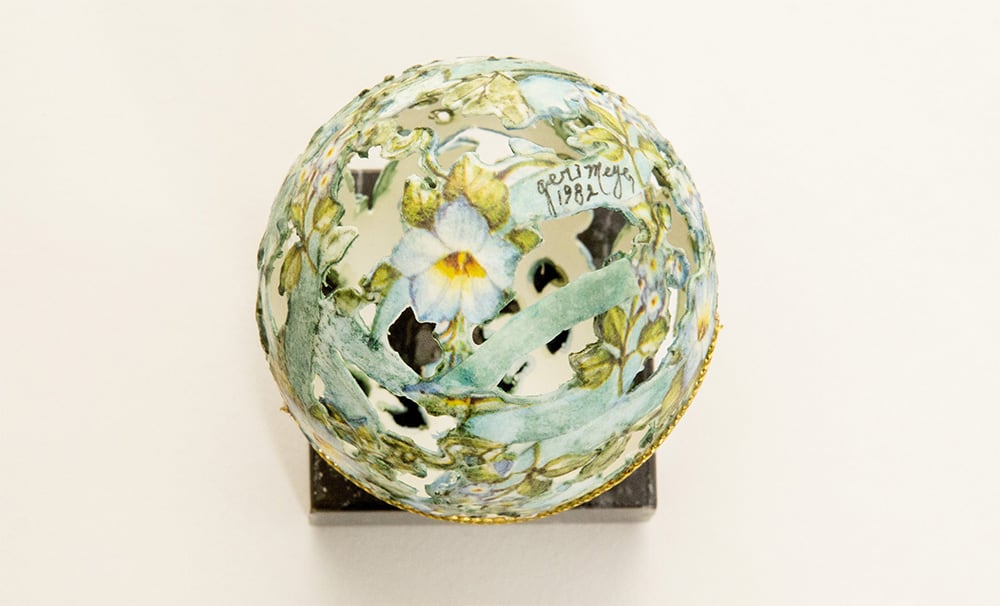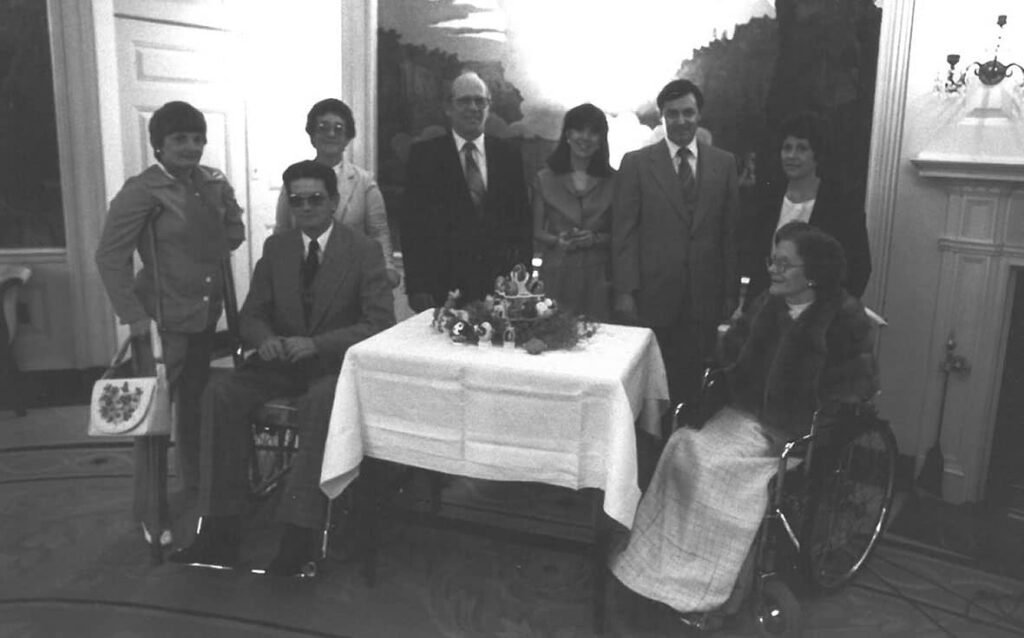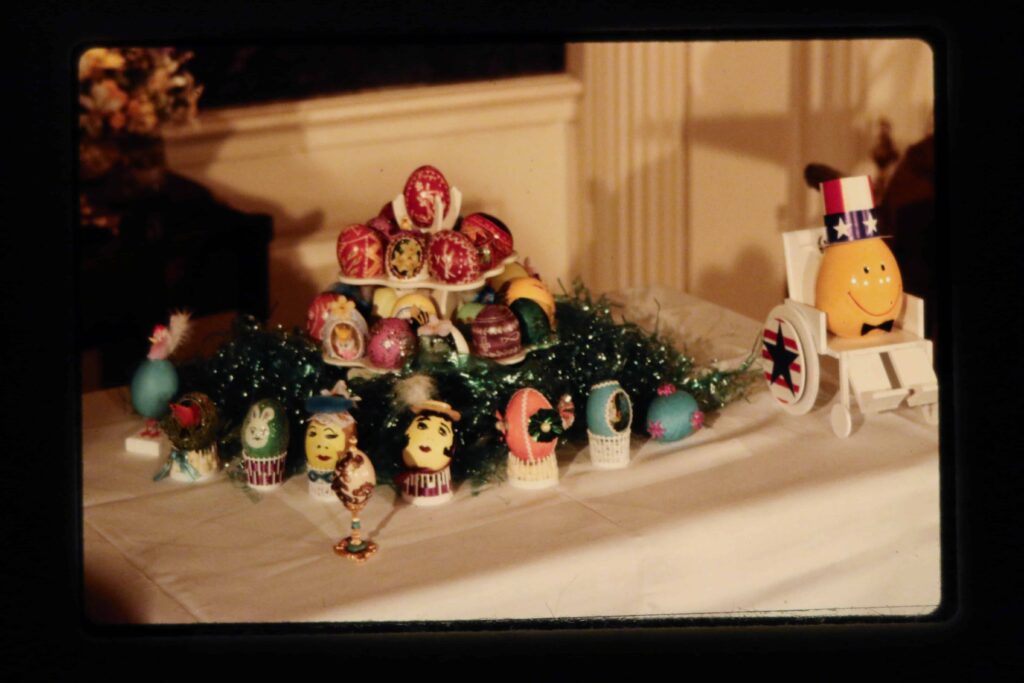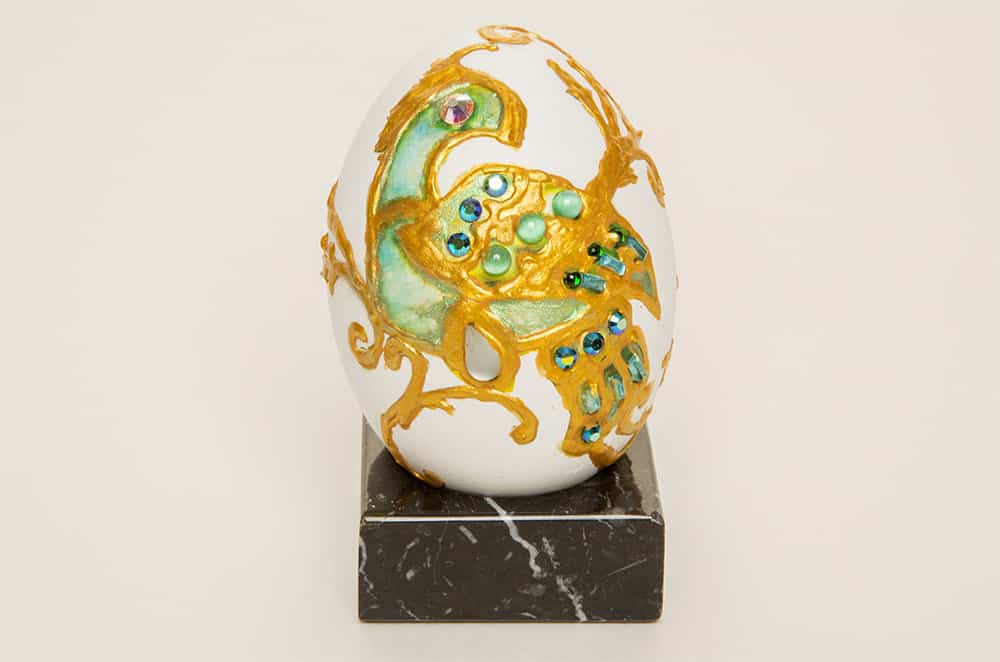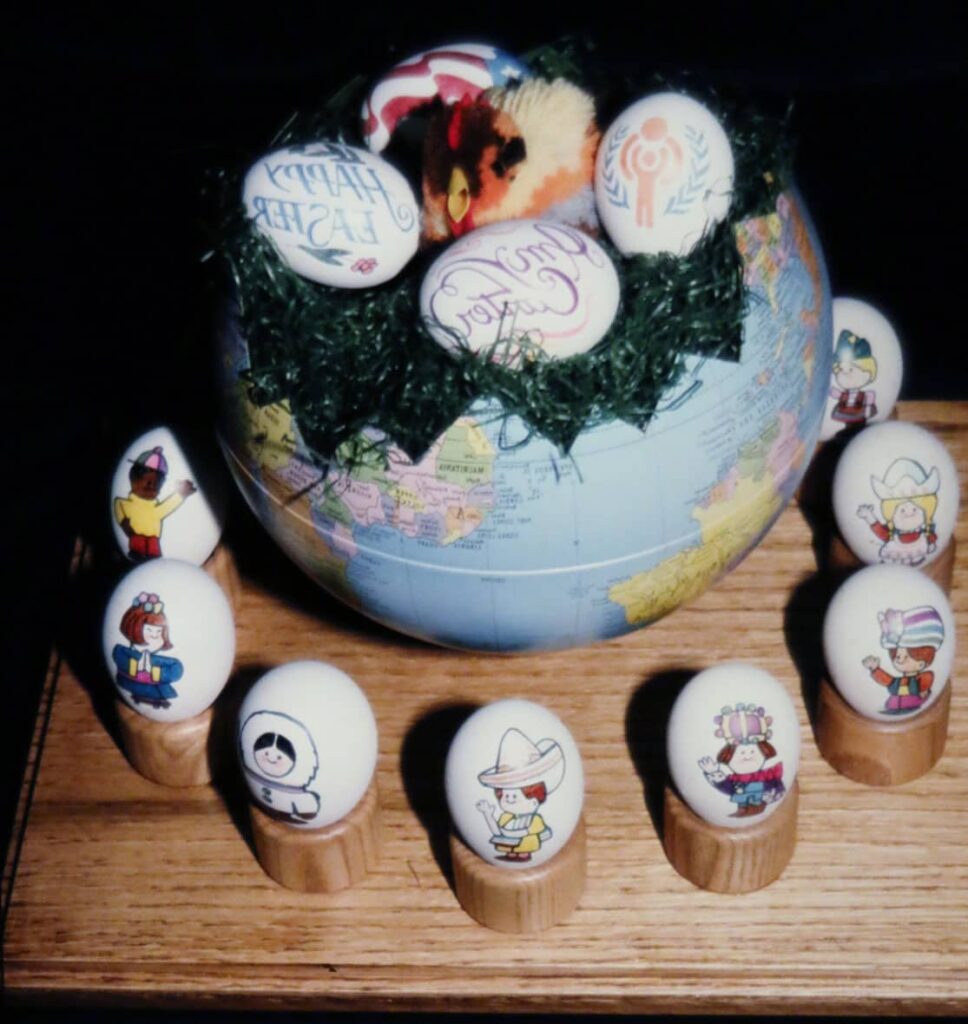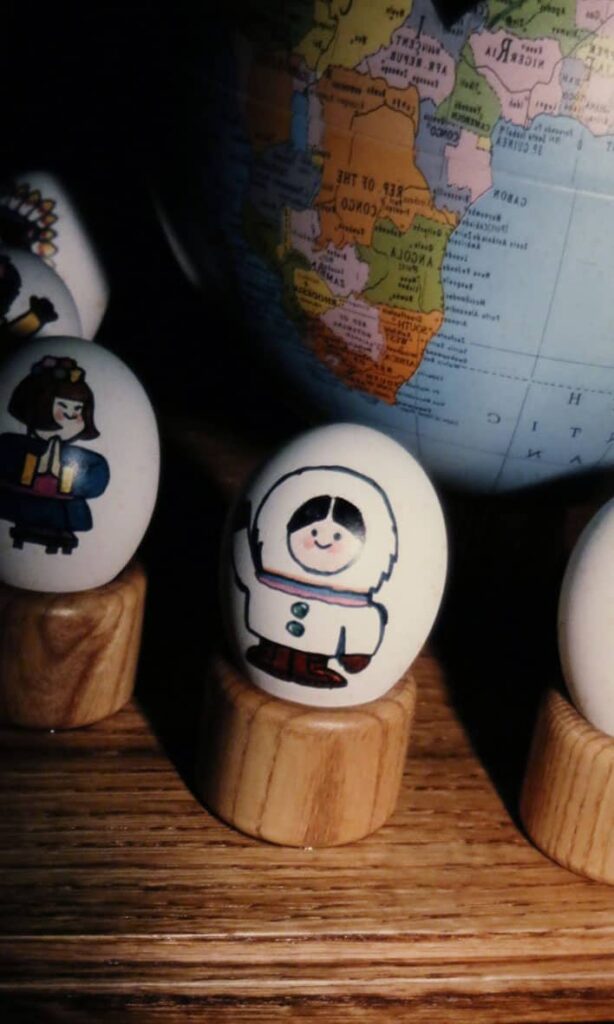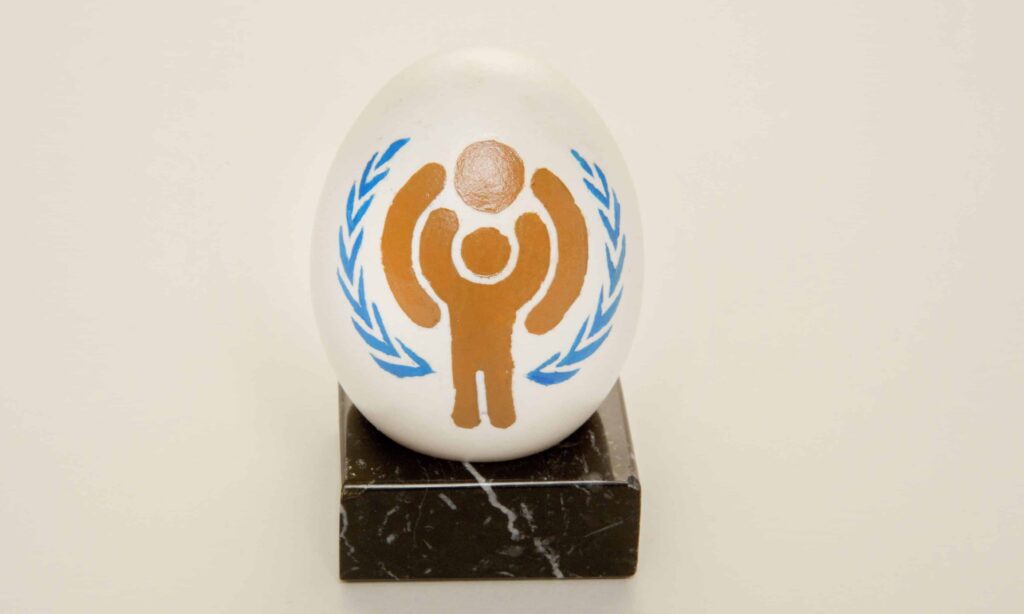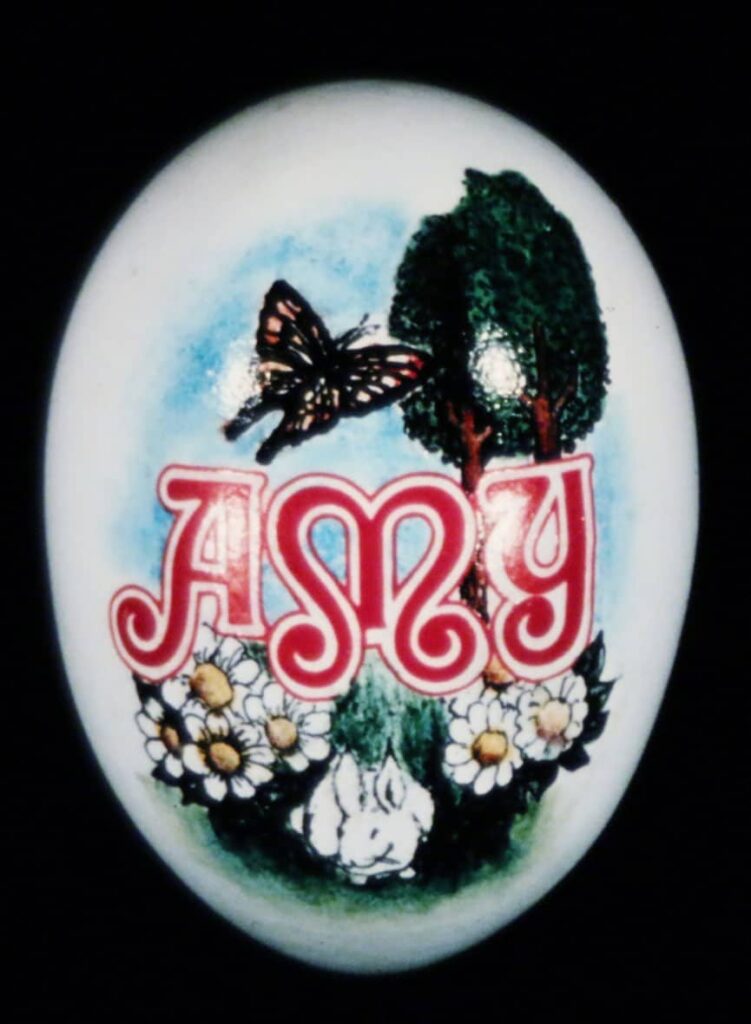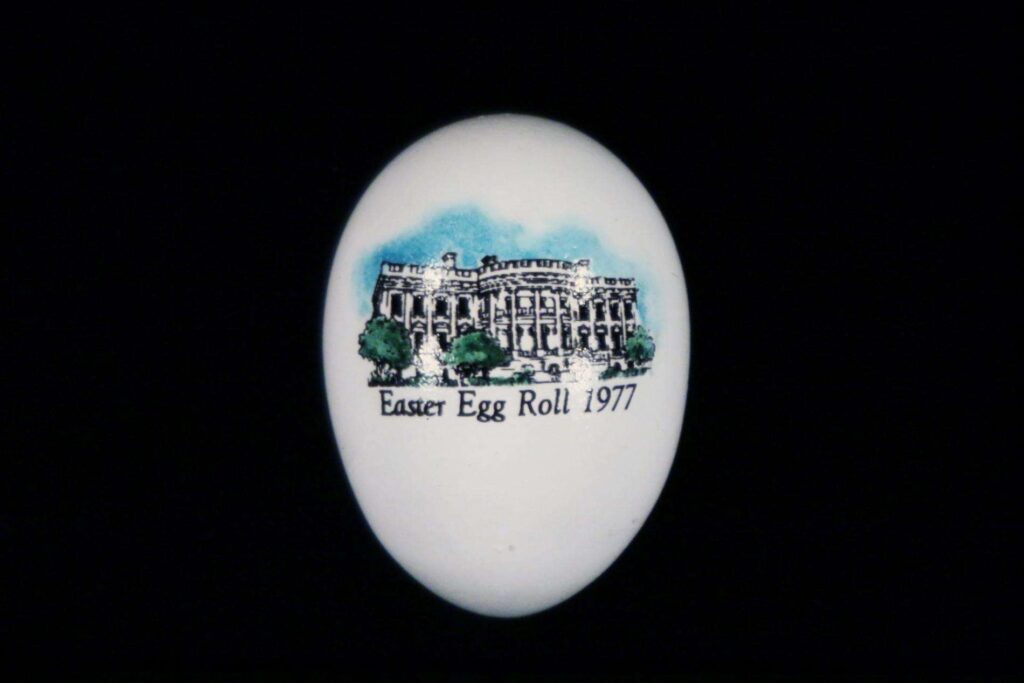The First Lady’s Commemorative Egg
For more than 40 years and on behalf of America’s egg farmers, the American Egg Board has presented the First Lady’s Commemorative Egg. This springtime tradition started in 1977 to First Daughter Amy Carter and continues today as a presentation to the First Lady of the United States during the White House Easter Egg Roll in the Diplomatic Reception Room inside the White House.
The egg itself is an actual chicken egg, typically an extra-large or jumbo size, that is crafted by a specialized egg artist who may be a member of the International Egg Art Guild. Eventually, these eggs can be housed at the respective presidential library, as administered by the National Archives and Records Administration. In some cases, these pieces of art become part of the First Lady’s personal collection.
Enjoy our collection of photographs from the presentations and a mix of both original and reproduced Commemorative Eggs from the last six decades.
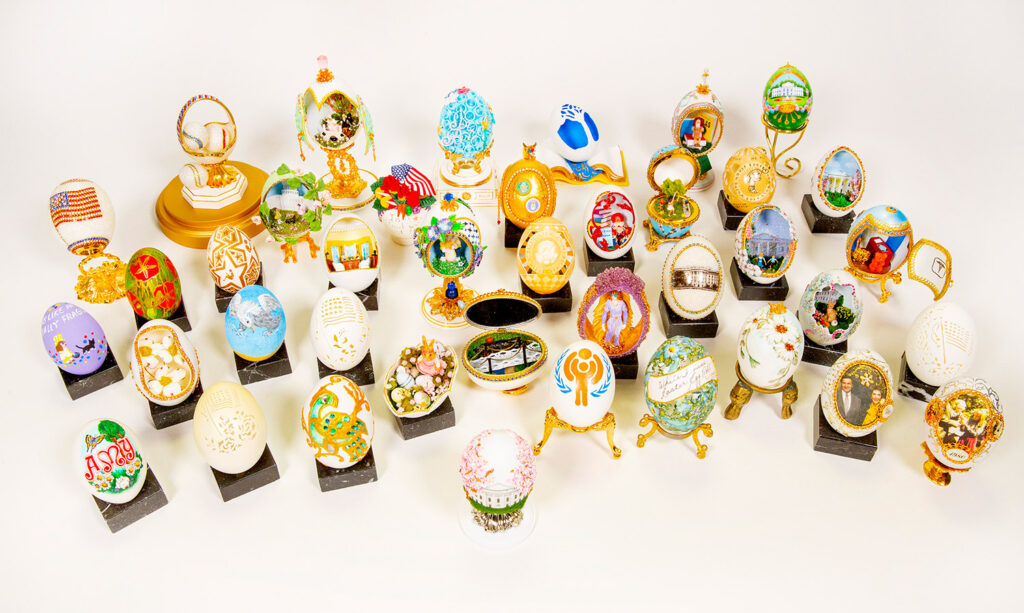
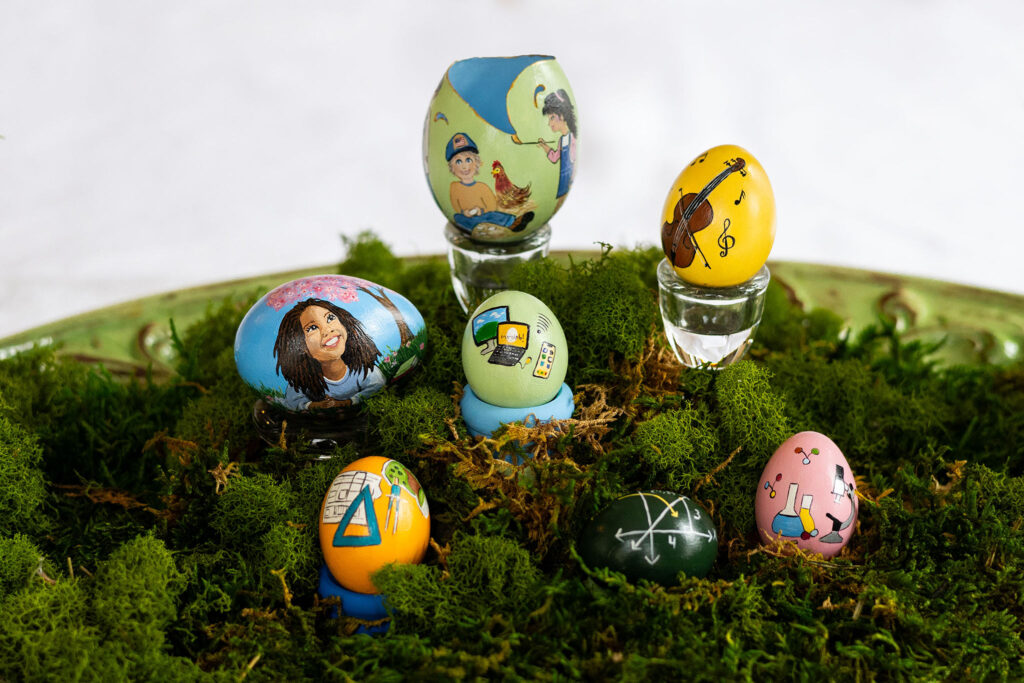
2024
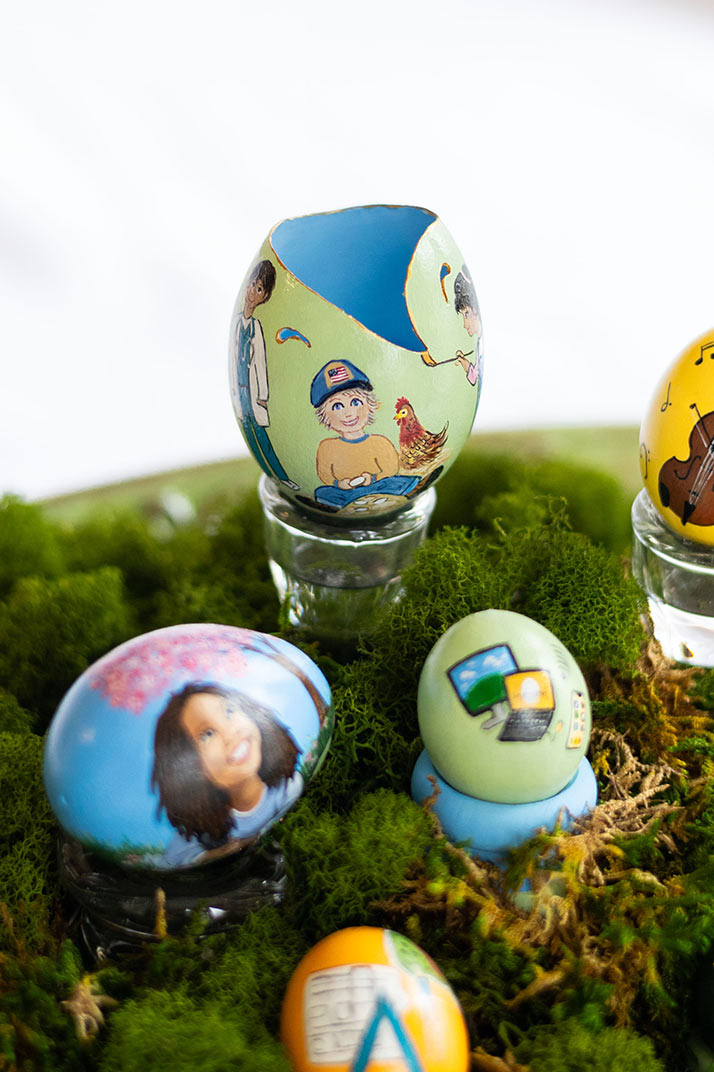
The 2024 First Lady’s Commemorative Egg, hand-crafted by master egg artist Carolyn Bickel from Nashville, Tennessee, honors Dr. Biden’s passion for education and inspiring future leaders of all ages. This year’s one-of-a-kind design celebrates the power of education, imagination, and dreams for the future.
Made from actual chicken eggs, the 2024 First Lady’s Commemorative Egg features one large egg surrounded by several “pullet” eggs from young hens. The painted design depicts a spring afternoon by a cherry tree, where a girl dreams of all she can be when she grows up—an egg farmer, a teacher, president of the United States? An opening at the top of the egg reveals the interior of the egg painted with a vibrant blue sky above the globe symbolizing the limitless possibilities achievable with a little imagination and the pursuit of knowledge. The pullet eggs depict the elements of a high-quality education that will aid this young girl in reaching her full potential.
2023
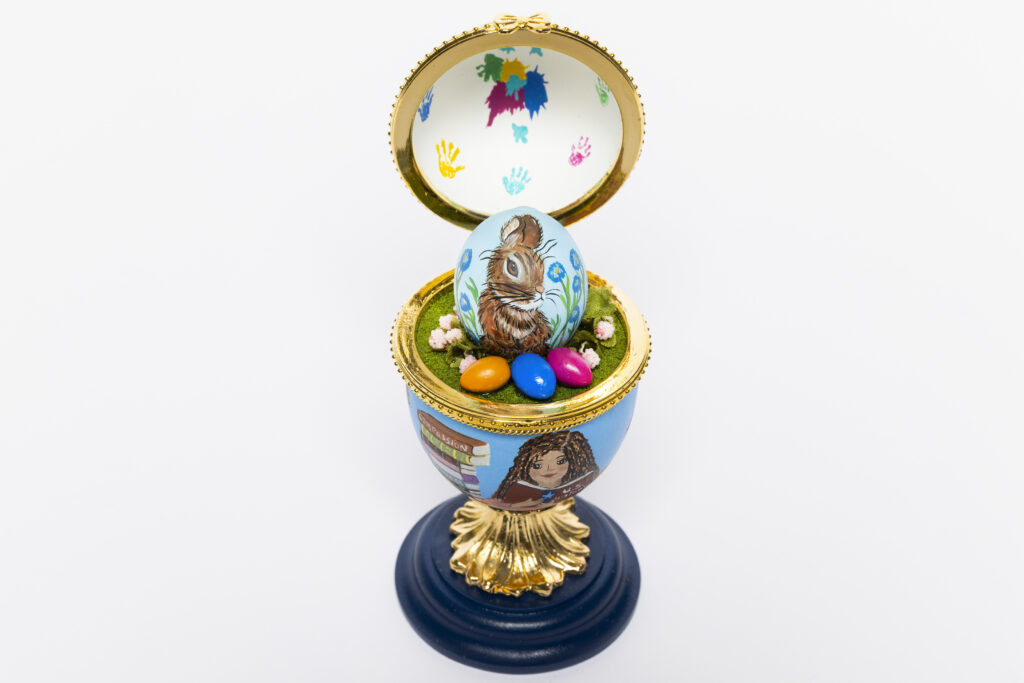
The 2023 First Lady’s Commemorative Egg, intricately designed by longtime egg artist Carolyn Bickel, highlights a passion of First Lady Dr. Jill Biden: education, and how knowledge empowers children to reach for the stars, one book at a time. Made from a real chicken egg, this year’s Commemorative Egg features images of children in the grass reading together, with the spines of a stack of books behind them bearing the words, “unity,” “compassion,” “kindness,” and “connection,” and a girl standing atop a winged book as she reaches toward a starlit sky.
The egg is a hinged jewel box design that opens to reveal another decorated, slightly smaller pullet egg inside. This smaller egg was hand-painted with a whimsical bunny and set in spring grass.
2022
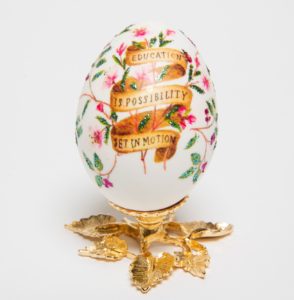
The 45th annual First Lady’s Commemorative Egg, designed by self-taught artist Mary O’Reilly and executed by master egg artist Russ Hagan, serves as an ode to Dr. Biden’s dedication to accessible education for all Americans. A hand-painted quote from Dr. Biden is featured in flowing scrolls on the front of the 2022 First Lady’s Commemorative Egg: “Education is possibility set in motion.” Surrounding the quote are peach blossoms, Delaware’s state flower, and the American Holly, Delaware’s state tree — homages to the state the Bidens have called home since the 1970s.
America’s egg farmers were honored to announce that they donated over 90 million eggs to food banks across the country, making good on a pledge made at the presentation of the 44th Annual First Lady’s Commemorative Egg. In the spirit of Easter, America’s egg farmers also donated every egg used at the 2022 White House Easter Egg Roll; over 100,000 eggs were donated to the event and to the Maryland Food Bank.
2021
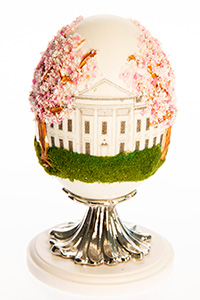
The 44th Annual First Lady’s Commemorative Egg has been intricately designed by master egg artist Russ Hagen to honor the American spirit of optimism in the wake of COVID-19. This extra-large chicken egg has been hollowed and features images of the front and rear of the White House on vintage silk, flanked by the iconic flowering cherry blossoms of the nation’s capital. The cherry blossoms, symbolizing rebirth and good luck, have been meticulously crafted in honor of Dr. Jill Biden to reflect hope and our shared American values in the spring season of renewal.
America’s egg farmers have a proud history of helping to fight hunger and giving back to their communities throughout the year. With millions of Americans going hungry in the wake of the pandemic, the presentation of the 44th Annual First Lady’s Commemorative Egg was accompanied by a landmark pledge by egg farmers nationwide to donate more than 90 million eggs to food banks and communities in need across the country in 2021.
2020
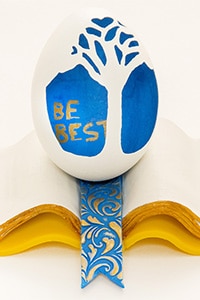
The 43rd Annual First Lady’s Commemorative Egg is an extra-large chicken egg that has been hollowed and intricately decorated. The design reflects the First Lady Melania Trump’s “Be Best” initiative and pulls inspiration from the children of America’s egg farmers. The 2020 Egg is painted in royal blue paint and accented with gold leaf, featuring a carved tree to honor the “Be Best” initiative. The tree signifies children planting the seeds of personal growth, and three hearts within the foliage represent the three pillars of the “Be Best” campaign – kindness, community and positivity. All three words also appear in gold-leaf on the back of the egg.
Three artists helped bring this year’s egg to life: Quentin Oliver of Quiet Light Communications, located in Rockford, Ill., created the design; award-winning Salt Lake City egg artist Brian Baity carved and painted the egg; and Laura J. Schiller, out of her art studio in Westminster, Colo., created the polymer clay book that represents the endless potential of America’s children.
2019
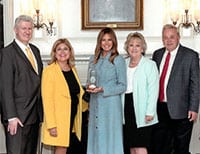
In 2019, the American Egg Board combined its standing Easter Marketing Campaign with its efforts related to the White House Easter Egg Roll into a newly named WH-Easter program. As part of this effort, a selection of previous Commemorative Eggs were recreated and shared collectively for the first time.
For the 42nd year, the American Egg Board, on behalf of America’s egg farmers, presented the First Lady’s Commemorative Egg. The design of the 2019 egg was inspired by submissions from children of America’s egg farmers across the country!
Creation of the egg was truly a collaborative effort. Inspired by the children’s submissions, Mac Wilcox of Energy BBDO created the vision for the egg’s final design. Jessica Jones of Alias Quilling and Crafts expertly created the quilling elements. Cecilia Glembocki, Executive Director of the Virginia Egg Council and a skilled egg artist, was given the honor of executing this year’s egg, which is an extra-large chicken egg, blown out and decorated with painstaking precision and detail.
More than 30,000 families attended the 141st White House Easter Egg Roll. America’s egg farmers donated a record-breaking 74,000 eggs used for the iconic egg roll, egg decorating and EggPops, a South Lawn tradition.
2018
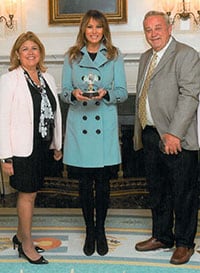
In addition to presenting the 41st First Lady’s Commemorative Egg, America’s egg farmers donated 30,000 hard-boiled and dyed eggs for attendees to enjoy as EggPops and use for in the Egg Roll, itself. Children and parents also experienced the Hen to Home exhibit that highlighted how eggs move from today’s farms to our tables.
Master Egg Artist Deborah Grassel was inspired by the First Lady whose elegance comes to life in the ornate nature of the design which is adorned in rhinestones. Beautiful angel wings open to expose an intricate scene with a handmade bridge, where if you look closely, you can see a Koi fish swimming in the water.
Grassel, who resides in Austin, Texas, has 21 years of egg artistry experience and has created more than 400 eggs — with one break — in her career.
2017
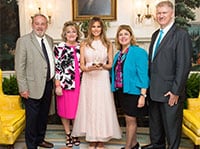
The 2017 First Lady’s Commemorative Egg is an extra-large egg that artist Linda Gaus Asbell of Denton, Texas, carved, painted and then decorated with red, white, blue and gold Swarovski crystal. Her mother designed the 2001 Commemorative Egg for Laura Bush.
America’s egg farmers also donated more than 30,000 REAL hard-boiled eggs for egg rolling, the egg hunt, egg decorating and egg snacking, a first on the South Lawn. The AEB also brought the egg production process to life for the parents and children attending through AEB’s whimsical “An Egg’s Journey from Farm to Table Eggsperience.” All volunteers also wore the hats and aprons featuring both the event and incredible logos.
2015

Artist Judith Linstruth of Garfield, Ark., designed the 38th Commemorative Egg. Made from a large chicken egg, Linstruth made three cut-outs and lined each with gold bead chain. She then created a diorama of the day’s events inside the egg shell with the White House as the background and the South Lawn’s activities in the foreground. She coated the shell with epoxy for added strength and then added several coats of acrylic paint and a satin finish sealer. By hand, Linstruth painted the lettering on the back with a touch of crystals to symbolize the American flag, which also appears at the base with a pair of Bald Eagles.
2014
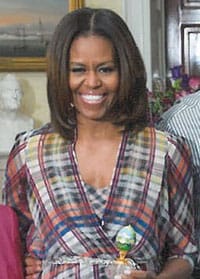
Award-winning artist Linda Rossin has created masterful fine art miniatures throughout her career, but this was only the second time that she worked with acrylic paints on a real egg. The 2014 First Lady’s Commemorative Egg highlights the delight of children during the Easter season and their perspective of Easter that includes colored eggs, Easter baskets, and the thought of cuddly bunnies and fuzzy chicks.
2013

America’s egg farmers continued their tradition of supporting the White House Easter Egg Roll by donating more than 14,000 hard-boiled and dyed eggs for event. The day’s activities — themed “Be Healthy, Be Active, Be You!” — include live music, sports courts, cooking stations, storytelling and, of course, Easter egg rolling. Building on this theme, Incredible jump ropes are the activity prizes at the Eggtivity Zone on the South Lawn. Thousands stopped by the Incredible Egg, a 16-foot inflatable egg, and the three incredible photo cutouts before heading to the South Lawn.
Award-winning artist Brian K. Baity of Wet Valley City, Utah, used a brown egg for the starting point of this year’s design. For the first time, the design featured the White House Easter Egg Roll’s logo. Baity incorporated his signature lattice pattern, and the quote along the egg’s bottom emphasizes the need for continued art education.
2012
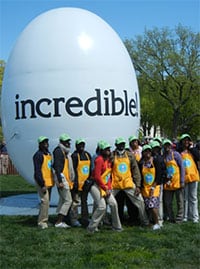
Louisiana artist Penny Smith found inspiration for the outside of the 35th Commemorative Egg from Washington, D.C., and its famous cherry blossom trees. The inside showcased children in action outdoors, which was inspired by the theme of this year’s White House Easter Egg Roll, “Let’s Go, Let’s Play, Let’s Move.”
Made from a large chicken egg, the bottom and top are hinged to open. The inside showcasing children in action outdoors was inspired by the theme of this year’s White House Easter Egg Roll and the “Let’s Move” campaign. Smith created the tree from wire and tissue, which she then painted. To accomplish the porcelain finish, she applied nine coats of sealer and did lots of wet sanding. In total, Smith spent more than 30 hours creating this year’s egg.
The American Egg Board continued its tradition of supporting the White House Easter Egg Roll by donating 14,040 hard-cooked and dyed eggs for egg rolling. AEB also provided the volunteers with hats and aprons. Themed “Let’s Go, Let’s Play, Let’s Move,” the day’s activities helped educate families on smart ways to incorporate healthy eating and exercise choices into their daily routines. To kick off the event, thousands of people stopped by the Big Egg, a 16-foot inflatable egg, and the Incredible Egg Chair to take their pictures before heading to the South Lawn for the egg roll, cooking demonstrations, musical performances and more.
2011
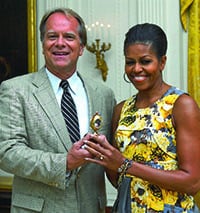
Atlanta artist Luanne White Faulkender, president and CEO, Theatre Techniques for Executives LLC, created the 34th Commemorative Egg that took 65 hours to create from concept to finish. Belonging to a military family herself, Faulkender depicted military families, a cause close to the First Lady, on the egg.
This large chicken egg is finished in gold leafing with Swarovski’s aurora borealis crystal and pearl chains. A picture of the First Lady is framed on the outside of the center door with the National Military Family Association logo placed on the door to her left and the five branches of service patches also appear. The finial is created with a sterling silver and gold bald eagle’s head, aurora borealis crystal and red, white and blue ribbons with “God Bless our Military Families” written on them.
This reproduction of the original egg, by Debbie Botts Poster, features American servicemen and women, including April Holmes currently serving Air Force. The other servicemen shown were killed in action while proudly serving their country: Blake Evans – KIA Army 5/25/08; Michael Kaske – KIA US Navy 10/5/08; James McClamrock – KIA Army 9/7/10; and Eric McKinley – KIA Army National Guard 6/13/04.
2010
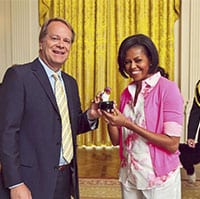
Carved using a high-speed drill, this large chicken egg features 100-percent hand-made adornments reflecting the interests and passions of the First Lady. The American flag represents her strong support of America’s military families and of their national service. Two stunning flowers, the Rodeo Rose and Mango Calla Lilies, appear front and center in its design. Both flowers are reportedly among the First Lady’s favorites. Representing her passion for proper nutrition, especially for American children, fruits and vegetables are mingled within the flowers. Strands of red, white and blue complete the design. The luminary-style egg reads: In God We Trust. Hope lives in us.
Laura Schiller, who has been creating eggs for more than 14 years, took great pride in creating this piece for the White House. Her design incorporates three basic elements — an eggshell, clay and glue. She notes the chicken’s egg is especially lovely for luminaries because its delicate shell offers a high glow, making for an impressive presentation. Schiller makes each piece from hand without using any molds. In fact, most of her carvings and cuts in to the shell are done by freehand. Married with two sons, Schiller has created hundreds of pieces in her career.
AEB continued its tradition of donating 14,000 dyed and hard-cooked eggs for the White House Easter Egg Roll as well as the hats and aprons for volunteers.
2009

America’s egg farmers provided almost 11,000 colored eggs for both the Egg Roll and Egg Hunt and donated the volunteers’ hats and aprons for the event.
AEB leadership and AEB Chairman presented this egg, designed by Jennifer Stevens, to First Lady Michelle Obama. The scene inside the eggs shows the First Daughters playing in front of the nation’s capital, a throwback to the first location of the nation’s Egg Roll.
2008
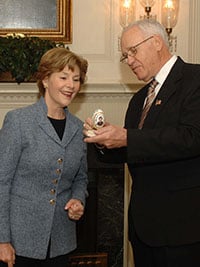
To honor this First Family’s last White House Easter Egg Roll, Phoenix-based artist Marsha Rossell used an extra-large chicken egg as a diorama to showcase the day’s namesake event: the Egg Roll. The state flower of Texas — bluebonnets — adorn the egg. Rossell created eggs representing Arizona for a display of 51 eggs at the White House Visitor Center in both 2004 and 2007. The Egg Roll, itself, is simply a race that takes place during the day’s festivities where children push an egg through the grass with a long-handled spoon.
2007
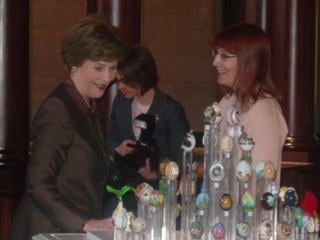
The 2007 Commemorative Egg highlights the critical role of literacy and education played during the First lady’s tenure in the White House. During this time, she created the National Book Festival and later her foundation was created to support America’s libraries.
The American Egg Board continued its tradition of the White House Easter Egg Display for the 2007 Easter season. Egg artists decorated one egg for each state, plus Washington, D.C., that brought the artists and America’s egg farmers together with the First Lady.
2006
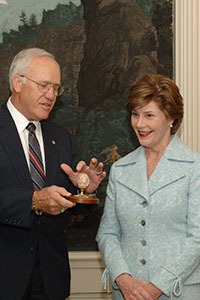
This brown egg was hand-etched and carved using a high-speed dental drill. On the front side of the egg, the Presidential Seal is etched and appears on a stage with curtains and Corinthian columns, representing Washington, D.C. On the opposite side is a stack of books and an open book on a pedestal, also on a stage with curtains and Corinthian columns and rays emanating from the open book that represent the power of knowledge. The banner above the book reads “Ex Libris Bush” meaning “From the Bush Library.” The crown of the egg has thirteen stars for the original 13 colonies. The stage itself represents our life and the role we each play on that stage.
2005

Stewart Poulsen, from Longview, WA, created the 2005 Commemorative Egg. After a 40-year career as a carpenter and cabinetmaker, he retired, and after seeing pictures of decorated eggs, Poulsen took up the craft. The blue accents reflect the First Lady’s favorite color. An oval cutout surrounded by cut lattice work, blue crystals and miniature silk pansies adorns the front of the egg. Inside, a tiny Easter Bunny sits on the grass surrounded by delicate decorated Easter eggs. Additional lattice work framed by pansies forms the back of the egg. Blue crystals decorate each petal. The handcrafted stand with a finial of blue crystal is attached to a Corian base.
2004

America’s egg farmers donated more than 7,000 dyed eggs for rolling. A display was also coordinated for the month of April at the White House Visitor Center, featuring decorated eggs from each of the 50 states plus the District of Columbia.
Rhode Island artist Joan Klatil Creamer celebrates the themes of family, tradition and country through this miniature creation of The White House and grounds that blossoms into a recreation of The Oval Office — all within the shell of an egg.
Details within the egg include parquet floor that features a cloth replica of the Presidential seal rug and stained wood desk and side cabinets. The décor of The Oval Office recreates items used within the office during this time period. The two white tapestry couches are fimo clay. The exterior shows a flag made with Swarovski crystals. First Family portraits and cluster of aptly named petunias complete the look. The protective case featured metal-etched cherry trees that overlook the South Lawn activities. Dozens of Easter eggs are included, as are the First Family’s pets.
2003
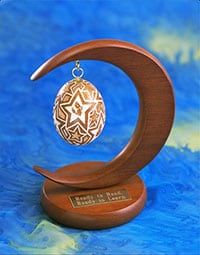
Selected by the artists who designed the 2002 State Egg Display at the White House, Gloria Fine designed The First Lady’s Commemorative Egg. Fine grew up in Rockford, IL, and from an early age knew that she wanted to be teacher.
Her inspiration for the egg came from this love of teaching, drawing her immediately to the First Lady’s literacy campaign as a theme for the egg, deciding on the wish that all children will read to illustrate the campaign. The egg features the silhouettes of children reading inside carved stars. The wooden stand, in the shape of a crescent moon, further emphasizes the idea that the First Lady is wishing on a star. “Ready to Read, Ready to Learn.” The slogan of the reading initiative is engraved on the stand.
2002
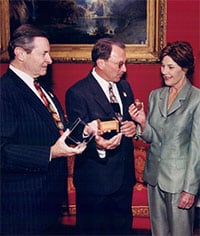
America’s egg farmers provided both the made-in-the-USA hats and aprons for all the volunteers, as well as the eggs for both hunting and rolling at the White House Easter Egg Roll.
AEB leadership and chairman Richard Simpson of North Carolina made the presentation of the First Lady’s Commemorative Egg. Wisconsin egg artist Paula Hare used her unique cloisonné enamel painting on 2002’s egg. The egg depicts a colorful bouquet of violet, red and magenta petunias symbolic of the namesake petunias of the First Lady that were developed by Texas A&M. Leaves and grasses in rich shades of green and teal complement the flowers to perfection.
2001
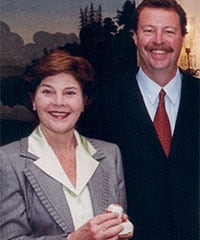
America’s egg farmers donated more than 7,000 eggs for Egg Rolling on the South Lawn. For the eighth year, a decorated egg display, comprised of an egg from each state and the District of Columbia, was requested by the White House and available for viewing by the public during the Easter season.
AEB leadership presented this decorated chicken egg by Texas egg artist Beverly Gaus to the First Lady Laura Bush. The egg features crystal beads to create both the U.S. and Texas flags on the outside of the egg and featured a kaleidoscope chamber with Texas images on the inside. The base was a Texas-shaped limestone, which was carved from a piece of the San Jacinto monument.
2000
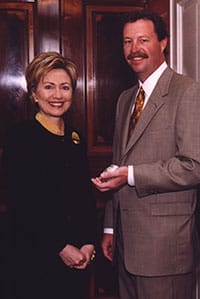
This Faberge-style egg named “Doors and Windows” by Natalie Stedman of Canandaigua, NY, features the First Lady’s favorite color blue. A bejeweled door opens into the artist’s interpretation of the First Lady’s office. The tiny teddy bear represents her interest in children, the medical symbol her concern for health care, and the pictures on the wall her support for the arts. The accompanying presentation box, also done in blue, is fully lined and crowned with a lovely bow.
Stedman, a graduate of the Pratt Institute School of Design, Fashion Division, in New York City, has worked with top designers, authored two books and numerous articles on Egg Decorating and associated crafts, and conducted a variety of lectures and seminars. She operated her own art studio for 30+ years, teaching classes and creating eggsceptional jeweled designs.
1999
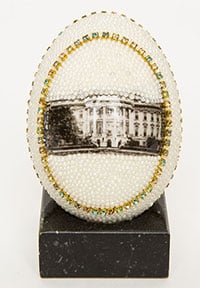
On Easter Monday, April 5, 1999, AEB leadership presented First Lady Hillary Clinton with this egg that features 2,500 no-hole pearls, meaning each one was glued one at a time. Artist Kaye Faraca, who was president of the International Egg Art Guild at the time, lives in Crooked River Ranch, Oregon, overlooking the Cascade Mountains. The picture of the White House was modeled after the picture on the back of a $20 bill. The back of the egg featured the year.
For the sixth year, the American Egg Board coordinated a display of 51 individually decorated eggs, representing each state and Washington, D.C. Each state artist highlighted his/her state’s history, culture and/or landmarks. These eggs appeared in the East Wing of the White House from mid-March until two weeks after Easter.
1998
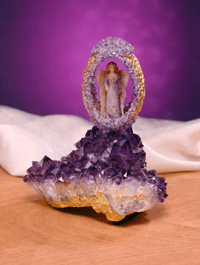
To celebrate the 120th White House Easter Egg Roll, this year’s egg represents favorites from both the First Lady and First Daughter. Florida artist Colleen Findley designed and created the gold-and-jewel encrusted egg, embracing a graceful angel. American egg farmers also donated 7,200 hard-boiled eggs dyed by the White House kitchen staff for this annual event.
1997
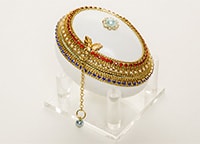
This year’s egg was adorned with jewels on the outside and opened to reveal a representation of a “Bridge to the 21st Century.”
Designed by Birgit Dillard of Sacramento, California, this large chicken egg also included the landmarks of Washington, D.C., on the inside of the shell. Additionally, America’s egg farmers coordinated a display of 51 individually decorated eggs, showcasing each state’s key
1996

This year’s egg was adorned with jewels on the outside and opened to reveal a representation of a “Bridge to the 21st Century.”
The American Egg Board coordinated a display of eggs from each state, plus Washington, D.C., that highlighted unique characteristics and well-known landmarks. This is the last of three eggs very similar in appearance; the first was presented to Nancy Reagan in 1988, and the second to Barbara Bush in 1991.
1995

From mid-March through April, the AEB coordinated a display of 51 individually decorated eggs representing each state and Washington D.C., which were displayed in East Wing of the White House. The Thursday before Easter, AEB delivered eggs for dyeing to the White House kitchens. The presentation was made by AEB CEO Lou Raffel and AEB Chairman. The 18th Annual First Lady’s Commemorative Egg was designed by Czech artist Peter Sis, on behalf of America’s egg farmers.
1994
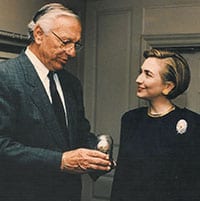
This First Lady’s Commemorative Egg evokes fond memories of the First Lady’s childhood in Park Ridge, IL. Joseph De Velasco, a longtime Park Ridge resident, highlighted three historical landmarks from Park Ridge. From 1961 until his passing in 1999, he worked as a freelance artist and fine artist painter, working for a variety of Chicago’s major advertising agencies.
In 1994, the American Egg Board also coordinated a display of 51 individually decorated eggs. Each of the 50 states, as well as Washington, D.C., provided a decorated egg that represented each state’s most recognized feature. This display appeared in the East Wing of the White House from early March through mid-April.
1993
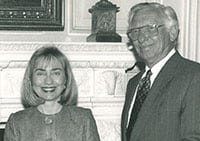
Starting in 1993, the presentation of the First Lady’s Commemorative Egg coincided annually with the White House Easter Egg Roll, traditionally held Easter Monday. Until this time, the presentation was held in the spring around Easter but not always on Easter Monday.
The 16th annual First Lady’s Commemorative Egg was executed in partnership with the Arkansas Poultry Federation. Designed by Sharon Boyd-Struthers, the design reflects the First Lady’s interest and concern for children’s issues and features the message, “A child is like an egg — both are equally fragile, neither is easily pieced together again.” Both the First Daughter and First Cat, Socks, are represented walking through a field of wildflowers, a landscape scene found over much of Arkansas.
1992
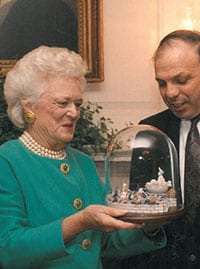
AEB leadership presented this Commemorative Egg on Easter Monday, April 20. Eggs were also donated for rolling on the South Lawn. Using a large chicken egg as a perch for the Easter Bunny surrounded by eggs, the artist created an entire scene from the South Lawn. This includes many of the actual blooming plants that appeared during the event for children from across the country. The epoxy used to coat the egg also added weight to help stabilize the egg.
1991
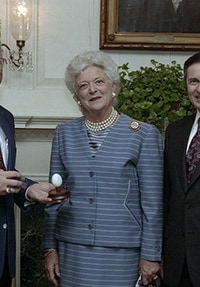
For the second time, artist “LS” used a specialized tool to carve this large chicken egg with designs of both the American flag and roses. The hollowed‐out design allows for light to shine through the egg. AEB provided eggs to the White House, and AEB met with Barbara Bush again to present the 14th annual First Lady’s Commemorative Egg.
1990
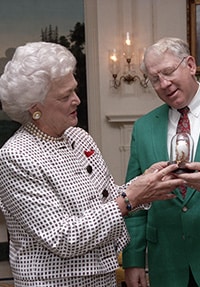
This diorama-style egg was presented by AEB’s President and Chairman on Easter Monday inside the White House as attendees enjoyed the South Lawn for the annual Easter Egg Roll. AEB also provided the eggs used for Egg Rolling and provided volunteers for the day’s activities. On the outer rim of the egg, the light rose jewel chain compliments the dogwood flowers on the inside.
1989
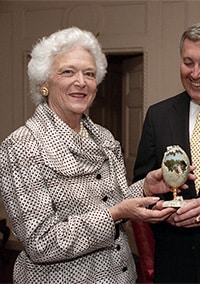
The egg was created by Milwaukee, Wis., artist Donna Marie Runge, who specializes in intricately decorated eggs. The eggshell is dyed pale blue and trimmed with pearls. A scene from an antique postcard (circa 1909), showing children at an egg hunt, decorates the back of the egg.
Beneath is inscribed “White House Easter Egg Roll, 1989. The Year of the Young Reader.” The beautiful flowers covering the rest of the egg and the base are “forget-me-nots,” chosen so this occasion will be long-remembered. A total of 14 coats of finish have been applied to the egg’s surface to strengthen and protect it. The scalloped opening in the thick shell was cut with a diamond drill. The no-hole pearls were applied one at a time. Both the blue hues of the egg and pearls were inspired by Barbara Bush’s first public comments as First Lady.
AEB leadership presented this egg to First Lady Barbara Bush on Easter Monday, Easter 27, 1989. Additionally, more than 5,000 eggs were delivered to the White House kitchen staff who hard-boiled and dyed them.
1988
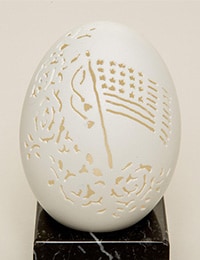
This is the first of three similar Commemorative Eggs that were carved by the same artist for three different First Ladies. This egg was pierced to depict a spray of roses and an American flag. AEB leadership presented this egg to the First Lady on March 25, 1988. This gift remained in the First Lady’s Projects Office until the end of this Administration.
1987
On April 20, 1987, a record breaking 37,000 people attended the White House Easter Egg Roll that took place on the Monday following Easter, known as Easter Monday. America’s egg farmers attended the day’s events and provided the eggs used in the namesake egg roll.
1986
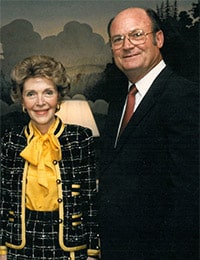
The Chairman of the American Egg Board presented the First Lady with a Commemorative Egg on behalf of America’s egg farmers. Again, egg farmers were proud to support this annual tradition with hard-boiled eggs and volunteers on the South Lawn throughout the day. This is the 10th annual First Lady’s Commemorative Egg presented on behalf of America’s egg farmers.
1985
The 107th White House Easter Egg Roll includes the iconic Egg Roll with eggs donated the American Egg Board, the marketing arm for all U.S. egg farmers. Popular children’s characters, including Kool-Aid Man, Spider-Man Rainbow Brite and Papa Smurf, and star athletes like Joe Theismann and Cathy Lee Crosby mingled with more than 30,000 attendees from across the country in attendance.
1984
Due to extreme rain and for the first time since the creation of the American Egg Board, the 1984 White House Easter Egg Roll was canceled. The South Lawn and the park land surrounding the White House, which is approximately 82 acres and includes various statues, memorials and structures, is carefully managed by the National Park Service. Efforts related to WWI and WWII were reasons for past cancellations. White House renovations from 1948 to 1952 turned the South Lawn into a construction zone.
1983
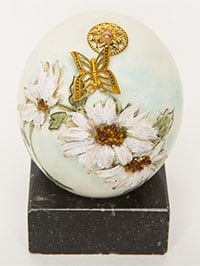
America’s egg farmers again donated eggs for the iconic Egg Roll itself. BUT what is the actual Easter Egg Roll? The Egg Roll, itself, is simply a race that takes place during the day’s festivities where children push an egg through the grass with a long-handled spoon. Each year, the activities vary.
Egg artist Geri Meyer of Wauconda, IL, created the 6th annual First Lady’s Commemorative Egg. The flowers are layers of paper meticulously layered upon each other for the First Lady. She is a life-long egg artist.
1982
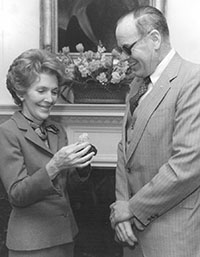
The First Lady’s Commemorative Egg for 1982 uses a large chicken egg that was hollowed out. Wauconda, IL-based artist Geri Meyer applied an early 1900 Victorian-inspired postcard image to the egg with various layers of glue. She then carved the egg using a high-speed dental drill. The gold filigree along the base and banner adds excitement to the design. Meyer’s own handwriting captures the year and event.
Both the America Egg Board’s Chairman and CEO made the presentation to First Lady Nancy Reagan on Easter Monday, April 5, 1982.
1981
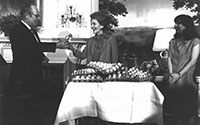
The 1981 Commemorative Egg for the First Lady Nancy Reagan was decorated by Linda Szilvasy of Exclusive Designs, based in El Paso, Texas. Szilvasy specializes in intricately designed eggs and bejeweled this egg with opals, turquoise, emeralds and lapis lazuli in royal blue.
The Mancus Foundation for the Physically Handicapped in Wilmington, Delaware, also decorated more than 50 dozen hard-cooked eggs that were donated by AEB to celebrate the United Nation’s International Year of the Disabled Person. Additionally, Pysanky or Ukrainian-style Easter Eggs were part of the presentation display.
1980
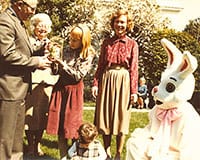
On March 28, 1980, both First Daughter Amy Carter, 12, and her nephew, James Earl Carter IV, 3, received Easter eggs in the White House East Garden, on behalf of the American Egg Board. For the White House Easter Egg Roll that took place the following Monday, America’s egg farmers donated 40 dozen Easter eggs for activities on the South Lawn. The image taken from the presentation to both Amy and Rosalynn Carter was a silk print then applied to a blown-out egg with added embellishments.

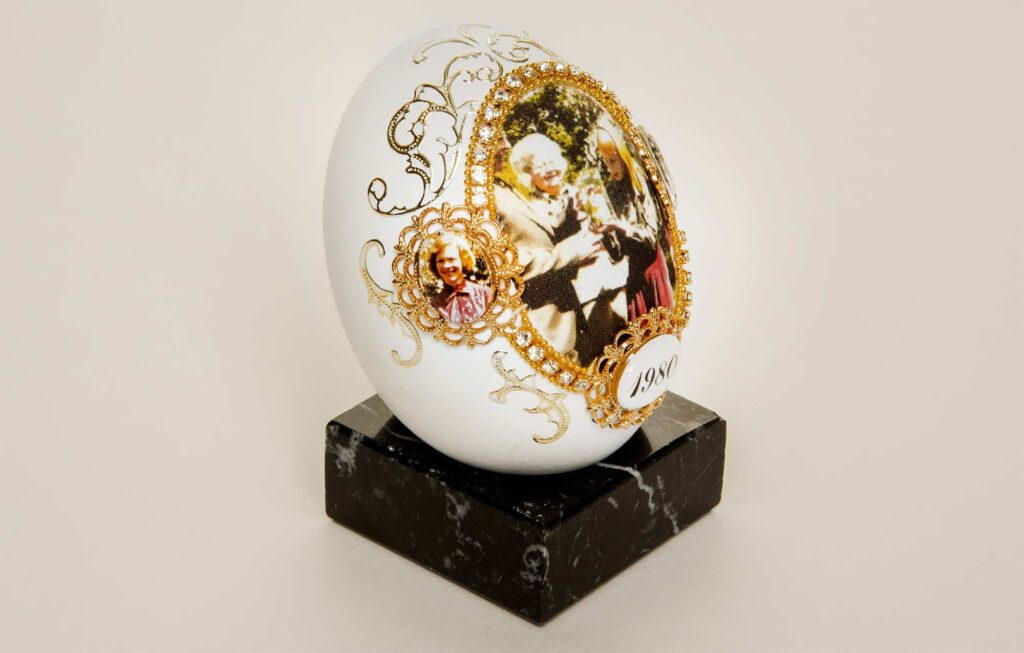
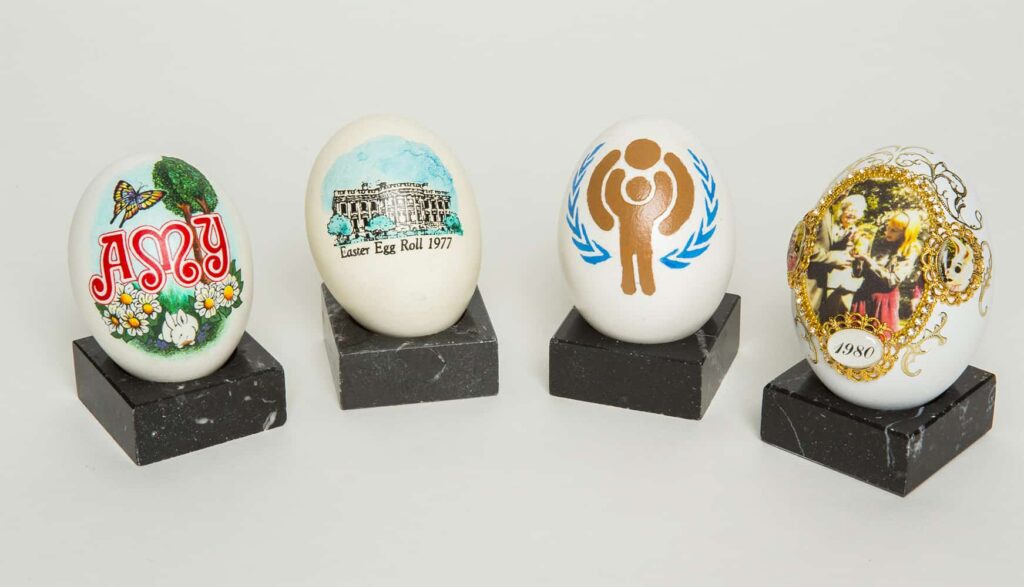
1979
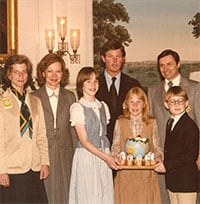
On behalf of the nation’s children, First Daughter Amy Carter, alongside her mother, accepted accepted a special Easter arrangement commemorating the International Year of the Child. Elizabeth Quainton and Justin Smith, both of Washington, D.C., presented Amy with painted eggs depicting the world’s children, with a cut-away globe as an Easter basket. America’s egg farmers donated 20 dozen Easter eggs for egg rolling on the South Lawn.
1978
At the White House’s request, state promotional organizations from across the country each supplied one dozen decorated eggs to be used during the Egg Roll Competition; this was the second year that REAL eggs returned to the South Lawn. New York judged 140 entries from Albany area schools and sent 12 to Washington, DC; the rest were displayed locally. A school in Austin, Texas, turned the experience into an embryology project. Minnesota’s governor decorated eggs while executives of the Minnesota Egg Council looked on. Missouri’s decorated eggs were signed by its governor. And children’s hospitals in Connecticut, Kentucky, Maine, South Dakota and Virginia all decorated eggs.
1977
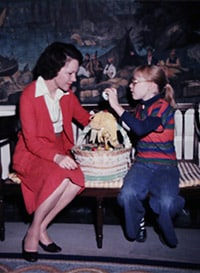
For the first White Easter Egg Roll, following the creation of the American Egg Board, REAL eggs returned to the South Lawn for egg rolling and activities. America’s egg farmers also presented the First Daughter Amy and First Lady Rosalynn Carter with the first-ever Commemorative Egg. State promotional organizations also organized local egg decorating activities for children across the country. These eggs were used on the South Lawn as well. In Atlanta, more than 300 children at the children’s hospital, where the First Lady is a lifetime auxiliary member, decorated eggs that were used on the South Lawn.

